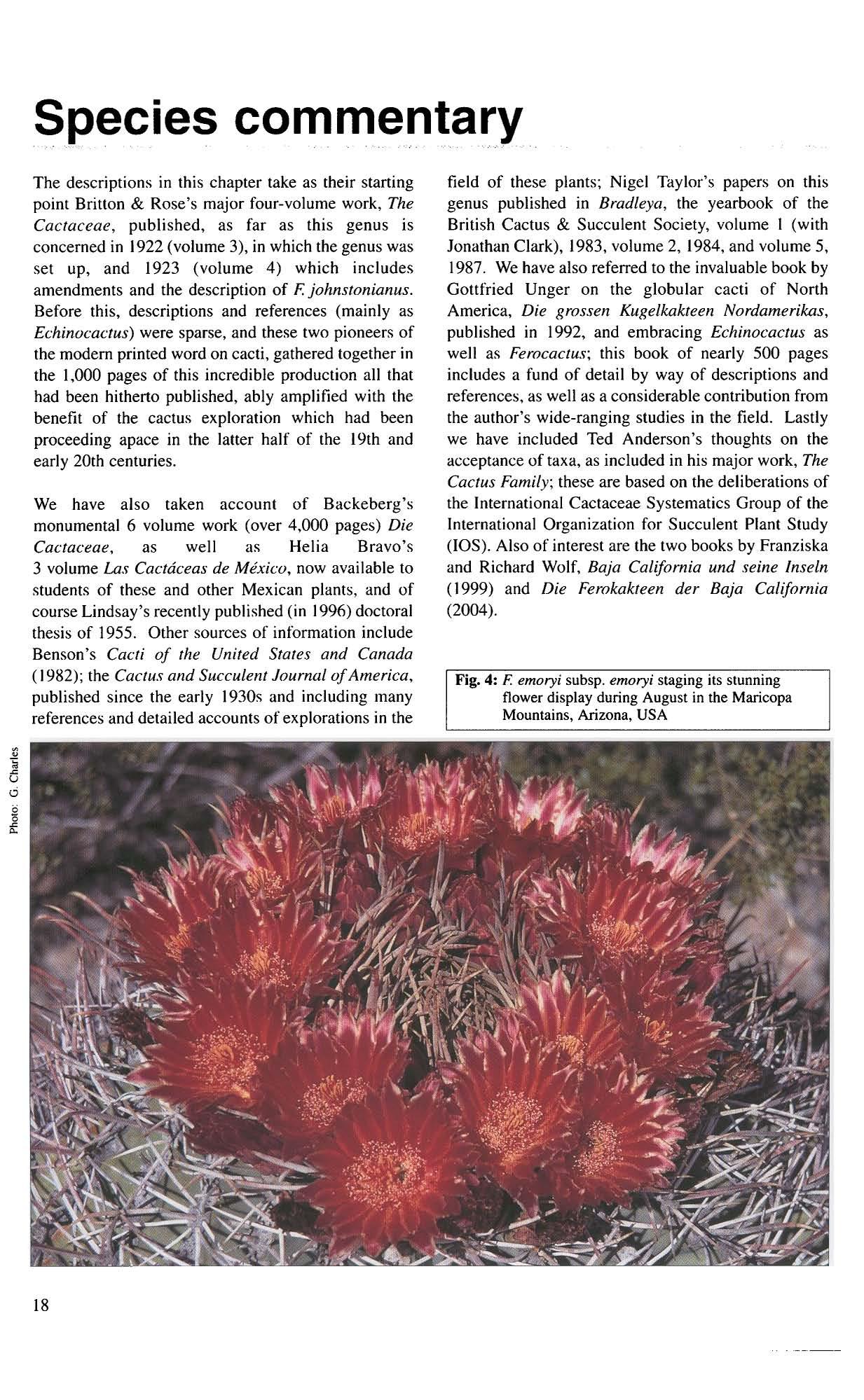
141 minute read
Species commentary
from Ferocactus
by Ammar
The descriptions in this chapter take as their starting poim Britton & Rose's major four-volume work, The Cactaceae, published. as far as this genus is concerned in 1922 (volume 3), in which the genus was set up. and 1923 (volume 4) which includes amendments andthe description of F. johnstonianus. Before this, descriptions and references (mainly as Echinocactus) were sparse, and these two pioneers of the modem printed word on cacti, gathered together in the 1.000 pages of this incredible production all that had been hitherto published, ably amplified with the benefit of the cactus exploration which had been proceeding apace in the latter half of the 19th and early 20th centuries.
We have also taken account of Backeberg's monumental 6 volume work (over 4.000 pages) Die CQ£:taceae. as well as Helia Bravo's 3 volume Las Cactaceas de Mexico, now available to students of these and other Mexican plants, and of course Lindsay's recently published (in 1996) doctoral thesis of 1955. Other sources of information include Benson's Cal:ti of the United States and Canada (J 982); the Cactus and Succulent Journal ofAmerica. published since the early 1930s and including many references and detailed accounts of explorations in the field of these plants; Nigel Taylor's papers on this genus published in Bradleya, the yearbook of the British Cactus & Succulent Society. volume I (with lonathan Clark), 1983, volume 2,1984, and volume 5, 1987. We have also referred to the invaluable book by Gottfried Unger on the globular cacti of North America. Die grossen Kugelkakteen Nordamerikas, published in 1992, and embracing Echinocactus as well as Ferocactus; this book of nearly 500 pages includes a fund of detail by way of descriptions and references. as well as a considerable contribution from the author's wide-ranging studies in the field. Lastly we have included Ted Anderson's thoughts on the acceptance of taxa, as included in his major work, The Cactus Family; these are based on the deliberations of the International Cactaceae Systematics Group of the International Organization for Succulent Plant Study (lOS). Also of interest are the two books by Franziska and Richard Wolf, Baja California und seine Inseln (1999) and Die Ferokakteen der Baja California (2004).
Advertisement
Fig. 4: F. emoryi subsp. emoryi staging its stunning flower display during August in me Maricopa Mountains, Arizona. USA
Ferocactus alamosanus
This beauliful species (both the type and subsp. reppenhaMenii) grows well in cullivation, and flowers when quite small, at about 15 10 20cm in diameter, but this could take 10 to 15 years from seed 10 achieve as the rale of growth is fairly slow.
F. alomasumls was listed in Taylor's revision of 1984 as a variety of F. pot/sil. following Unger's reduction in 1971. but in the latest listing of the CITES CacUlceat! Checklist (J 999) it is included as a good species. and F. reppenhagenii is listed as a subspecies hereunder. having previously been so reduced by Nigel Taylor in 1998. The more southerly occurring subsp. reppenhagenii bears a marked resemblance (0 F. alamosanus, and its reduction here makes good sense, extending the range of this species considerably.
Ferocactus alamosanus subsp. alamosanus
This. the type, is <l much smaller growing plant than F pOllsii (with which it has previously been coupled). with more ribs th<ln that species in youth. and it is a much more spiny plant altogether, and with a quite different aspect. Its main feature is the slriking, straight, yellow spines sticking out protectively like a sea-urchin, and because of these it is difficult 10 handle when repotting without damage to the spines or for that mailer yourself. See the advice on reponing these spiny plants in the chapter on cultivmion.
It was described as having a solitary stem or sometimes clustering, to 30cm or more tall, half to tW<Hhirds as wide, at first with <lhout 13 ribs, later to about 20 narrow, acute ribs. Spin<ltion is all yellow, red at Ihe base in youth, radial spines usually about 10, seldom II or only 8 or 9,3 to 4cm long, later 10 5cm. There is a single central spine, porrect or erect, somewh<lt flattened laterally, to about 6cm long. Flowers are clear lemon yellow, the outer segments greenish-red at the tips. Fruit is bright red. Seed has not been described hitherto. but we can affirm thai it is about 1.8mm long. smooth. shiny black. Reported from Ihe Mexican states of CHIHUAHUA, SONORA. SINALOA; specifically from SONORA. high up in the Alamos Mounlains, Cienegita, Black Canyon at Guirocoba Ranch. east of Alamos. San Pedro, east of Alamos: from SINALOA, EI Saucito and Pitayitas, on the road from Badimhuato to Hidalgo del Parral, CHIHUAHUA; mostly on high vertical rocks, al 350I300m ahilUde.

Field collection numbers referred here are: holotype, Rose. Standley & Russell 12850 (US 535974); Lindsay without no. (DS); Lau 80. 1202; Reppenhagen 564, 2109a, 2112a.
Synonyms: Echinocuctus alamosanus, F pom'ii var. alamosonus
Section Bisnaga; F. glaucescens Group
Feroeaetus alamo,w1I1us (Britton and Rose) Brillon & Rose, The Caet. 3:137jig.145 (/922); I.e., Can/rib. US. Nat. Herb. 16:23,pl.66 (/9131 - as Echinacactas; Unger, Kakt.a.a.Sakk. 22(/0):187 (/97/) - as F. pOllsii var. alamosanus; G, Lyons,Caet. Suec. J, (US) 40(4): J38·139,jigs. 1,2 (/968); N. P. Taylar. Bradleya 2:36 (/984) - as F. pOllsii var. alamosanus; Unger, Die grossen Kugelkakt. Nordamer. 254 (/992) - as F. pOllsii var. a/amosanus; Lindsay, Ferocactus /23/26,139,438 (/996) (/955 thesis, anpablished at the time); Taylor in Hunt (ed.), Caet, Consensus Initiatives 6:15 (/998); Hunt (ed.), CITES Caet. Checklist 204 (/999); E. F. Anderson, The Cactus Family 327 (2oo/)
Ferocactus alamosanus subsp. reppenhagenu
As already mentioned, the similarity between this and the type is marked, and Taylor's recent amalgamation of the two formerly separate species is irrefutable; we just wish we had thought of it first.
This subspecies has been said to bear a superficial resemblance to Echinoeaetus grusonii, with the central spines pointing upwards instead of downwards, but few enthusiasts for Ferocactus are likely to confuse the two. It will flower at only about IOcm in diameter in cultivation, and this will immediately distinguish it from E. if there were any doubt, the laller rarely flowering at less than 6Ocm. The flowers if pollinated are followed by prominent, attractively coloured fruit. bright red when ripe, II is not yet widespread in cultivation, but seedlings have been available for thosewho seek out things new, and plants in cultivation raised from seed are more and more commonly seen, Flowering as it does at a small size its popularity is assured,
It was described as solitary, depressed·globose, columnar in age. to 80cm tall, 9 10 24cm in diameter, with 12 to 18 ribs, There are 7 to 9 radial spines, sometimes only 6 or up to I J, II (0 40mm long, yellow later grey. There is one central spine, somewhat curved at the tip, 28mm to 80mm long, yellow, reddish-brown at the base. Flowers are yellow to orange, 23mm long and wide, with yellow stigmas, Fruit is ovoid, bright to dark red, 15 10 22mm long, 8 to 17mm in diameter, juicy. Seed is 2 to 2.3mm long, reddish-brown to black, matt. very smooth. Rt:porLcd from the Me,ll,ican :slales of MICHOACAN, COLIMA, and OAXACA, on south-east and south-west facing slopes;type from MICHOACAN. Sabino near Dos Aguas, south-west of Apatzingan, at 2,300m altitude; also from MICHOACAN, Cerro Laurel, Coakoman, at 2,OOOm altitude; from COLIMA, Pueblo Nuevo, Cerro Barrigon, north-west of Ciudad Colima near Rancho Tecuan. at 2,OOOm; from OAXACA, at Yosundua. at 1,5OOm .hilUde.

Field collection numbers referred here are: Iype, Reppenhagen & Priessnitz, without no, (ZSS); Lau 765,1412; Rep. 662, 664, 6703, 72Od, 746•.
Synonym: F. reppenhagenii
Section Bisnaga F. glaucescens Group
References:
Fero("(1{.:tus alomosanus subsp. reppenhagenii (G. UI/ger) N. P. Taylor, Caet. Cnns. II/it. 6: 16 (1998); G. Unger, Kakt.u.a.Sukk. 25(3):50-54, (/974); SanchezMejnrada, Cact. Suc. Mex. 25(3):66 (/980); N. P. Taylor. Bradleya 2:23 (1984); Unger, Die grossen Kugelkakt. Nordamer. 407 (1992); Lindsay, Femcaetus 110, 325, 441 (/996) (/955 thesis, unpublished al the time); Unger, Kakt. u. a. Sukk. 50(//): (207) Kart.1999/19 (/999); E. F. AI/dersan, The Cactus Family 327 (2001)
Fig. 7 (opposile page): F. aJamosanus subsp reppenhagenii in Michoacan, Mexico
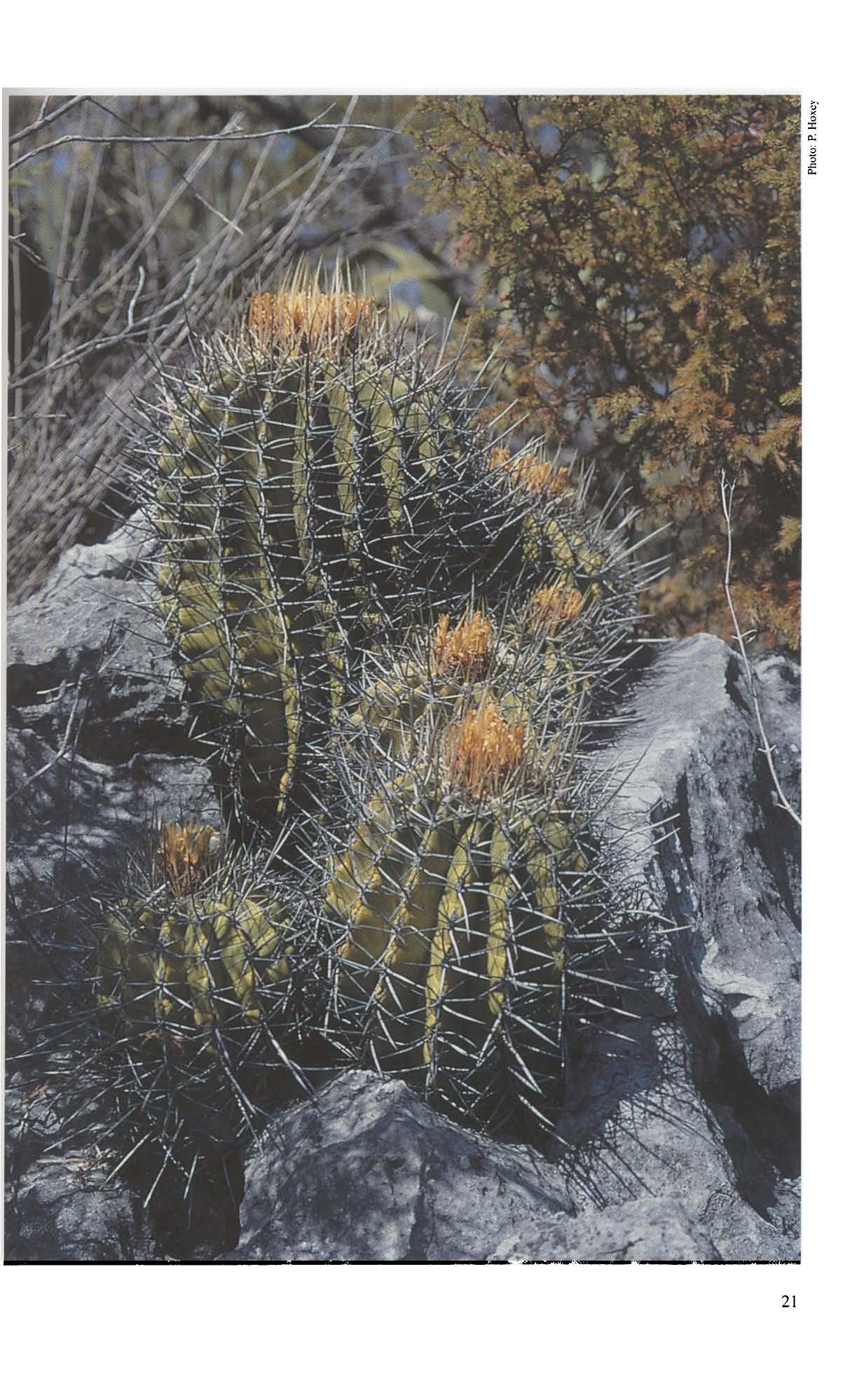
Ferocactus chtysacanthus
In the CITES Cactaceae Ched/isl (1999) Nigel Taylor took the bull by the horns and placed the controversial F. fordii vaT. grandiflorus under this species as a subspecies. which in view of its completely different habit from F. fordii, principally its much larger growth and orange flowers. also close proximity to F. chrysacanlhus (albeit with some sea between them), makes good sense. Unger in his book was of the opinion that it was a hybrid between F. fordi; and F. chrysacanthus. but in a piece on this species in the German Society's journal (February 2000) he noticeably has dropped the 'X', giving it species status. We were a little discomfited by photographs in the Wolfs' book showing plants on Isla Natividad, midway between the occurrence of subsp. grand;florus on the mainland of Baja California and Isla Cedros (the locality of subsp, chrysacanthus) showing distinctly purple flowers, not as Lindsay reported from this island as "red or orange", The Wolfs captioned these as F. x grandiflorus, but our feeling was thaI they seemed to owe more to F. ford;;; this seems to be backed up by Unger, who reports F. ford;; from Isla Natividad. In their 2004 book the Wolfs captioned these plants as F. ford;; confinning our opinion.
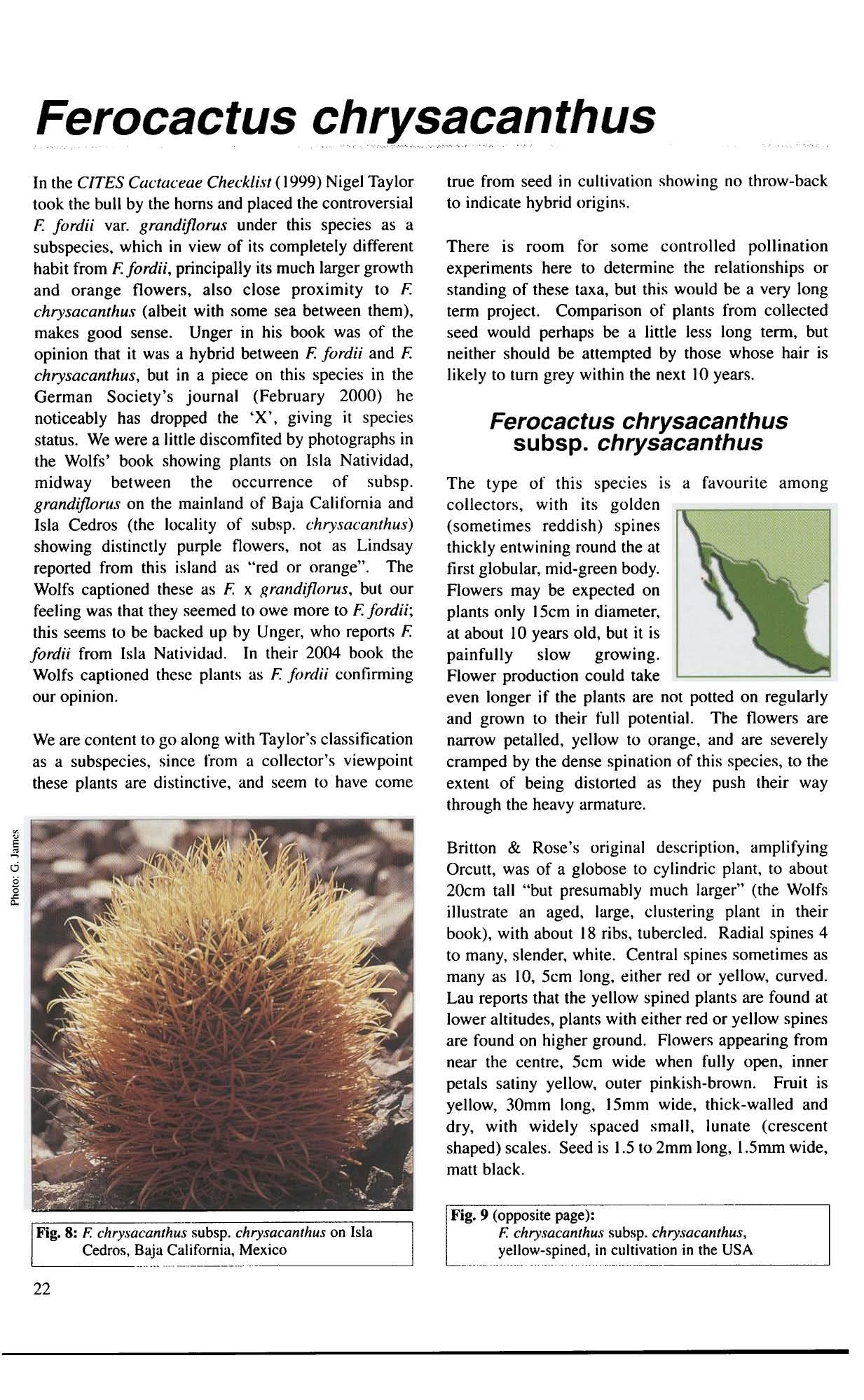
We are content to go along with Taylor's classification as a subspecies, since from a collector's viewpoint these plants are distinctive, and seem to have come true from seed in cultivation showing no throw-back to indicate hybrid origins.
There is room for some controlled pollination experiments here to determine the relationships or standing of these taxa, but this would be a very long term project. Comparison of plants from collected seed would perhaps be a little less long term, but neither should be attempted by those whose hair is likely to tum grey within the next 10 years.
Ferocactus chrysacanthussubsp. chrysacanthus
The type of this species is a favourite among collectors, with its golden (sometimes reddish) spines thickly entwining round the at tirst globular, mid-green body, Flowers may be expected on plants only 15cm in diameter, at about 10 years old, but it is painfully slow growing. Flower production could take even longer if the plants are not potted on regularly and grown to their full potential. The flowers are narrow petalled, yellow to orange, and are severely cramped by the dense spination of this species, to the extent of being distorted as they push their way through the heavy armature.
Britton & Rose's original description, amplifying Orcutt, was of a globose to cylindric plant, to about 20cm tall "but presumably much larger" (the Wolfs illustrate an aged, large, clustering plant in their book), with about 18 ribs, tubercled. Radial spines 4 to many, slender, white. Centralspines sometimes as many as 10, 5cm long, either red or yellow, curved. Lau reports that the yellow spinedplants are found at lower altitudes, plants with either red or yellow spines are found on higher ground. Flowers appearing from near the centre, 5cm wide when fully open, inner petals satiny yellow, outer pinkish·brown. Fruit is yellow, 30mm long, 15mm wide, thick-walled and dry, with widely spaced small, lunate (crescent shaped) scales. Seed is 1.5 to 2mm long, l.5mm wide, matt black.
Fig. 9 (opposite page): F. chrysacanthus subsp. chrysacanthus, yellow·spined, in cultivation in the USA
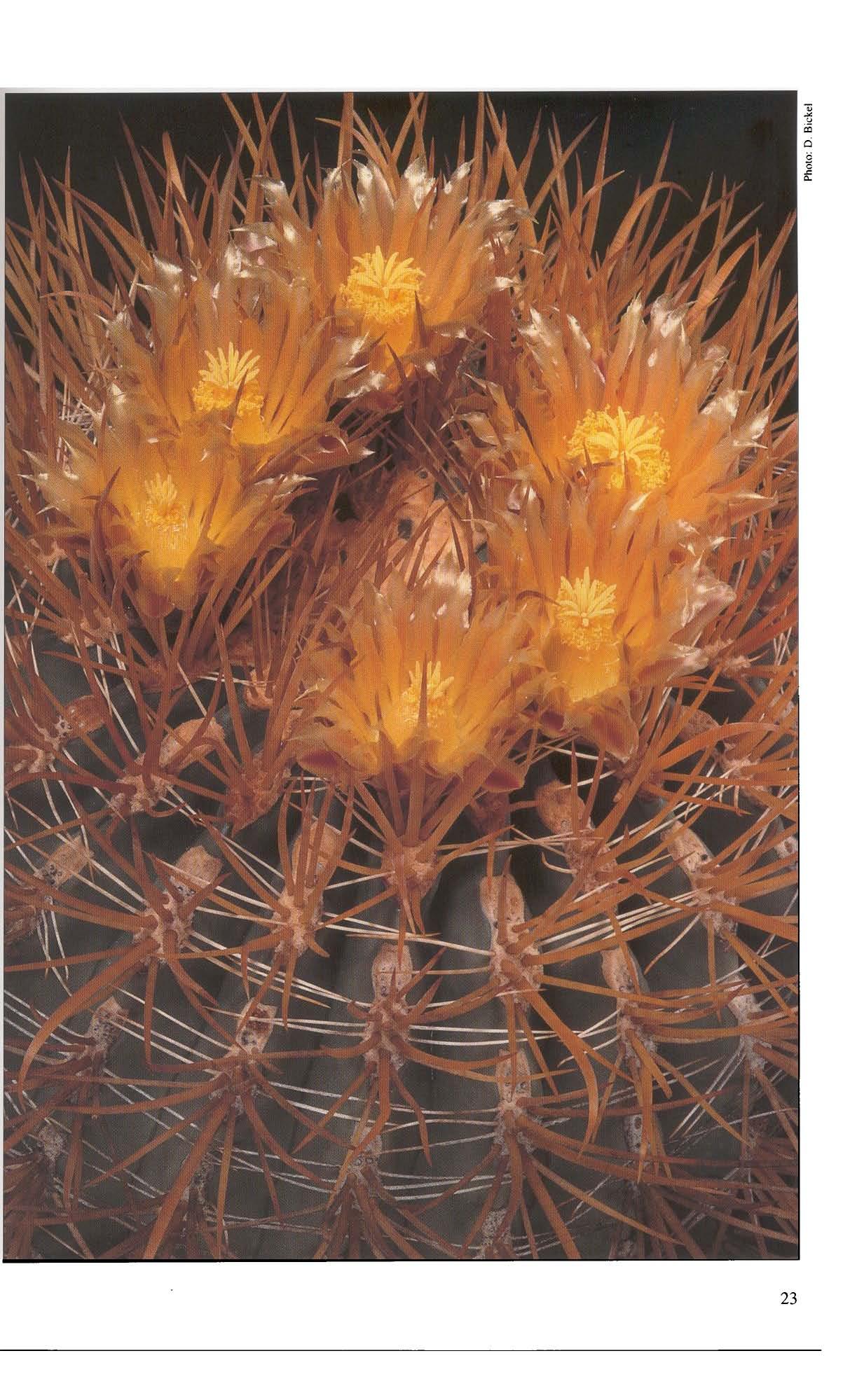
Taylor added to this somewhat and described the species as solitary, rarely clustering, to 1m lall, 30cm in diameler, with about 21 ribs, tuberculate; 22 or more spines. about 10 of which are central, curved and twisted, to about Scm long, yellow, rarely red, grey at higher. moisler localities. Flowers (appearing in June in the wild) are 45mm long, 40mm wide, yellow or orange, the petals with red midstripes, stigmas pink. Fruit is oblong-cylindric, yellow. 30mm long. 15mm in diameter. Seed is to 2.5mm long. black.
Sonia observed that the percentage of plants was very low: 95 per cent of plants in an area of about 100 square metres were yellow spined, I per cent were red. and 4 per cent reddish yellow. She added that. except for possibly damaged plants, all were solitary, mature plants mostly about 15 to 30cm in diameter and to 45cm tall, and plants as small as 10 or 12cm showed evidence of flowering.
Reported from Mexico, off northern BAJA CALIFORNIA on Isla Cedros and nearby San Benito islands among coastal scrub near sea level, to 500m altirude among pines; specifically from Cedros (the neotype) in an arroyo (dry riverbed) behind a village at the side of the island.
Field collection numbers referred here are: neotype, Lindsay 559 (DS); Rose 16091 (US); ). W. Tourney without no. (US); Rempel 331 (AHFH); Lau 010.
Synonym: Ec:hinocac/us chrysacan/hu.\'
Section Ferocactus F. robustus Group References:
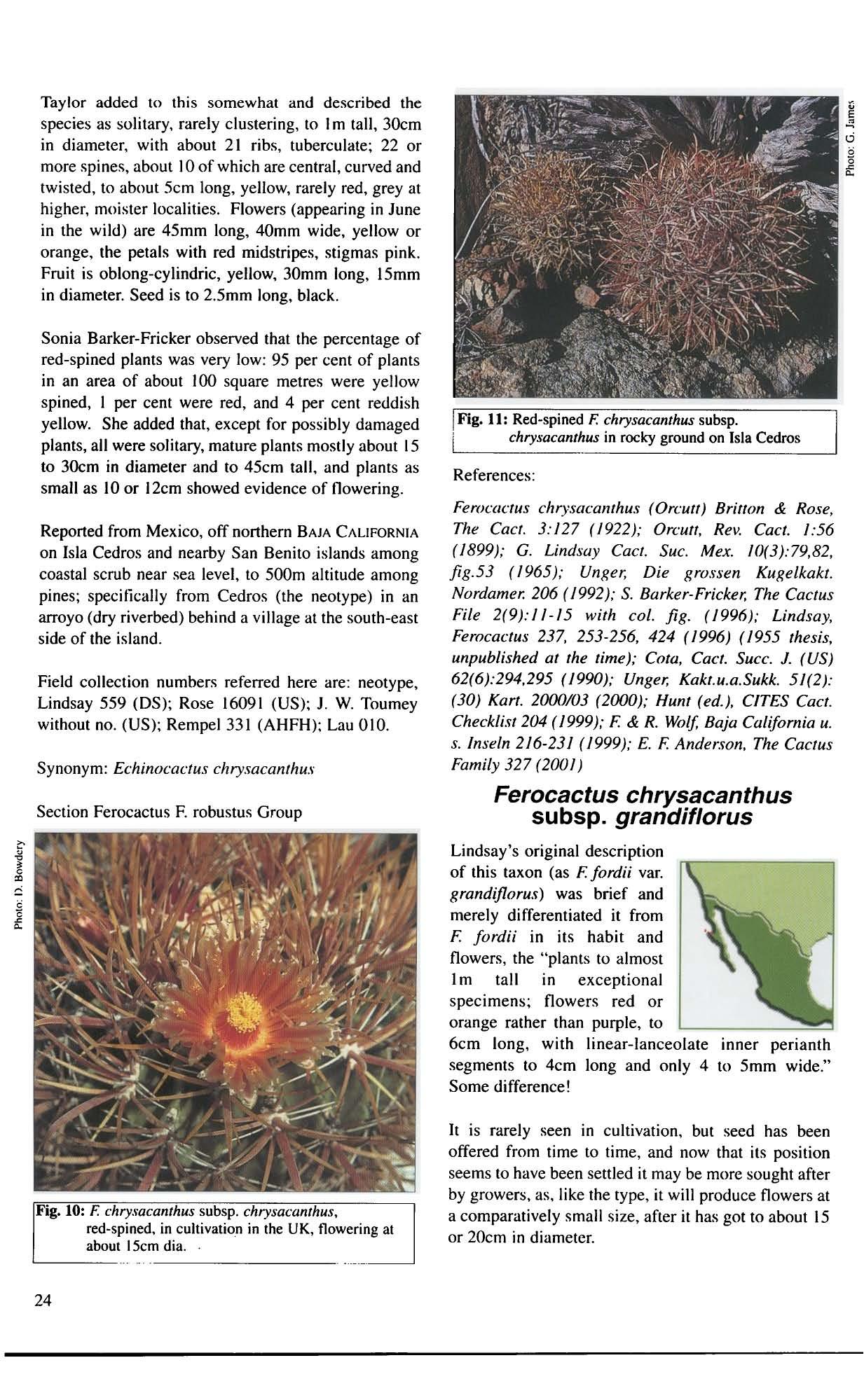
FerocaclUs chrysaean/hus (OreulI) Brillon & Rose, The Cact. 3:/27 (/922); Orcutt. Rev. Cact. 1:56 (/8991; G. Undsay Cact. Suc. Mex. 10(3):79.82, fig·53 (1965); Unger, Die gross'en Kugelkakt. Nordamer. 206 (/992); S. Barker-Fricker, The Cae/us File 2(9):11-15 with col. fig. (/996): Undsay. Ferocactus 237, 253-256, 424 (1996) (1955 thesis, unpublished al Ihe lime); COla, Cael. Succ. J. (US) 62(6):294,295 (/990); Unger, Kakt.u.a.Sukk. 51(2): (30) Kart. 2000/03 (2000); Hunt (ed.), CITES Cact. Checklist 204 (1999); F. & R. Wolf. Baja California u. s. Inseln 216-231 (1999); E. F. Anderson, The Cactus Family 327 (2oo/)
Ferocactus chrysacanthus subsp.grandiflorus
Lindsay's original description of this taxon (as F. ford;i vaT. grandifTorus) was brief and merely differentiated it from F. fordii in its habit and flowers. the "plants to almost 1m tall in exceptional specimens: flowers red or orange ralher than purple. to 6cm long. with linear-Ianceolate inner perianth segments to 4cm long and only 4 to 5mm wide." Some difference!
It is rdrely seen in cultivation. but seed has been offered from time to time, and now that its position seems (0 have been settled it may be more sought after by growers, as. like the type, it will produce flowers at a comparatively small size, after it has got to about 15 or 20cm in diameter.
Unger's description along with excellent colour photograph in the German Society's journal is as follows: stem solitary, at most only about 1m tall, and to 25cm in diameter. Spines dense, with up to 7 centrals, the lowest one flattened and hooked, about Scm long and to 5mm wide, the upper central spine straight, dagger shaped, porrect andthe longest, 5.5cm, the other five spines to 4cm; there are 18 to 21 radial spines, 2.5 to 4cm long, most whitish, bristle-like, the lower 3 to 5 stronger and thick. All the thicker spines at first orange-red. brownish-yellow, later dark brownish-red. Flowers produced in spring (February to ApTiI), yellow with red midstripe, 6cm long. 7cm wide, anthers red. (stigma yellow in photograph). Fruit is greenish-red to yellowish-orange. 17 to 20mm in diameter. Seed is brown to black. 2 to 3mm long, 1.5 to 1.7mm wide.
Reported from Mexico. BAJA CALIFORNIA, San Bartolome Bay (the type), the west coast of the peninsula from Punta Eugenia to below Punta Abreojos and Isla Natividad; more recently by Unger from Bahia Tortuga (according to Unger practically identical to San Bartolome Bay) andthe hills to the south-east of the bay (this is the area nearest on the mainland to Isla Cedros); at I-200m alti.ude. Paul Hoxey phOlographed plants more or less in the centre of this distribution, near the coast between San Hipolito and Bahia Asuncion.

Field collection numbers referred here are: holotype Lindsay 556 as F. fordii var. grandiflorus) (DS). isotypes (MEXU. SD); Lindsay 559 (DS); Lindsay 555 from San Roque Point (DS. SD); Rose 16188 (US); Rose 16249 (US); Dawson 6444 (AHFH); Lau 1410.
Synonyms: F. ford;i var. grandijlorus; F grandiflorus; F. x grandij10rus
References:
Ferocactus chr)'sacanthus subsp. grandiflorus (G. Lindsay) N. P. Taylar, Caci. COII.\·. Illil. 6: 16 (1998); G. Lindsay. Caci. Succ 1. (US) 27(6):164-165. fig.154 (/955) - as F. fordji var. grandiflorus; N. P. Taylor, Bradleya 2:34 (/984); Unger, Die grossen Kiigelkakl. Nordamer. 242 (/992) - as Fx gralldiflorus; Lindsay, Ferocactus 258-260,280 (as Fjord;; var. grandiflorus) (/996) (1955 Ihesis. unpublished at Ihe lime); F. & R. Wolf, Baja California u. s. Illse/ll 198-205. 232-239 (1999); HUIII (ed.) CITES Co('/. Checkiisl 204 (1999); Ullger, Kakl. u. a. Sukk. 5/(2):(29-30) Kart. 2000/03 (2000)· as F. grand;florus; E. F Anderson, The Cactus Family 327 (200f)
Ferocactus
Seeing this species in habitat for the first time is unforgettable. particularly in southern California where there are few columnar cacti: the plants of this species stand out as (he most dominant cacti in the landscape. shining with their brilliant red and yellow spines in the sunshine. In cultivation plants will respond well to steady reponing in the first few years. growing strongly, with the possibility of flowers once they get to aboul 20cm tall and wide. this laking something like 10 to 15 years. The crowning glory of the flowers on this stunningly beautifully spined species is well worth the wait and the effort.
It has been known for many years as Feroc.:ac.:tus aean/hodes, and many fanciers of this genus cling on 10 this name, but it has been discredited by Nigel Taylor as not applicable to the commonly held concept of this species, the most significant point of his argument to our thinking being that the plant Lemaire described had fruit. this on a plant only II cm high and 15cm broad. and it seems likely that the name as originally applied was as Taylor suggesls applicable to F. viridesf-'ens. subspecies. bUI F. joJm...toniclIlu.... an island species which Taylor in his review suggests is "probably only a disjunct. island variety of F. cylindraceus" is considered separately herein (see under F. johnstonianus).
As there is often confusion among Ferocaaus enthusiasts as to which is which of the subspecies occurring in Ihe southern U.S.. i.e. subsp. cylindraceus (the type). subsp. easrwoodiCle, and subsp. lecontei, we have included below a table based on that in which Lyman Benson differentiated them (p.6R6 of his Cacti o/the United States and CClnada). It must be said that the difference between the type and subsp. lenmtei is particularly difficult to define, and al times Ihey seem to overlap in their distribution as well as their characters. !Fig. 15 (opposite page): A magnificent clump of :J F. cylindraceus subsp. cylindruceus in the Anza Borrego, California. USA
Fig. 14 (below): F. cylind;aceus subsp. cylindrauus Anza Borrego. California. USA


Distinctive spine characters (according to Benson 1982) of the three subspecies of F. cylindraceus occurring in the US are:
Spine principal (lower) central
Inner radial spines (similar to centrals) Outer radial spines subsp. cylindraceus 7.5- l4cm long. curving at (he tip to about 900. but not recurved. red (occasionally yellow I becoming grey 6-8. 1-I.5mm diameter
Nearly white. flexible. curving irregularly in and out. 3.S-6.2cm long. subsp. eastwoodiae 7.S-S.lem long. curving slightly. conspicuously yellow or straw yellow
12-14. 5mm diameter nearly straight. rigid None present
subsp. feconfe; 5-7cm long. curving slightly. red (occasionally yellow). becoming grey
6-S. 1-1.5mm diameter
Nearly white. flexible. curving irregularly in and oul. 5cm long. O.5mm diameter
Ferocactus cylindraceus subsp.cyhndraceus
This was the first Femcactus we saw in habitat in the Anza Borrego Desert in 198 I. where we were taken by a kindly local cactus enthusiast. Our combined weight (there were six of us in his car) threatened to shorten his accustomed drivable distance into the desert floor. With a total disregard for his sump doing its best to break up (he rocks in the din track. we got well among the cacli before he gave up and we opened the oven like doors of the airconditioned car 10 step into the heat. The first day in wild desert for any cactus fan is a memorable experience, but for our first day in that desert with our eyes feasting on this. the type ("'f F. cyfindraceus. as well as less obvious gems like MammUiaria tetrancistra. it was one never to be forgotten. The Ferocactus stood like Rumpelstiltskin. inviting our guesses at its name. Little did we realize as we confidently referred to it as F. acanthodes. that like the fairy tale we would later accept that we were not right in this assumption.
This, the type. predominantly from California. but also found in Arizona and nonhern Baja California. was described by Nigel Taylor in his review of the genus (lying close to Benson's description). as solitary, rarely branching or only when damaged, eventually cylindric or somewhat barrel-shaped [traditional wooden barrels it is assumed. in these days of cylindrical metal barrels J. to 3m tall, to 30cm or occasionally up to 40cm in diameter. with 18 to 30 ribs,luberculate. Spination extremely variable in size. colour and form: with about 15 to 25 radial spines, from fine and hair-like, to stout and intergrading with the cenlral spines; the 4 to 7 central spines round in section or with two or more tlauened, straight. curved or twisted. the lowermost the longest, to I70mm, often curved, sometimes hooked at the tip. yellow or red. or both yellow and red. Flowers (appearing in spring in the wild) are green or yellow. sometimes tinged with red. Fruit is 30 to 40mm long. 1.5 to Zcm in diameter. yellow. Seed is dark brown. 2 (0 3mm long.

Reponed from USA and Mexico. specifically from USA, CALIFORNIA: San Diego County: San Felipe. eastern slopes of California Mountains. from between Julian and Ihe Borrego Valley. Sentenac Canyon. Agua Caliente; Imperial County: Mountain Springs. US highway 80: Riverside County: Keys Ranch. edge of the Colonldo desen. Cottonwood Spring. Indio. Chuchawalla Springs: San Bernadino County: Barstow, Needles. Cedar Canyon. New York Mountains; from ARIZONA: Yuma county: Tyson. Petrified Forest. Yuma. Hidden Valley, Indian Cove. Joshua Tree National Monument; from Mexico. northern BAJA CALIFORNIA. cast of Sierra Juarez; north-west SONORA; Colorado desert; at 60 to 600m allitude.
Field collection numbers referred here arc: type. Parry (1849 or 1850) as E("hinoeae/us viridescens (var.) cyUndraceus, without no. (Mo); Rose 12052, 12064
(US); Lindsay 2063, (OS, SO); Wolf 8491 (OS, RSA); Parish 163 (Mo); Oubber, Harbison & Higgins 44.131 (SD); Gander 5299, (SO); Benson 10365, 4235 (POM); Mun7. & Johnston 5291 (DS); Parish 163 (DS); Evermann without no. (CAS); Hall 6013 (UC); Wiggins 8748, 8760 (DS); Rost 327 as r: TOstii (US 2296912); Lau 1251; Rep. 200, 207a; DJF 1354, 1355; SB 1906; JS 54, 82.
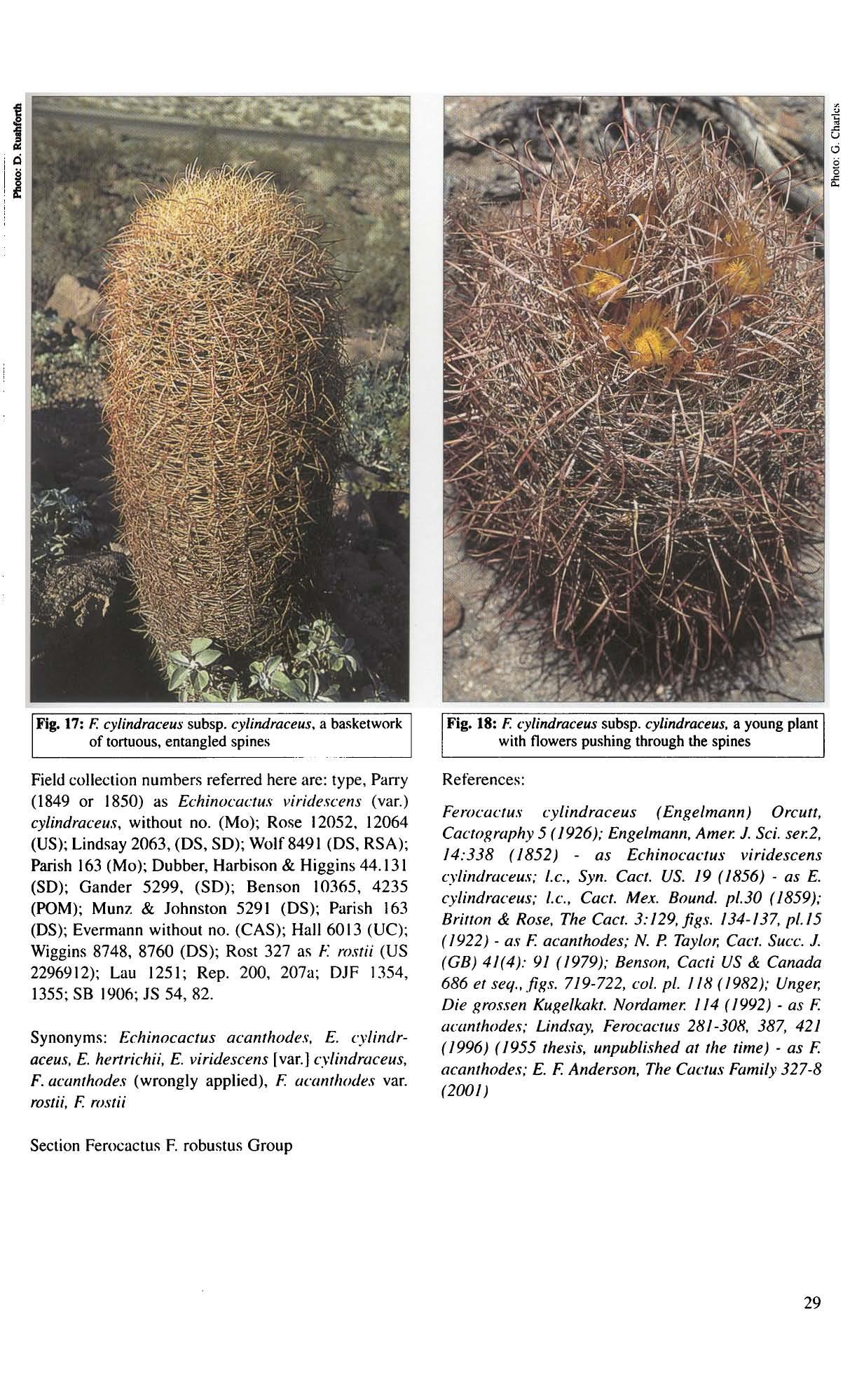
Synonyms: Echinocac/us aeanl/wdes. E. cvlindraceus. E. her/richii, E. viridescens Ivar.j F. acanthodes (wrongly applied). F. aeonthodes var. rostii. F. rustii
Section Ferocactus F. robustus Group References:
Feroeactus cylindraceus (Engelmann) Orcutt, Caetography 5 (/926); Engelmann. Amer. J. Sci. ser.2. /4:338 (/852) - as Echino(·uctus viridescens eylindraeeus: I.e.. 5)'n. Cac/. US. /9 (1856) - as E. cylindraceus; I.e.. Caet. Mex. Bound. pl.30 (/859):
(1922) - as F. aeanthodes; N. P. Taylor. Caa Suee. J.
(GB) 4/(4): 91 (/979); Benson, Cacli US & Canada 686 et seq., figs. 719·722, ('01. pI. 1/8(/982); Unger,
Die grossen Kugelkokt. Nordamer. 114 (1992) . as F. aeanthodes: Lindsay. Feroeaetus 281-308. 387, 421
acanthodes; E. F. Anderson. The Ca(·tus Family 327-8
(200/)
Ferocactus cylindraceus subsp. eastwoodiae
This subspecies is distinct in having yellow, stiff, more or less straight spines, not the dense. flatlened. twisted spination of the type and subsp. tortulispinus; it also lacks the thinner. supplementary radial spines of all other subspecies. This last difference from the type and other subspecies is the most significant. and immediately identifies plants observed in the field or in cuhivation. It has given the lie to some plants identified as this subspecies from California, where it is not known to occur. The yellow spination is most auractive and makes growing it in cuhivation ajoy; it will take about 15 years or more to grow to flowering size, at about 25cm tall, and 20cm wide. Taylor left it in limbo in the 1999 CITES Cllctaceae Checklist, i.e. as provisionally accepted with the implication that it might resolve under this species either as a synonym or subspecies, bUI in 2002 he amalgamated it here as a subspecies. Anderson (200 I) follows suit and lists it as a species. adding that it "is closely related to F. cylindraceus". From Benson's detailed localities it is clear that it occurs only locally in 2 or 3 places (usually on cliffs) in the eastern part of the range of this species, with an isolated occurrence in the south of the distribution. In view of its individual appearance, spine differences and localized occurrence we are happy to recognize it as a subspecies here as it is a wonhwhile collector's plan!.
Benson's description is of a plant with 12 to 14, unifonnly stoOl, stiff, radial spines 44 to 56mm long. similar to the central spines and lacking the thinner, outer radial spines of other subspecies, and with 4 stronger central spines in crucifix formation, the lowermost central spine 75mm to 80mm. 2.5mm broad. like the others. slightly curved, stiff and bright yellow. Fruit is yellow. Seed is 2mm long. only slightly longer than broad, shiny dark brown to black. Plants pictured by Benson on cliffs look to be a metre lo a metre and a half tall, and about 40 to 50cm in diameter.
Reported from the Sonora Desert. From USA, ARIZONA, near Superior, Pinal County, mountains above Queen Creek. 975m altitude. between Camp Verde and Strawberry, in east Yavapai County; in the west of Pima County, near Bates Well. Growler Mountains; the south-east of Pinal County, and the
Fig. 19: F. cylindraceus subsp. easrwoodiae with characteristic neal rows of slightly curved. yellow central spines
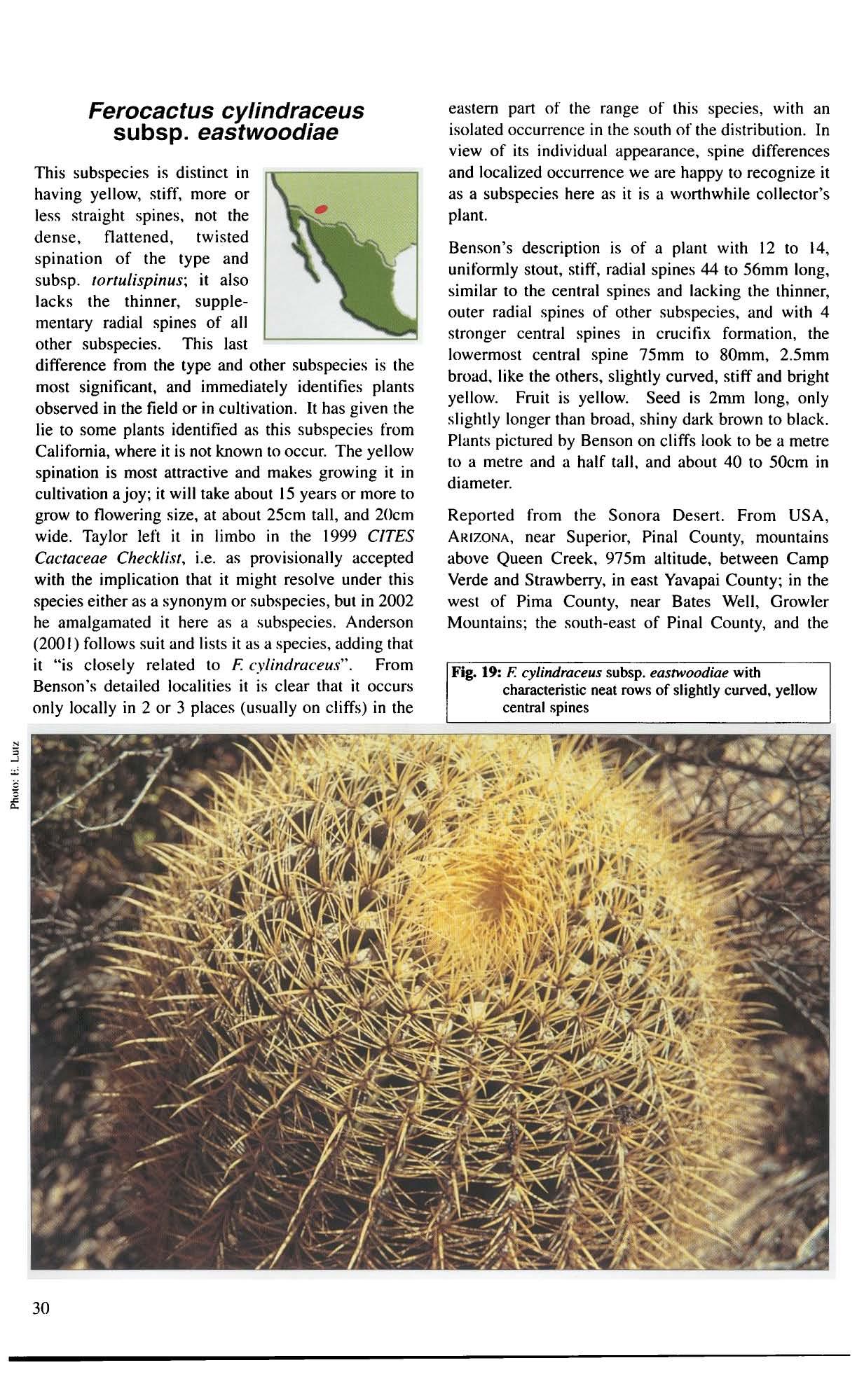
Femcactus cylindrac.:eus subsp. eas(woodiae (Ben.wm)
N. P. Taylor, Cactaceae Sys(emati£'s Initiative.\' 14:16
(2002); L. Be",wm, Cacti of Arizona ed.3 23 (1969);
Cacti US & Canada 692, figs. 726, 727, cal.pl.//9,121 (19X2); suppl. 969 (1982) . as F. eastwaadiae; N. P.
Taylor, Bradleya 2:33 (1984); Lindsay, Ferocac:tus 290·293 (1996) (1955 thesi!i, unpublished at the time);
Anderson. The Cactus Family 328 (2001) . as F. eustw(}odiae
south-west of Gila County. near Winkelmann. Globe;
at 390·I,140m altitude.
Benson 16618 (POM 311.312): L. Benson 9895 (POM, Ariz., CAS): Eastwood 17479 (CAS): I. G. Reimann (POM): SB 1836.
Synonyms: F var, ea,'i1woodiae. F cylindraceu.\' var. easrn:oodiae. F. eastwoodiue
!Fig. 21: F. cylilldraceus subsp. easlwoodiae ! enjoying life in the Superstition Mountains.
Arizona. USA
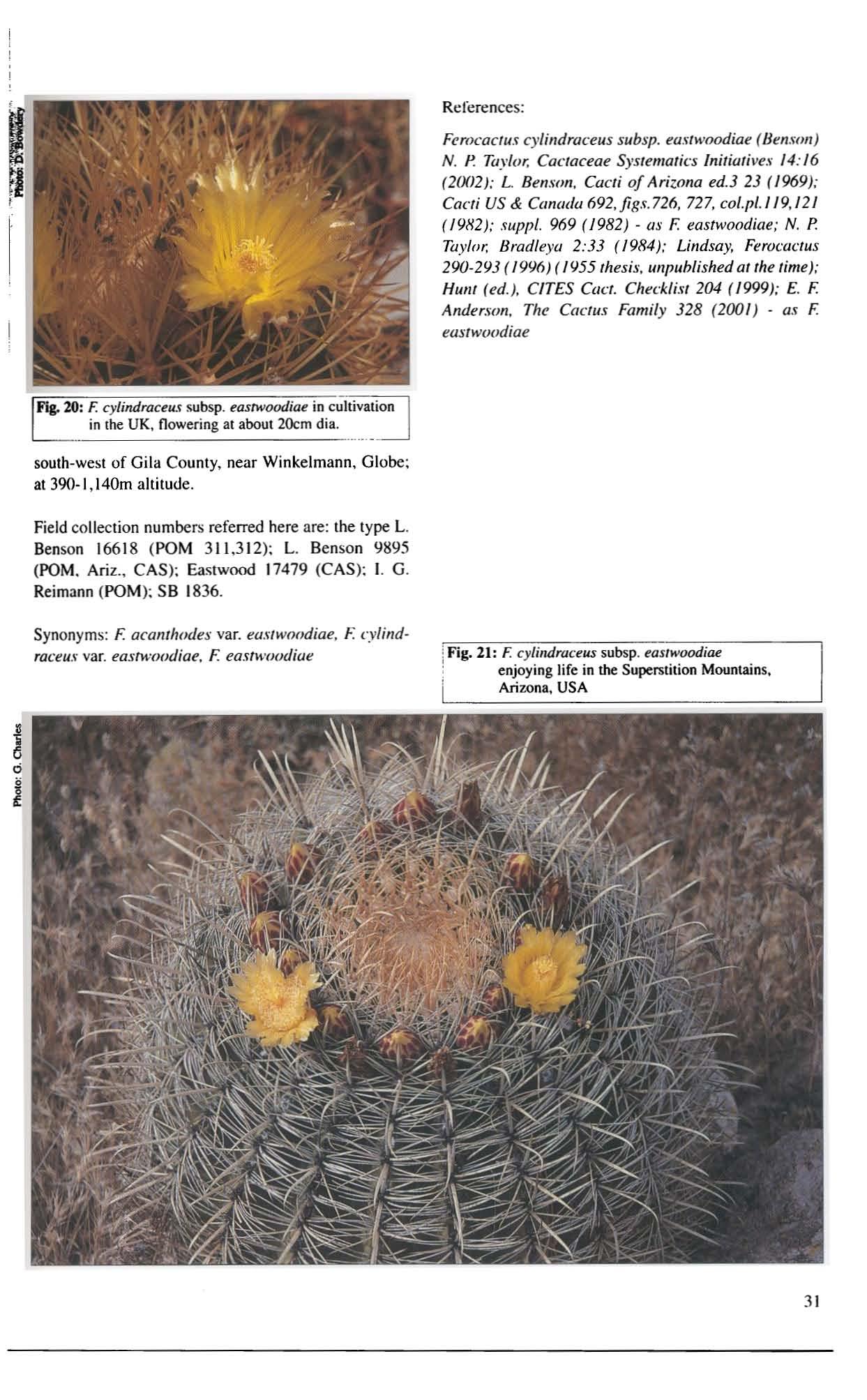
Ferocactus cylindraceus subsp. lecontei
This subspecies is more slender than the type, with spines at first yellowish or red and yellow, less flattened and not twisted like the type; Benson pictures a plant in the Mojave desert in Yavapai County, Arizona, about 2m tall and half a metre wide.
The description by Benson differentiated this subspecies as follows: a longest central spine 5 to 7cm long (7.5 to 14cm in the type), the apex curving a little, at maturity red [but yellow spined fonns have been reported) becoming grey. the inner radials 6 to 8. similar to the centrals 3 to Scm long, the outer 6 to 12 thinner, flexible, irregularly curving in and out, nearly white. Fruit is yellow. Seed is black, to 2mm long.
On a visit to the southern states of the USA we saw some outstanding plants of this subspecies on a trip out north-west of Phoenix, Arizona, where we had taken my cactus-innocent elder son (who was on a business trip) to show him what he was missing by staying during most of his spare time by the hotel swimming pool admiring the female scenery. To his amazement and consternation for things proper, he watched as we slid beneath a wire fence in order to photograph wonderfully spined plants of this subspecies growing in rocky outcrops. They were about 70 or 80cm tall, and a third of their height in diameter; the glowing red spination was outstanding in its vivid flowers were distinctly yellow, with a red midstripe.
Reported from the USA and Mexico, in the Mojave, Sonora and Colorado deserts at 300 to 1500m altitude. From the USA, ARIZONA except the north-east, specifically Pinal County; Bill Williams Fork of Colorado River; south south NEVADA; south-west UTAH; from Mexico, north SONORA, Sonoita; at 300-1 ,500m altitude. Benson's plotting of reported occurrences in the wild (page 687 of his major work) shows a generally more easterly preference for this subspecies, mainly in central Arizona, but meeting with the type in eastern California and in its eastern and southern extremities with subsp. eastwoodiae, which adds to the doubts about these subspecies' taxanomic separation.

Field collection numbers referred here are: lectotype.
Bigelow (Mo); Munz & Everett 17454 (RSA); Wiggins 8269, 8358 (DS); G. A. Wilcox without number (US); 58517.
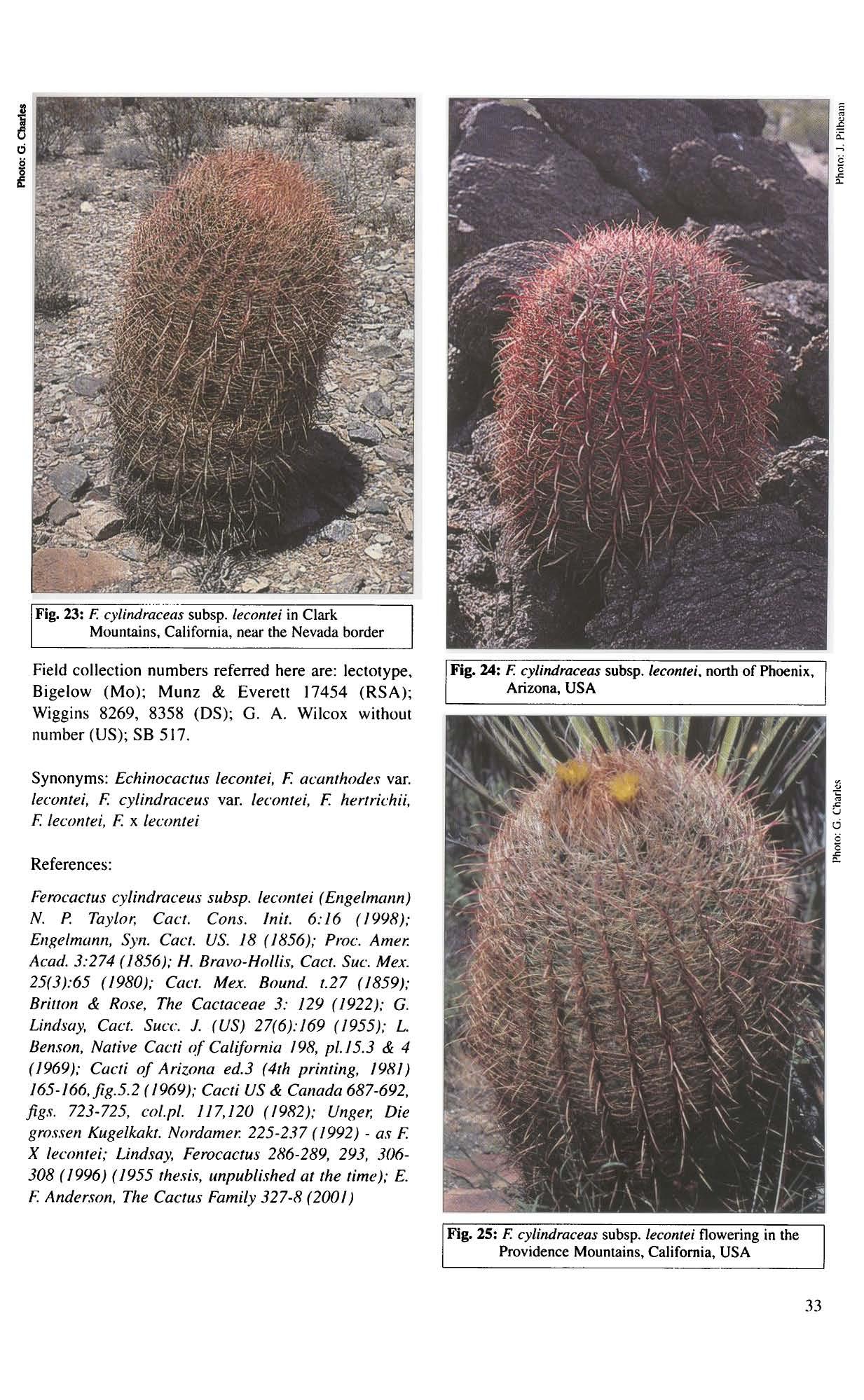
Synonyms: Echinocacills lecontei. F. acanthodes var. lecontei. F. cylindracells var. lecontei. F. hertric:hii. F. leeontei, F. x lecontei
References:
Feroeactlls cylindraeell.\· subsp. lecontei (Engelmann)
N. P. Taylor, Cael. Cons. Init. 6: 16 (/998);
£ngelmonn, Syn. Caet. US. 18 (1856); Pmc. Amer. Acad. 3:274 (1856); H. Bravo-Hollis. Caer. Sue. Mex.
25(3):65 (/980); Cael. Mex. Bound. t.27 (/859);
Britton & Rose, The Cactaceae 3: /29 (1922); G.
Lindsay, Caet. Suee. J. (US) 27(6);/69 (/955); L
Benson, Native Cacti (l California /98, pl.15.3 & 4
(/969); Cacti oj Arizona ed.3 (41h printing, /911/) 165-166,fig.5.2 (1969); Cacti US & Canada 687-692, figs. 723-725, col.pl. 1/7,/20 (1982); Unger, Die
grossen Kugelkakl. Nordamer. 225-237 (/992) - as F. X le(:ontei; Lindsay, Ferocaclus 286-289. 293. 306-
Ferocactus cylindraceus subsp. tortulispinus
Although much less tall than other subspecies this is perhaps the most spectacular of them all. with long. tortuous, deep red central spines. With lillie accom· panying vegetation of any size they stand out on the hillsides, particularly after a shower of L
.::: rain, which lights up the red colouring dramatically.
It was described by Gates (as a new species) as solitary. globose to subcylindric, to about 60cm tall, 40cm in diameter, with 20 ribs. Radial spines 3 or 4 on each side of the areoJe, 6 to 8 in all, needle-like, spreading greyish-white. Central spines 1J. stiff, slender. very diverse, ringed, spreading or appressed, dull greyish red with yellow lips. all straight and sharp, except the lower middle one, this slender. elongated to 13cm. more or less hooked and generally pronouncedly tortulose. The flowers. fruit and seed were not observed; collected seed is 2mm long. shiny black. Significantly Gales said that in form and size this species "resembles F. Q('anthodes (i.e. F. cylindraceus1 more than any other of the Lower Taylor describes it as differing from the type mainly in its geography. bUI also in its shorter stem, commonly not more than 70cm, but exceptionally to 2m tall. spines orange-red. or reddish-grey where it grows near to F. gracilis. flowers slightly smaller. clear yellow. Plants seen by the authors included one large. apparently naturally clustering plant. nearly a metre tall. but in general plants of this variety were smaller than other subspecies. often globular. and producing flowerswhen only aboul 25cm tall and wide. We found them in only one location on our various trips to Baja California. growing in a small canyon, outstandingly different from other Ferocactus species we had been seeing. with their splendidly tortuous, red spination and bright yellow flowers. The fruit is yellow.

Reported from Mexico, northern BAJA CALIFORNIA, 16km north of Laguna Chapala Seca, 29" 39' N, 114" 40' W; canyon sourh of Mision Calamajue. between EI Crucero and Cerro Juan. east to Calamajue and Las Arrastras de Arriola, east margin of Viscaino Desert; at 600m altitude.
Field collection numbers referred here are: the type H.
E. Gates 161 (DS 207825); Lindsay 2064 (DS, SD); Lau 1217; Rep. 269.
Synonyms: F. llL'anthodes subsp.lvar. tortu/i.\pinus. F. cy/indrac:eus var. tortulispinus, F. tortulospinus. F. acanl/wdes var. lOrtulospinus
References:

Ferocacttts cylindraceus subsp. tortulispinus
(H. Gates)N. P. Taylor. Caet. Cons.lnit. 6:16(/998); H. Gates, Caet. Saec. J. (US) 4(9):343, with fig. (/933); H. Bravo-Hollis, Caet. Sac. Mex. 25(3):65 (1980); G. Lindsay, Caet. Saec. J. (US) 27(6): 168-169 (/955); Lindsay. ferocactas 285-286, 293, 303-305,
422 (/996) (/955 thesis, unpublished Cl1 the time);
N. P. Taylor. Bradleya 2:33-4 (1984): E. F. Anderson. The Caetlls Family 327-8 (2001)
Ferocactus diguetii
The largest growing of all Ferocactus. this is one species that any enthusiast for the genus would want to see in habitat: and Derek braved the Gulf of California in a fishing boat 10 do just that as a millennium celebration when he found himself with the chance to do so. To stand alongside a Femcaclus that towers above you at least twice your height is an awe-inspiring experience.
It grows on several islands in the Gulf of California, and is of course difficult to get to, requiring the cooperation of a friendly local fisherman willing to take you in his boat to one of the islands. and, more importanlly, to either wait or pick you up again later. In cultivation it is slow growing. and seedlings grown in the UK for some 15 years or so have achieved only 20cm or so in height. andthe same in width. It has distinctive pale spines and a pale green body colour, reminiscent of F. pOliS;;, which is in the same group. Smaller growing plants found on Isla Carmen, named as var. carmenens;s by Lindsay in 1955, are not recognized as a separate subspecies, since that is all they seem to be - smaller growing.
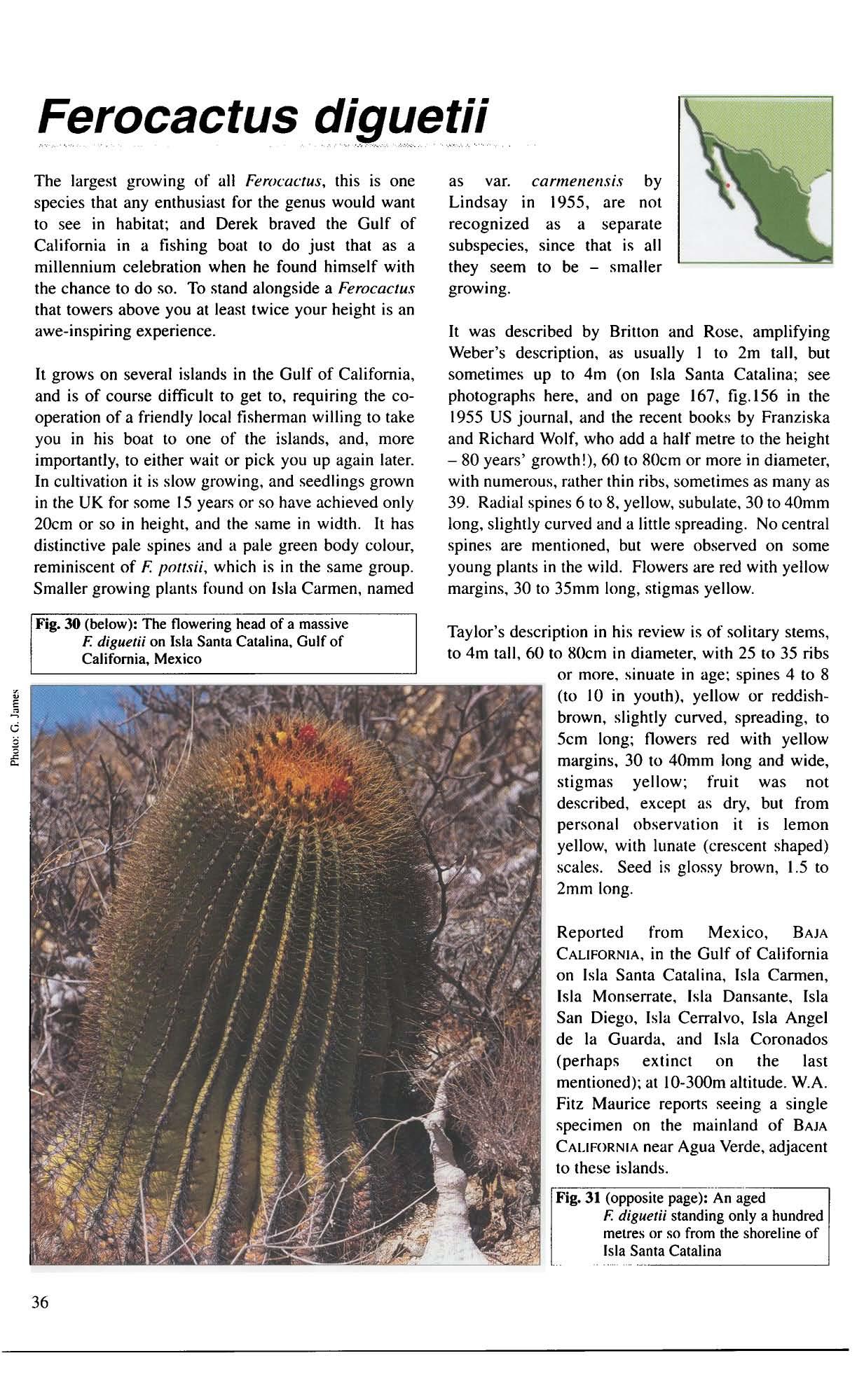
It was described by Britton and Rose. amplifying Weber's description. as usually I to 2m lall. but sometimes up to 4m (on Isla Santa Catalina; see pholographs here. and on page 167, fig.l56 in the 1955 US journal, andthe recent books by Franziska and Richard Wolf, who add a half metre to the height - 80 years' growth!), 60 10 80cm or more in diameter. with numerous. rather thin ribs. sometimes as many as 39. Radial spines 6 to 8. yellow, subulate. 30 to 40mm long. slightly curved and a little spreading. No central spines are mentioned, but were observed on some young plants in the wild. Flowers are red with yellow margins. 30 to 35mm long, stigmas yellow.
Taylor's description in his review is of solitary stems, to 4m tall, 60 10 80cm in diameter. with 25 10 35 ribs or more. sinuate in age; spines 4 to 8 (to 10 in youth). yellow or reddishbrown. slightly curved. spreading. to Scm long; flowers red with yellow margins, 30 to 40mm long and wide. stigmas yellow; fruit was not described, except as dry, bUI from personal observation it is lemon yellow, with lunate (crescent shaped) scales. Seed is glossy brown. 1.5 to 2mm long.
Reported from Mexico, BAJA CALIFORNIA, in the Gulf of California on Isla Santa Catalina. Isla Carmen, Isla Monserrate. Isla Dansante. Isla San Diego. Isla Cerralvo. Isla Angel de la Guarda. and Isla Coronados (perhaps extinct on the last mentioned); at IO-3OOm altitude. W.A. Fitz Maurice reports seeing a single specimen on the mainland of BAJA CALIFORNIA near Agua Verde. adjacent to these islands. Fig. 31 (opposite page):'-An aged F. diguelii standing only a hundred
meL.res or so from (he shoreline of . Isla Santa Catalina

Field collection numbers referred here are: neotype
Moran 3883 (OS); Lindsay 2204 (as type of F diguerii
var. carmenensis) (OS), (isolypeS in MEXU. OS);
Johnston 4098 (CAS); Johnston 4037 (CAS); Lindsay 518 (OS); Lindsay 525, 2200; Lindsay 2187 (OS, SO); Lindsay 2170 (OS, SO): Moran 3581 (OS); Lau 57.
Synonyms: Ec:hinoc:aclus diguel;i. F. diguelii subsp.lvar. clIrmenens;s
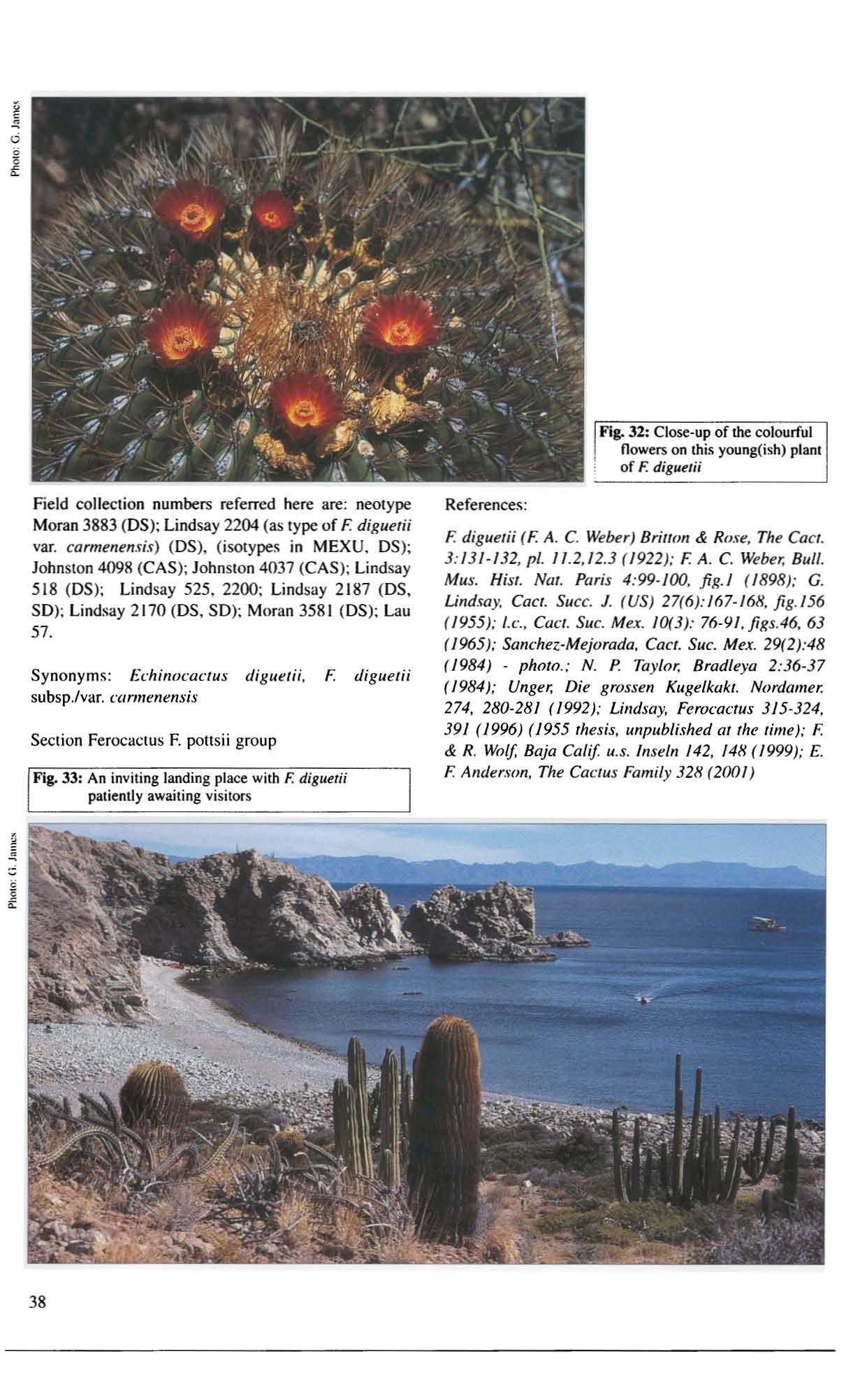
Seclion Ferocactus F. pottsii group Fig. 32: Close-up of the colourful nowers on this young(ish) plant of F. diguelii
References:
F. diguel;i (F. A. C. Weber) Srilton & Ro:.e. The Caci.
3:131-132, pl. 1/.2,/2.3 f/922); FA. C. Weber, Bull. Mus. Hist. NUl. Puris 4:99-/00, fig.1 f/898); G. Lindsay, Cacl. SUCC. 1. fUS) 27f6):/67-168. fig. 156 f/955); I.e.. Cacl. Suc. Mes. 10(3): 76-91, Jigs. 46, 63 f/965): Sanehez-Mejorada, Cacl. SUC. Mes. 29(2):48 f/984) - phmo.: N. P. Taylor, Bradleya 2:36-37
(1984); Unger. Die grossen Kugelkukl. Nordamer.
274, 280-281 f/992); Lindsay, Feraeoelus 315-324, 391 (1996) (1955 Ihesis, unpublished m Ihe lime); F & R. Waif, Baja Calif u.s. Inseln 142, 148 (1999); E.
F. Anderson, The CGI.:IUS Family 32H (2001)
Ferocactus echidne
This is an easy to grow species. and in habitat young plants of only about 12cm in diameter can be found in flower. To achieve this in cuhivation a good sunny position is needed, although plants seen along the road west of Rio Verde in the Mexican state of San Luis PotOSI seemed to seek out positions under low scrub or small trees, but of course the sunshine that does get to them is the hot, Mexican kind. Seedlings often cluster quire early in life. al about 3 or 4 years of age.
Lindsay maintained the variation of this species which occurs around Ciudad Victoria in Tamaulipas. as a variety. i.e. F. e£:hidne vae. victoriensis. but the differences arc slight. and there is considerable variation throughout its range according to Nigel Taylor. who maintains that such recognition is unnecessary.

De CandoJle's description of the species is amplified by Brinon and Rose. who described it as depressedglobose. 12.5em tall. 18cm in diameter, green, with 13 acute ribs. Radial spines are rigid. about 7, and about 2cm long. yellow; the single central spine is 3cm long or more. porree!. Flowers are lemon-yellow. Fruit and seed nol described. Taylor further amplified the description as follows: siems solilary or clustering, sometimes forming large clumps (more than a metre across by 30cm tall), flattened-globose to cylindric. to 35cm tall (but up to 80cm). and 20cm (but up to 3Ocm) in diameter. dull to grey green, with 13 to 21 ribs (this last usually auributed to var. v;CfOr;£'IlS;s, as well as the more heavily clustering plants. which Taylor regards as synonymous with the type; he also has reported a decumbent specimen at least a metre in length, seen in Queretaro). Radial spines 7 to 9. are shorler than the one central spine which is 5 to lOem. Flowers are yellow, rarely red, 20 to 45mm long, 30 [() 35mm wide. Fruit is globular to ovoid. 20mm long. 12 10 15mm in diameter. juicy. light green. white. tinged pink or red, or purplish. with yellowish, obtuse scales. Seed is I to 1.75mm long. dark red to black.
While somewhal reluctantly accepling Taylor's dismissal of var. v;ctor;ens;s. we feel bound to advise Femc(lctus enthusiasts to seek out the narrow-ribbed variant (one of the distinguishing characters of var.
viClorieflsis) <x';l:urring commonly around Ciudad Victoria. as well as looking out for the particularly long·spined plant" of this ilk (long spines being another of the distinguishing characters of var. victoriens;s). Either or both features make a handsome addition to a collection of the genus.
We also took the opportunity in aulumn 2003 (0 check oul the remote type locality of 1. Purpus's Femcactus ra!ae/efls;s. referred for some time to synonymy with F. ech;dne. The road to the Minas de San Rafael is not an easy one. and probably not visited thai frequently except for those of a hardy disposition, We eventually bumped along Ihe road to the mine which is still being worked, although much of the siructure has been raided for ils bricks, and there is an air of past desolation aboul the place. The Femt'll(."tu.'i planls seen in the locality clearly owed much to F echidne. and were not we thought worth separate consideration in a broad view of the species.
Reported from Mexican stales of HIDALGO. SAN LUIS POTOsi, NUEVO LEON. QUERETARO, and GUI\NAJUATO, specifically from HIDALGO. from Puente Tasquilla on the Laredo highway, Barranca de Mezquitlan. Barranca de Venados, Paso Leone. Barranca Xilitla, Gila-Almolon. Xhaja. San Cristobal to Metztitlan, Barranca de Tolontongo, Barranca del Rio Amajaque. Rio Moctezuma. Toliman. Tecozautla, Mezquital. Tasquillo. Metztitlan; from SAN LUIS POTosi, Ciudad Maiz, San Rafael, from the pass by Sauz.Reformita. Arroyo Carrizal, San Rafael Laguna. Buenavisla. Las Rusias, La Calzada; from NUEVO LEON, north·east of Aramberri; from QUERETARO. north of Vizarron. Rio Jalpan, north of Jalpan, Toliman near Bernal, Azogues. San Joaquin, Gatos, San Juan Tella. Maconi; from GUANAJUATO. at San Felipe; at about 300-1 ,860m allilude. on basic soils.
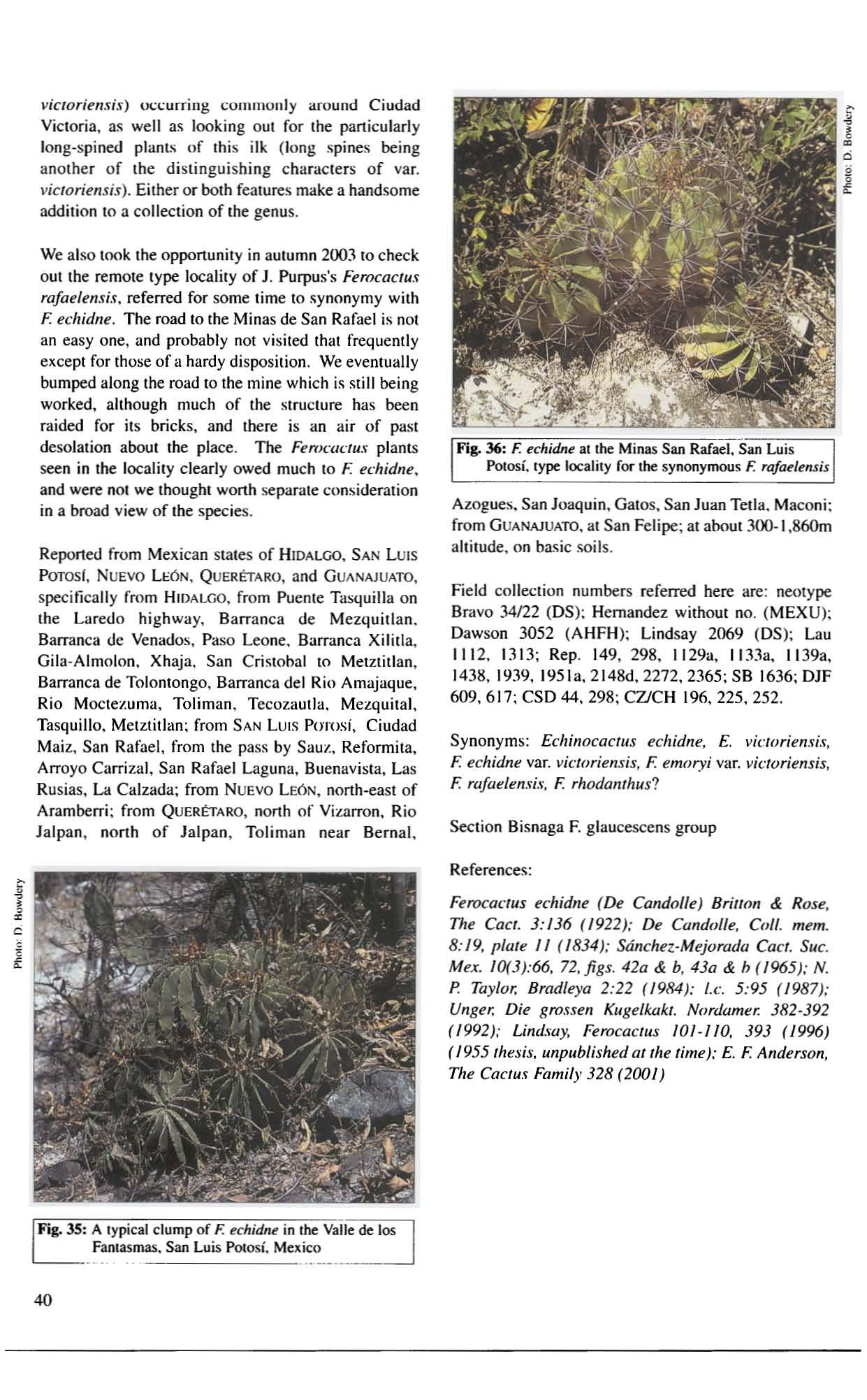
Field collection numbers referred here are: neotype Bravo 34/22 (OS): Hernandez withnut nn. (MEXU); Dawson 3052 (AHFH); Lindsay 2069 (OS); Lau 1112. 1313; Rep. 149. 298. 1129a. 1133a. II 39a. 1438.1939. 1951a. 2148d. 2272. 2365; SB 1636; DJF 609.617: CSD 44.298: CZlCH 196.225.252.
Synonyms: Ed,;nocaclUs echidne. E. victor;ens;s, F. echidne var. v;ctoriens;s, F. emory; var. vicwriens;s, F. ra!ae/enJi,\', F. rhodanthus?
Section Bisnaga F. glaucescens group
References:
Ferococtus echidne (De CandolJe) Bri//on & Rose, The Caet. 3:/36 (/922); De CandoJJe, Coli. memo 8: /9. plale 1/ (/834); Sanchez-Mejorada Caci. Suc. Mex. /0(3):66, 72,figs. 420 & b, 430 & b (/965); N. P Taylor. Bradleya 2:22 (/984): I.e. 5:95 (/987); Unger. Die gm.uen Kuge/kakt, Nordamer. 382-392 (/992); Lindsay, FemcacllIs /0/-1/0. 393 (/996) (/955 thesis. unpublished at the time): E. F Anderson, The Cac/lls Family 328 (200/)
Ferocactus emory;
Nigel Taylor has now reduced F. rectispinlls, which is clearly related to this species and grows on the other side of the Gulf of California, to a subspecies beneath F. emory; - see below.
Ferocactu5 emory; subsp. emory;
When we first saw this. the type of the species, in Arizona in 1981 the difference between it and the cooccurring F. wis/izeni was difficult to determine. The most obvious difference is in the more robust radial spines in this species (some are wispy in F. wi..,Jizeni). Now, having grown them all for some years the differences are very obvious, which goes to prove that if you grow them, you get to know them!
Reported from USA, south-west ARIZONA, specifically Pima County: Fedington Canyon. Bates Well. Quiojota Mountains. Papago Wells. Fresnal Canyon, Sells 77km W Tucson. west end of Coyote Mountains, Quitobaquito. Gunsite; Mexico. SONORA (the type of F. covillei from Altar). on the plain near Empalme. and west of Torres. north of Hermosillo. west of Sonoita, and at Guasimas. 4.8km N San Pedro. San Pedro Bay, between Veruga Pass and Poso Cerna, 7.7km N Magdalena. EI Alamo near Magdalena.
On a trip to the Organ Pipe National Monument in southern Arizona. in November, Ihis subspecies. which seemed to be the only one present there in quantity, was in fruit, suggesting that they flower there in late summer. as they tend to do in the UK.
They will tlower in cultivation from about 30cm in diameter. They make for handsome young plants, but seem reluctant to get started into growth in the spring compared with other species.
Known often as F. covillei, a name which Taylor has relegated to synonymy. the most full description is by Britton and Rose (albeit as the "new" species F (:ovil/ei) as solitary. globular to short-cylindric, often to 105m lall (Taylor reports seeing specimens 3 metres tall near the Gulf of California in Sonora), with 22 to 32 rather thin ribs. the large. circular areoles brown-fehetl. more or less continuous and naked once flowering size is reached. Spines are red or white. radials 5 to 8. subulate. straight or more or less curved backward. 3 to 6cm long, annulate; the solitary central spine is variable. straight or with the tip bent or even strongly hooketl. ribbed, terete to strongly flattened or three-angled. 3 to Scm long. Flowers are red. or red tipped with yellow. or sometimes all yellow, 6 to 7cm long. Fruit is oblong. yellow, SOmm long. thickwalled and dry. Seed is black. 2mm long. matt. with large-rimmed hilum. The description has been amplified to report plants occasionally lip to 205m tall, 60cm in diameter, pale to glaucous green. with 15 to 30 ribs or more; 7 or 8 (occasionally to 9) radial spines; the single central spine 4 to IDem long. straight. curved or hooked at the tip. very strong; fruits narrow obovoid to oblong. to 50mm long. 30mm in diameter. with broad. cordate (heart-shaped) scales; seed dark brown or black. rounded. 2mm long. lo5mm wide.
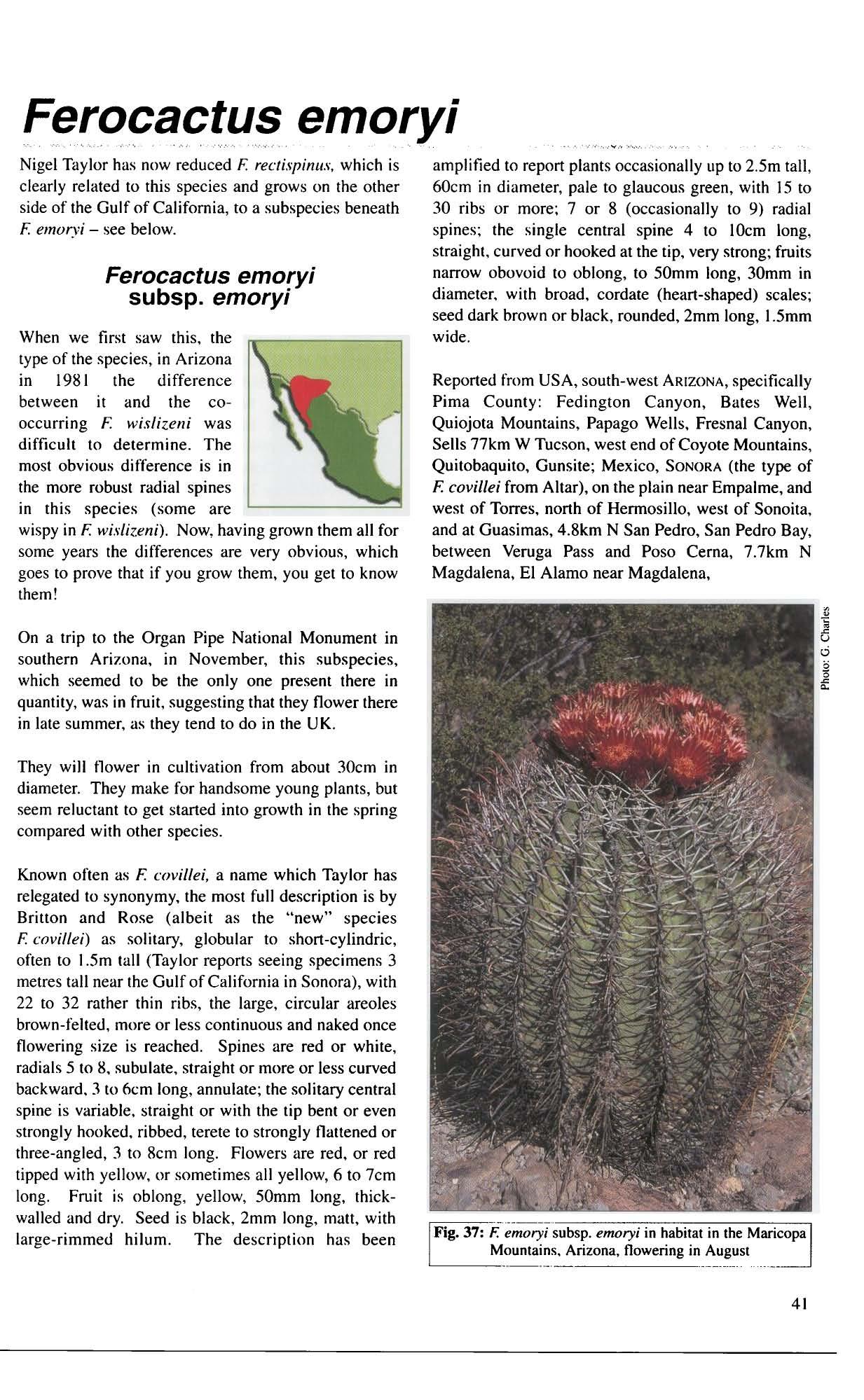
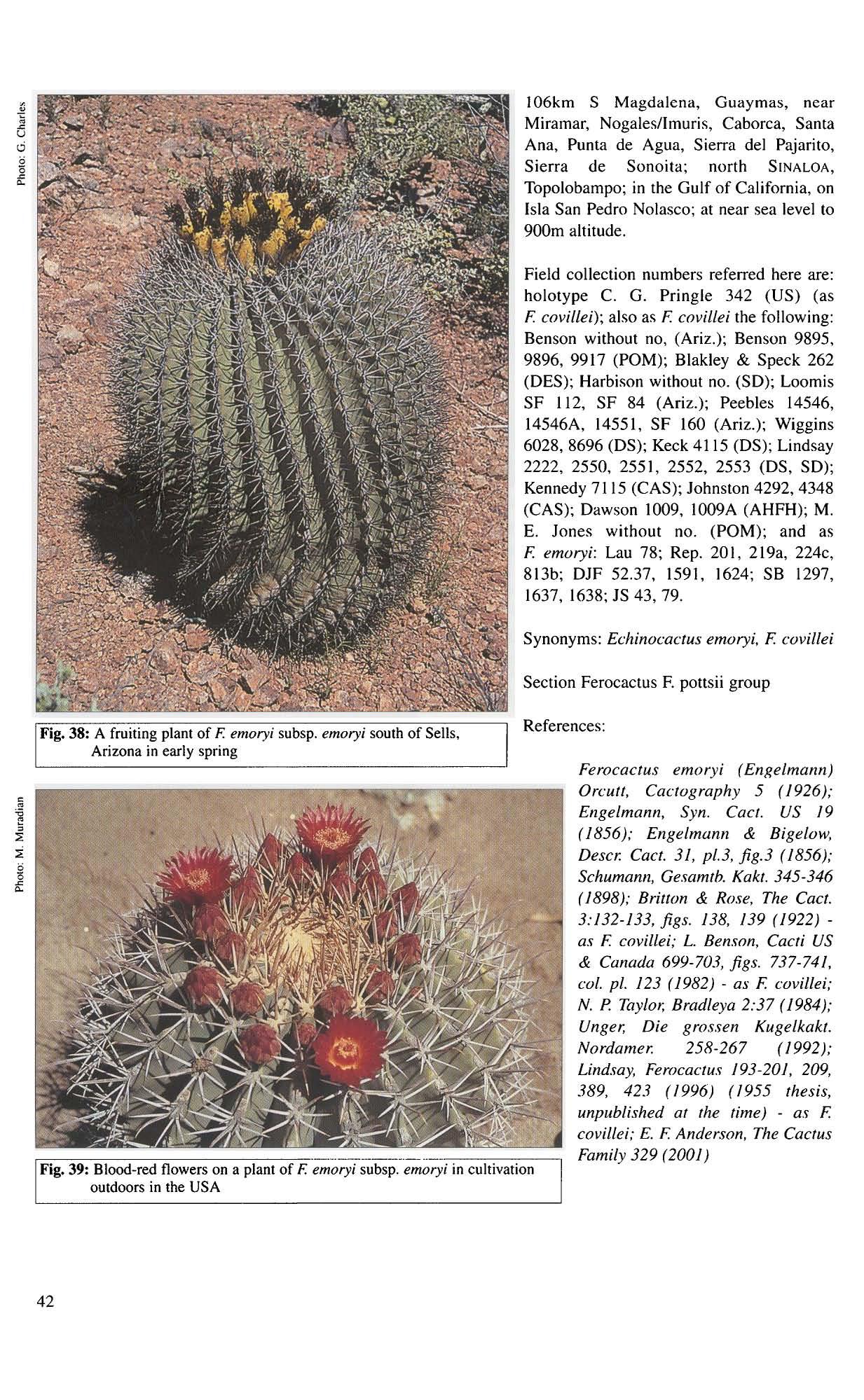
106km S Magdalena, Guaymas, near Miramar, Nogales/lmuris, Caborca, Santa Ana. Punta de Agua, Sierra del Pajarito, Sierra de Sonoita; north SINALOA, Topolobampo; in the Gulf of California, on Isla San Pedro Nolasco; at near sea level to 900m altitude.
Field collection numbers referred here are: holotype C. G. Pringle 342 (US) (as F. covillei); also as F. covillei the following:
Benson without no, (Ariz.); Benson 9895, 9896, 9917 (POM); Blakley & Speck 262 (DES); Harbison without no. (SO); Loomis SF 112, SF 84 (Ariz.); Peebles 14546, 14546A. 14551, SF 160 (Ariz.); Wiggins 6028,8696 (OS); Keck 4115 (OS); Lindsay 2222, 2550, 2551,2552. 2553 (OS. SO); Kennedy 7115 (CAS); Johnston 4292, 4348 (CAS); Dawson 1009. I009A (AHFH); M.
E. Jones without no. (POM); and as
F. emoryi: Lau 78; Rep. 20 I, 219a, 224c, 813b; DJF 52.37. 1591, 1624; SB 1297, 1637, 1638; JS 43, 79.
Synonyms: Echinocactus emoryi. F. covillei
Section Ferocactus F. pottsii group
Ferocactus emoryi (EnRelmann) Orcutt. Cactography 5 (/926); Engelmann, Syn. Coer. US 19 (/856); Engelmann & Bigelow,
Deser. Caet. 31, pl.3. fig.3 (/856);
Schumann. Gesamtb. Kakt. 345-346 (1898); Britton & Rose, The Cact.
3:132-133, figs. 138. 139 (/922) -
as F. covillei; L Benson, Cacti US
& Canada 699-703, figs. 737-741,
col. pl. /23 (1982) - as F. covillei;
N. P. Taylor, Bradleya 2:37 (1984);
Unger, Die grossen Kugelkakt.
Nordamer. 258-267 (1992);
Lindsay, Ferocactus 193-20/. 209.
389. 423 (1996) (1955 thesis,
unpublished at the time) - as F. covillei; E. F. Anderson. The Cactus
Family 329 (2001)
Ferocactus emoryi subsp. rectispinus
This is onc of the most handsome Ferocaclus to grow in cultivation. with its incredibly long central spines up 10 25cm long if given best conditions for rapid growth. and plenty of light.
When we visited the type locality in the 1980s, in central Baja California on the Gulf of California (;oast, we found several plants in the area, but almost all had spines with an illdefined hook or at least a curve at the end of them. This has been explained as hybridization or introgression with F. peninsulae by Taylor, 1984), but we were left in doubt whether this is what we were seeing, or whether this was within the normal variation of this taxon. The only examples we found with absolutely straight spines were three replanted in front of the reception area of a nearby caravan sile. To indicate the length of their spines, a penknife with both blades open (about IScm long) was not long enough to reach the fruit at the apex of the plant, without severe risk of spiking the fingers.
A small seedling plant of this subspecies purchased Tegelberg's nursery in 1981, in 24 years has grown to 50cm tall and 25cm in diameter, with absolutely straight central spines about 15 to 18cm long. deep red in colour; for the last several years it has produced clear. deep yellow Oowers. But such plants matching up to the original description arc fare in cultivation, and if grown from seed. resulting plants are often clearly this species, but seldom produce absolutely straight central spines, which with the evidence of
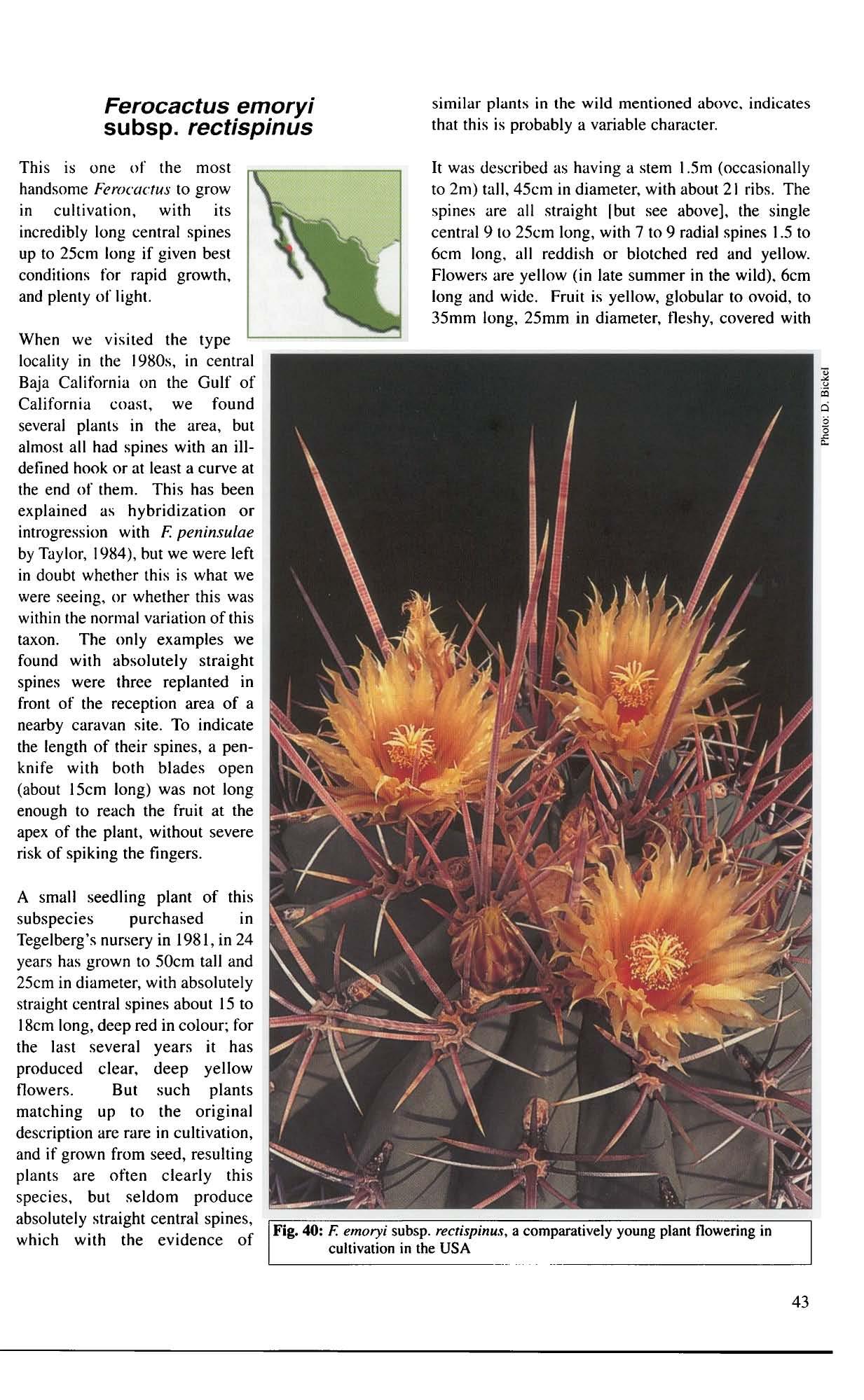
similar plants in the wild mentioned above. indicates that this is probably a variable character.
It Was described as having a stem 1.5m (occasionally to 2m) tall. 45cm in diameter. with about 21 ribs. The spines are all straight Ibut see above], the single central 9 10 25cm long. with 7 to 9 radial spines t.5 to 6cm long. all reddish or blotched red and yellow. Flowers are yellow (in late summer in the wild). 6cm long and wide. Fruit is yellow, globular (0 ovoid. to 35mm long, 25mm in diameter, fleshy. covered with
wide, brown, ciliate scales. Seed is black, 2 to 2.5mm long, 1.5mm wide.
Reported from Mexico, from the northern part of soulhern BAJA CALIFORNIA (i.e. just below the halfway mark in Ihe peninsula), from around San Ignacio to south of Loreto, specifically from Canipole. Coyote Grande (CueSla de Coyote) 32km 5 Mulege. the tip of Concepcion Bay, Nopolo, San Ignacio, Rancho el Coyole, Commondu, San Francisco de la Sierra; in volcanic rocks from near sea level 10 nearly 1,600m allitude.
Field collection numbers referred here are: holotype Gabb 12 (Mo); Lindsay 1989 (OS. SO); Wiggins 11,414 (OS. SO); Rose 16671 (CAS); Lau 1405; Rep. 275; SB 1288. 1700; LH 267.
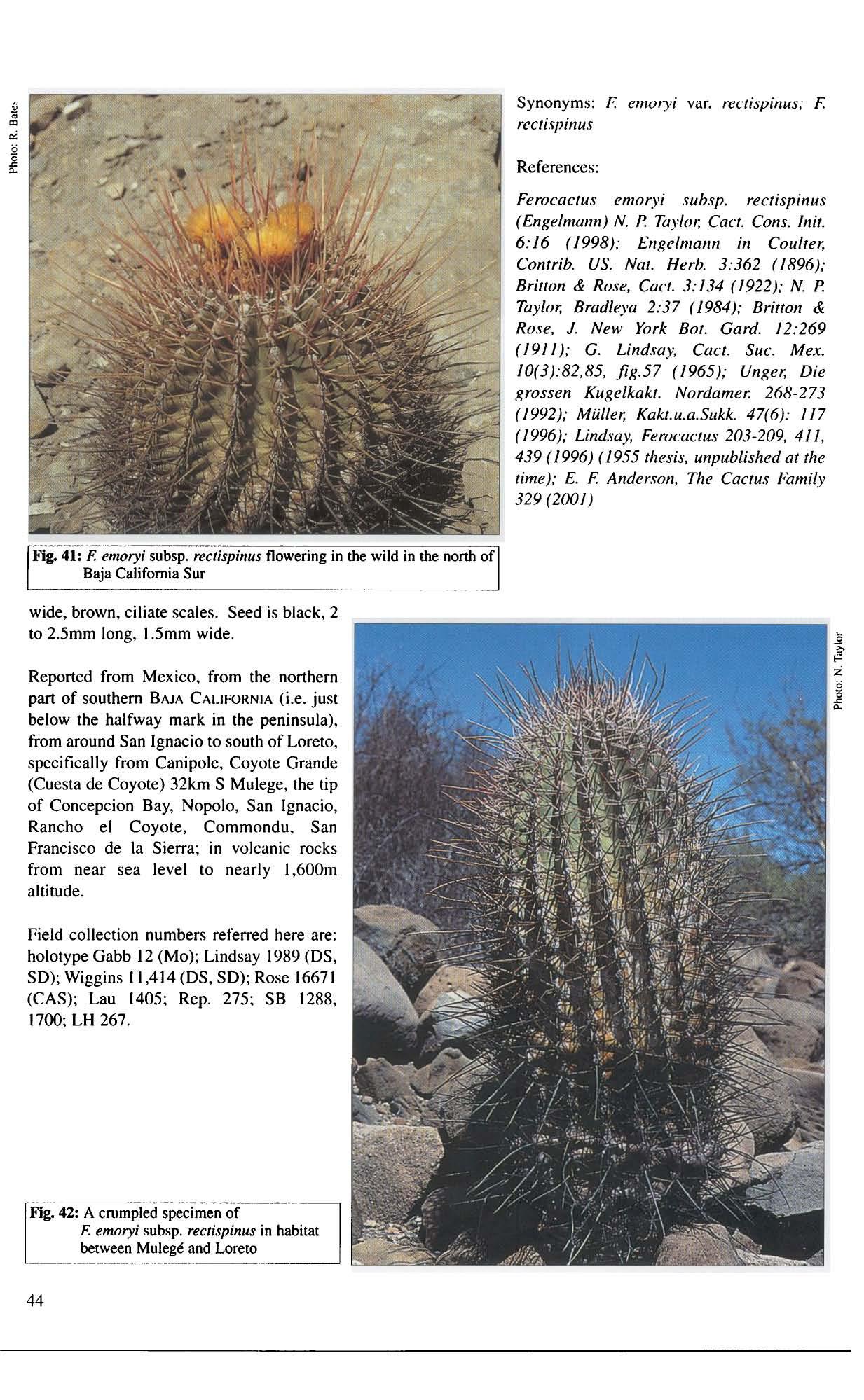
Flg. 42: A crumpled specimen of F. emory; subsp. recl;spinus in habitat between Mulege and Lore[o Synonyms: F. emory; var. rectispinus; F. recti.<ipinus
References:
Femcactus emoryi subsp. rectisp;nus (Engelmann) N. P. Taylor, Cae!. Cons. In;1. 6: 16 (1998): Engelmann in Coulter, Contrib. US. Nal. Herb. 3:362 (/896): Briltan & Rase. Cacl. 3:/34 (/922); N. p. Toy/or, Bradleya 2:37 (/984); Britton & Rose, J. New York Bot. Gard. 12:269 (1911): G. Lind.wy, Caet. Sue. Mex. /0(3):82.85. fix.57 (/965); Unger, Die grossen Kugelkakt. Nordamer. 268-273 (/992); Muller, Kakl.a.a.Sakk. 47(6): 1/7 (/996); Lindsay. FemCa('las 203·209. 4//. 439 (/996) (/955 Ihesis. anpablished allhe time); E. F. Anderson, The Cactus Family 329 (200/)
Ferocactus flavovirens
In cultivation this species needs extra wannth in winler where the temperature is liable 10 fall below rc to be sure of not damaging it. A minimum temperature of IOOC is desirable. Seedlings grown in the UK have started to fonn offsets after about 4 years from seed. and flowers of both red and yellow have been seen on plants in cullivation in North America. However, in the UK, seedlings about 10 years old from seed with about 5 or 6 stems (the biggest about 12cm in diameter) have not obliged with flowers as yet.
We saw it growing in rocky gulleys off the road from Oaxaca north to Tehuacan. near the Puebla border. where it grew in clumps of about 30 stems in the shade of sparse trees. While we were being driven along the winding. steep. mountain road with memorial cairns at almost every bend. by a young Mexican who clearly thought it imperJtive to test the suspension and holding capabilities of the car we were in. John glimpsed a clumping Ferocactus. Aware at that time of only one heavily clumping species he turned to Derek (whose eyes were shut) and said wonderingly "Does F. rohustus grow here?" Derek replied that it was probably F. jlavovirens and the opportunity W'lS immediately and gratefully laken to suspend the rapid progress of the car. in order to climb up the steep gulleys to photograph the plants.

Known and introduced into cullivation by Rose in 1906, Britton and Rose described this species briefly. based on Scheidweiler's brief account in 1841, as clustering to form great masses. pale green, 30 to 40cm tall. stems 10 to 20cm in diameter. with 13 ribs. rarely II or 12. acute and somewhat sinuate, with large. greyish. woolly areoles. Spines are pale brown. becoming grey in age. long and stout; radial spines 12 to 20. lower spines similar to centrals. but upper sometimes lighter coloured. bristle-like and sometimes twisted; central spines 4 to 6. much longer than the radials. somewhat unequal. the lower the longer. 50 to HOmm long. Flowers and fruit are not recorded. the flower buds are globular. covered with long. linear overlapping scales. their margins with long ciliate hairs.
.. .... _ ... f
Taylor (1987) amplified Ihis description to report that the plants in the wild make clusters of 2m across. the individual stems to 30 or 40cm tall. 20cm in diameter; in the field with II to IS ribs; 12 to 20 radial spines. pale brown 10 grey, long and strong. bUllhe uppermost paler and more slender. the 4 to 6 central spines light brown. much longer than the radials. unequal, 5010 80mm long. Flowers were likened 10 those of Echinocactus grusonii. from the covering of the buds with the long. imbricate scales with long ciliate hairs on the margins mentioned by Britton and Rose. but there is some confusion over the colour, some (including Taylor) reporting il to be red. others reporting yellow. about 35mm wide. wilh narrow petals, 2 10 3mm wide. stigmas yellowish; we have seen both yellow and red flowers - see photographs. Fruit is ellipsoid, 28mm long. 18mm in diameter. red with long, brown, ciliate aristate scales in rows. juicy. the pulp red. Seed is narrowly ovoid, Imm, black to dark brown.

Reported from Mexico. easl PUEBLA to northern OAXACA. on limestone; from PUEBLA, Tehuacan, road to Zapotitlan de Salinas, 9km from Tehuacan. at 1,600 to 1.900m altitude; San Antonio. Texcala. of Tehu<lcan. Santa Ana Zapulillan, Colonia San Martin, San ian de la Frontera. Acatepec; from OAXACA, Chazumba. Zapotitlan.
Field collection numbers referred here are: neotype Lindsay 2596 (OS) (also at SO); Lindsay 2059 (OS, SO); Lau 1414; Rep. 102,130; FO.70; CZJCH 157.
Synonym: Echinocactu.... jlavovirens
Section Bisnaga F. glallcescens group
References:
FerocaclIls flavoviremi (ScheidweiJer) BrillOIl & Rose, The Caet. 3:138. .fiK. 13.1 (1922): Seheidweiler, AUK. Gartellz. 9:50 (/84/): KraillZ, Die Kakleell, Lfg. 31-32, C Ville wilh figs. (/965); Krahellbuhl, Kukl,u,u.Sukk. 34(2):40-41, with figs. (/983); N. P. Taylor, Bradleya 2:20, habitat fig, p.21 (1984); & 5:95 (1987); UIIKer, Die grossell Kugelkakl. Nordamer. 397·402 (1992); Lindsay. Ferocacrus 8790, 110, 395 (1996) (1955 thesis, ullpublished 01 the rime); E. F. Anderson, The Cactus Family 329 (200/)
Ferocactus fordii
This is a species commonly seen in cultivation, as it will nower at no more than about Scm in diameter, with stunning, out of the ordinary. pink to purple nowers. Most plants in cultivation have originated from much funher north. near EI Rosario, than the original locality cited. 250km further down the coast at "Lagoon Head" (Morro Santo Domingo), and are referable to the newly described subspecies horealis.
Nigel Taylor in his review (1984) expressed the opinion that the plants from the more northerly locality are a separate taxon, as yet undescribed. having a much shorter central spine than that described for the species. Following a meeting of minds with the authors he has now described this hitherto nameless but common-in-cuhivalion taxon. see subsp. horealis below.
jFig. 46: F.jo-;:;iiis'Jbsp-:jordii on the way to Bahia
I Tortugas. near Scammon's Lagoon. Baja California. I I Mexico. surrounded Mesembr),onthemum by foreign invaders. cr)'stallinum
Ferocactus fordii subsp. fordii
This was described by Brinon and Rose as globose 10 shortcylindric. greyish-green, to 12cm in diameter. with usually 21 ribs: radial spines aboul 15. whitish, needle-like. widely spreading: central spines number usually 4. one flattened. p<mect. longer than the others. to 4cm long (to 7cm according to Taylor). curved or hooked at the tip. the other cenlmls subulate. somewhat angled: flowers are rose coloured. 35 10 40mm long. stigmas greenish-yellow 10 whitish. Fruit is ovoid. pink to greenish-yellow. Seed is more or less round in outline, 2mm in diameter. mati black.
Plants we found between Rosarito and Guerrero Negro, in flat. sandy soil. certainly had a much longer hooked central spine than those of subsp. boreaJi.'i we had seen much further north, and were significantly

showing no sign of flower, although those of subsp. borealis we had seen a few days before were in full flower at this time, in the spring. Plants from even further south, near the Laguna Aguna 0'Jo de Liebre showedeven more robust spine development. These were beautifully pictured in the article in Cactus & Co. (2002). ref. below.
This comparatively unknown subspecies may prove more difficult to grow in cultivation than its more northerly brother because of its more harsh habitat, but our limited experience of growing it has not presented any unduc problems, except that it seems unwilling to flower at such a precocious age as the better known subsp. borealis, and seed has proved hard to come by.
Reported as expounded above, from Mexico, northern Baja California, on the west coast. 'Lagoon Head' (Morro Santo Domingo), and near the coast as far north as Punta Blanca at near sea-level to 50m altitude, in flat. sandy areas.
Field collection number referred here is only the type. Orcutt (US 1821079).
Synonym: Eehinoeaetus fordii
Section Ferocactus F. robuSlus group
References:
Ferocaclus fordii (Orcutt) Britton & Rose. The Caet. 3:/26. jig./32 (/922) (jig.132 is a monochrome reproduction ofplate I J ofSchumann, BlUhende Kakt. / (/903)); Orcutt. Rev. Cact. /:56 (/899): & 2:8/ (/900); G. Lindsay. Cact. Succ. J. (US) 27(6): /64-/65 (/955); N. P. Toy/or, Brad/eya 2:34 (/984); Lindsay. Ferocactus 257. 426 (/996) (/955 thesis. unpublished at the time); E. F. Anderson, The Cactus Family 329 (200/); J. Etter & M. Kristen. Cactus & Co. 6( I):2023 (2002).
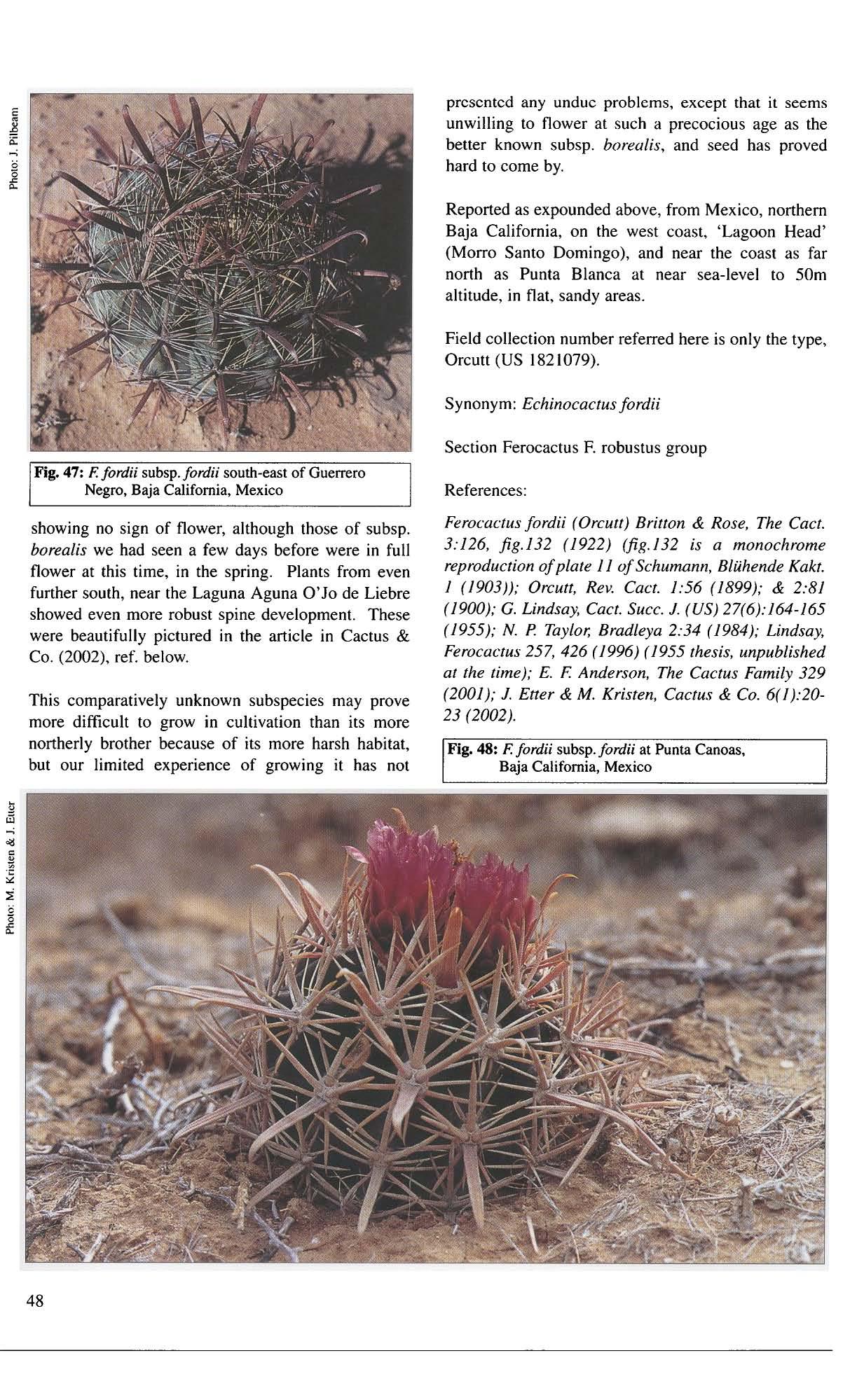
Ferocactus fordii subsp. borealis
Named for its more northerly occurrence, this subspecies is by far the more commonly seen in cultivation.
As indicated above Nigel Taylor has only recently described this subspecies, so long languishing in our care without a proper name. Since the publication in which the description is not widely circulated it is repeated in
full here.
"In Bradleya 2:34 (1984) I commented that the northern disjunct variant of Ferocactus ford;; might require a name. It remains much bener known in cultivation than the southern 'type' variant. Subsequently the late Charles Glass indicated to me that he too believed it was worthy of description and probably a threatened taxon, whose naming would increase its chances of being conserved in the wild. More recently, John Pilbeam and Derek Bowdery have written a soon-to-be-published account of the genus for the benefit of amateur growers and John has encouraged the following diagnosis to be published Ferocactus ford;; subsp. borealis N. P. Taylor subspecies nova a subsp. fordii spinis centralibus infimibus brevioribus (usque 4cm nee 7cm) minusque prominentibus et fJoribus coloratis saturatioribus differt. Holotypus: Mexico, Baja California Norte. Bahia San Quintin, 1984, D. 1. Ferguson 8 (seed), initially cultivated by S. Brack, Mesa Garden Nursery (USA), then cultivated (ex seed from controlled pollination of above) by D. Bowdery. July 2002 (Kin spirit)."
We saw and delighted in this subspecies on our first visit to Baja California, and sought it out eagerly on subsequent trips. After seeing the similarly low growing F. viridescens as our first Ferocactus in this wonderful peninsula, with greenish-yellow flowers the rich pink flowers of this subspecies were a colourful surprise, and the cameras clicked as we saw plant after plant in flower, none larger than about 18cm (7 inches) in diameter, and a little shorter than wide, except for the odd one or two which had found a little shade and were globular.

The new central spines (usually 4) add to the colouring, being glowing red. fading to brown and then grey as they age; the lower. stronger of the central spines is fiercely hooked. and as Nigel Taylor describes it above. is shorter than that in the type, up to 4cm long. never 7cm as in the type. The nIdial spines are thin and flexible. with a few wispy bristlelike spines as well. more in older plants. Flowers vary from rich pink to almost purple pink. more deeply coloured than in the type. Reponed from northern BAJA CAUH)KNIA, west coast between San Antonio del Mar and EI Rosario. 30 t( 31° N. and on Isla San Martin, EI Socorro, Sante Domingo Lagoon. N of Santa Maria Lagoons. Sar Simon hill and about 16km E San Quintin Bay. Sar Quintin, Cabo Colonet; on coaslal sund dunes and flat grassy areas from near sea-level to 100m altitude.
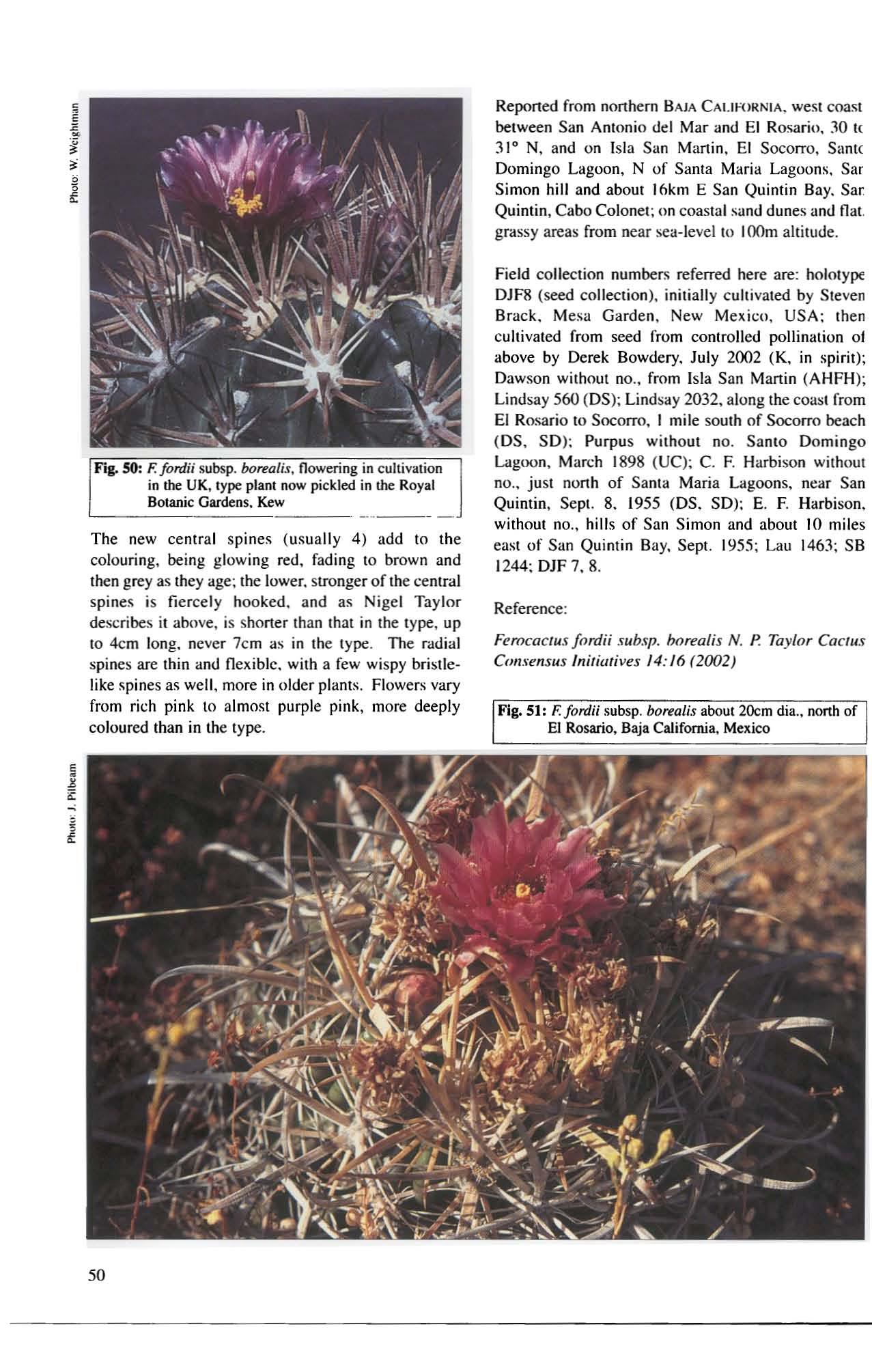
Field collection numbers referred here are: holotype DJF8 (seed collection). initially cuhivated by Steven Brack. Mesa Garden, New Mexico. USA: then cuhivated from seed from controlled pollination of above by Derek Bowdery. July 2002 (K. in spirit); Dawson without no., from Isla San Martin (AHFH); Lindsay 560 (OS); Lindsay 2032. along the coast from £1 Rosario to SocDrrD. I mile sDuth Df SOCDrro beach (OS, SO): Purpus withDut nD. SanlO DDmingo Lagoon. March 1898 (UC); C. F. Harbison without no.• just north Df Santa Maria Lagoons. near San Quintin, Sept. 8. 1955 (OS. SO); E. F. Harbison. without nD., hills of San Simon and about 10 miles east of San Quintin Bay, Sept. 1955; Lau 1463; SB 1244; DJF 7. 8.
Reference:
Femcaclus fordii .'iUbsp. borealis N. P. Taylor Cactus Cmu"ensus Iniliatives /4: /6 (2002)
Ferocactus glaucescens
One of the most commonly grown Feroc.:actus species. this one will flower at no mOTe than 15cm in diameter, given a favourable. sunny position. The glaucous blue body makes it a favourite with enthusiasts for this genus, the yellow spines contrasting wonderfully with the and the unusual, while fruits are unique in the genus. also contrasting well with the blue body. In cultivation plants will cluster and make very handsome. large dumps. 60cm or more in diameter, rarely more than about 30cm tall. Plants we saw in the Mexican siale of Queretaro, growing with Thelocactus hastifer. were in great slabs of rock in cracks, barely making large football size and solitary.
It was described by Brinon lind Rose as globular, 20 to
40cm in diameter. or a lillie higher than broad, glaucous, with II to 15 ribs, somewhat flattened, acute; areoles oblong. yellowish, woolly when young; radial spines 6, nearly equal. rigid. slightly spreading, straight. 25 to 30mm long. pale yellow at first, blackish when old. more or less banded; central spine solitary. similar to radials: flowers yellow, 2cm long, perhaps wider fully expanded. stigmas cream coloured. Taylor added that the planls were solitary or clustering. globular 10 cylindric. to 45cm, or sometimes to 70cm tall. and to 50cm. sometimes 60cm in diameter, usually glaucous. with II to 34. sometimes to 44. ribs. There are 4 to 7. sometimes 8 radial spines more or less equal in lenglh, to 25mm. somelimes to 35mm long. yellow; one similar central spine. sometimes not present. Rowers are yellow, 20 to 45mm long. 25 to 35mm wide. with cream coloured stigmas. Fruit is globular or egg shaped. 15 to 25mm long. 20mm in diameter, whilish or yellowish tinged red. with yellowish. ciliate scales. juicy. Seed is dark reddish-brown to black, very smooth. shiny. 1.5 10 1.8mm long.
Reported from the Mexican slates of HIDALGO, QUERETARO and SAN LUIS POTosi: specilically from HIDALGO. Canon de Venado near Metztitlan, San Cristobal to Metztitlan. Zimapan, Tlatepeche and Tolantongo. Xhaja. Jacala; from QUERETARO. Villa Hennosa. west of Jalpan. Bucareli: from SAN LUIS POTosi. Arroyo Carrizal. Las Rusias. Sierra de Alvarez. on the road from Zimapan to Tamazunchale.
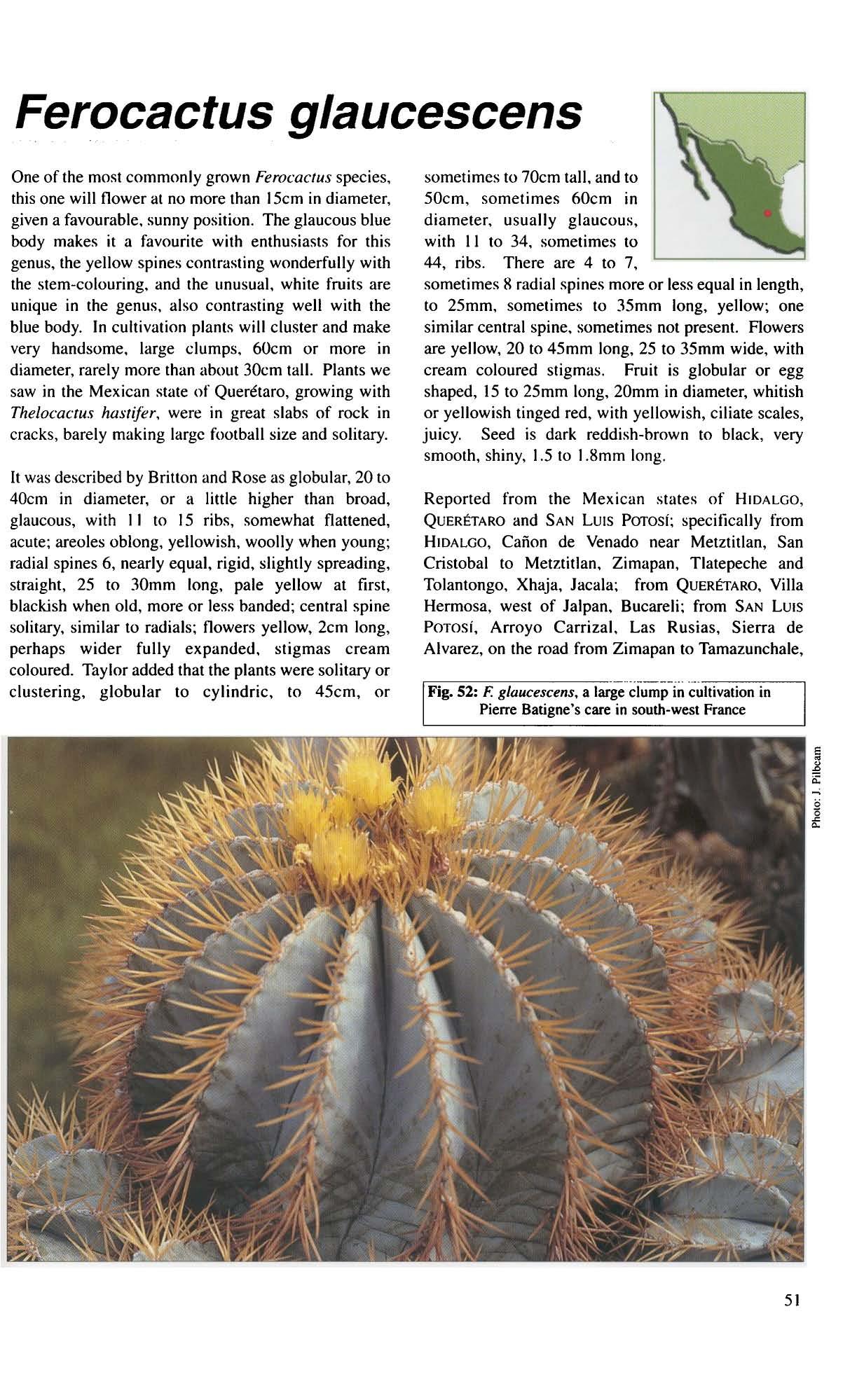
and east of the town of San Luis Potosi; on limestone, 1.000 10 2,300m altitude.
Field collection numbers referred here are: neotype Lindsay 2611 (DS)(also at SD); Lindsay 2063 (DS); Schwarz without no. (DS); Lau 1240; Rep. 50. 299,353. 10011, 1144d, 1145b, 1708a, 1907b; CZlCH 249.
Synonyms: Bi.\"naga g/llIlCl::sCi!ns. Echinocactus pfeiffer;

Section Bisnaga F. glaucescens group
References:
Ferocactus glaucescens (De Condolle) Britton & Rose, The Coet. 3: J37 (/922); De Candolle, Mem. Mu.... Hist. Nat. Paris 17:115 (/82819); Sanchez· Mejorada, Caet. Sue. Mex. 10(3):66, 72. figs, 38. 42d, 43d (/965); Bracamontes, Caet. Sue. Mex. 23(2):42 (1978); G. Unger, Kakt.u.a.Sukk. 29(8):187 (/978); N. P. Tay/or, Bradleya 2:23 (/984); Unger, Die grossen Kugelkakl. Nordamer. 373-381 (/992); Undsay, Ferocactus 95·99, //0, 399, 427 (/996) (/955 the.,is. unpublished 01 the time); E. F. Anderson. The COL'fUS Family 330 (2001)
Fig. 54: F. glaucescens. an unusually large clump in habitat near Zimapan, Hidalgo. Mexico
rF"lg. 53: F. glaucescens floweringI L .. in cultivation in d_i_a. the UK at ...J
ferocactus gracilis
The red spination and slender stems or this species make it one of the most beautiful to come across in the wild in Baja California, especially in the area around Cataviiia, where it grows among huge boulders. sometimes being naturally bonsaied by growing out of cracks in the rock. In cultivation it will produce its glowing, red flowers when it has grown to about 20cm tall and 12cm or so wide, after about 10 years jf it is potted on regularly in the early years, and grown on as fast as local conditions will allow. Growing this and other species out of doors in the summer will enhance the spine development. increase the chance of flowering, keep the nectar down (by means of ant activity or occasional showers of rain) so as to lessen the chance of it being a lodging house for sooty mould.
With its comparatively northern occurrence in the Baja California peninsula, it is surprising thai this colourful, intensely red-spined species was not described unlil 1933, and the question that springs to mind is what did earlier explorers think it was, a form maybe of F. peninsulae. anticipating Unger's current opinion thai it is a variety of thai species? We are happy to go with others, endorsed by the 1999 CITES Cactaceae Checklist, and regard it as a good species.

Ferocactus gracilis subsp. gracilis
This, the type. was described by Gates as usually solitary. globose to cylindric. to 3m tall (most commonly about half this heighl). 30cm in diameter. with 24 ribs. prominently tuberculate: areoles narrowly elliptic, 15mm long. There are 10 radial spines usually 5 on each side of the areole. at first parallel. later more spreading. needle-like. whitish becoming dark grey in age. 25 to 40mm long: central spines 7 to 13. variable. subulate except for the upper middle one. which is ascending and llattened on both sides, and the lower middle one. which is rounded below, slightly concave above. more or less convolute and occasionally hooked on younger plants, all ribbed, sharp. dull dark red with paler tips on some. all becoming black in age. as well as appressed and interlocking. Flowers were described as straw-yellow with maroon stripe down the outer surface centre of
each petal (bm on opening the impression is of distinctly red flowers in our experience), fruit Oblong, yellow, seed black, shining. Taylor adds that stems are solitary unless damaged, but we have seen aged specimens still growing at the apex, but clustering from around the base, stems with 16 to 24 ribs, somewhat IUberculate; the 8 to 12 radial spinesare slender. whitish, with in addition 9 to 12 stouter upper and lower radial spines; there are two central spines, red with yellow tips, the largest to 7cm, flattened, pointing downwards and more or less curved at the tip, with one upwardly directed central spine also flattened. Flowers appear in the summer, 40mm long, 35mm wide. Fruit is oblong to cylindric. 40 to 45mm long, 25mm in diameter, yellow, sometimes tinged reddish. with sclerous (hard) scales. Seed is 1.75 '0 2.25mm. 1.10 to I .35mm wide, shiny black.
Reported from Mexico, central to northern BAJA CALIFORNIA, from the Sierra San Miguel (Arroyo Socorro) to the vicinity of Jaraguay, south of Cataviria.just inland from El Rosario to below Punta Prieta, Viscaino Desert on granitebased substrate, Mision San Fernando. Cardonal; at 20-3OOm altitude.
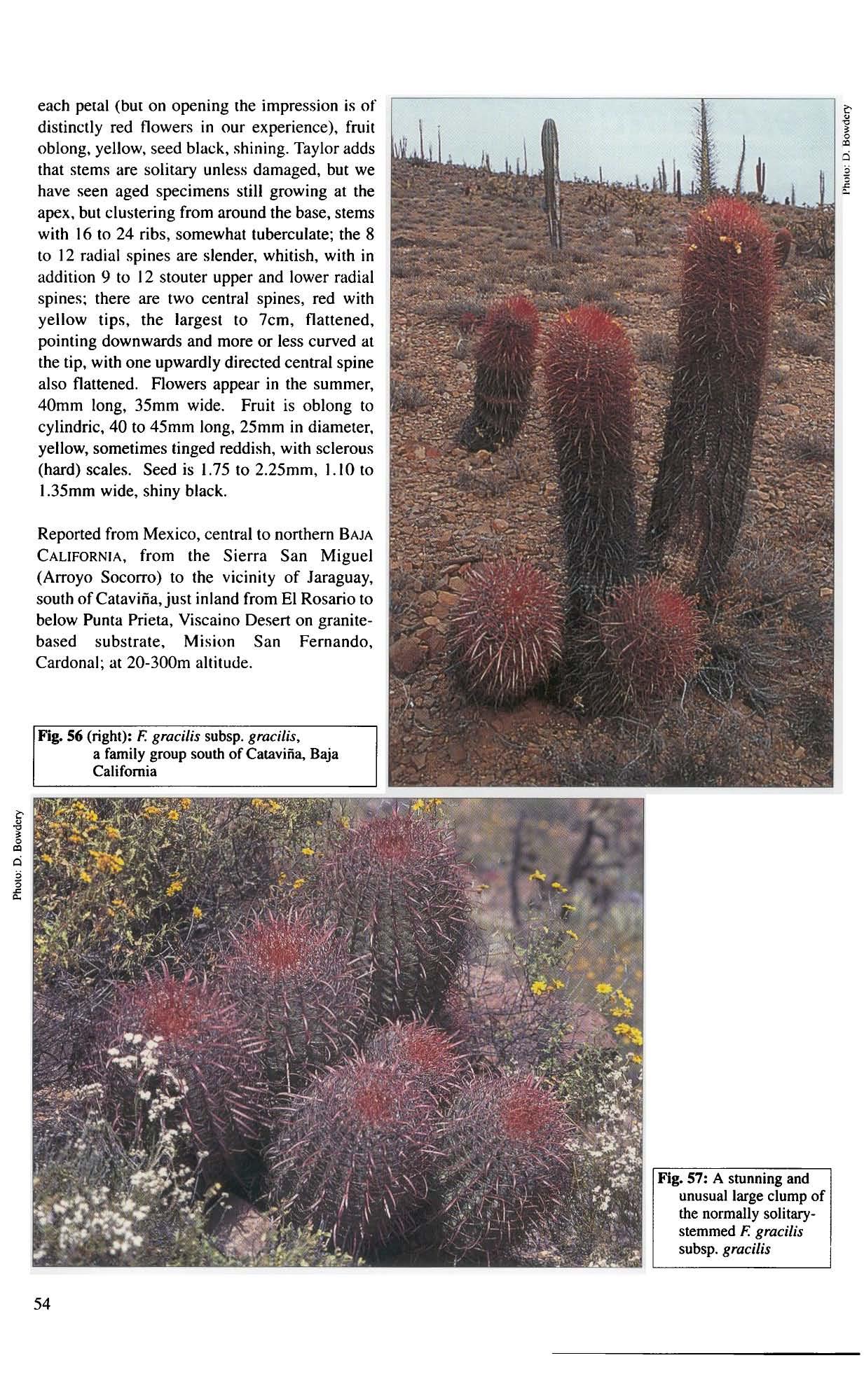
Fig. 57: A stunning and unusual large clump of the normally solitarystemmed F. gracilis subsp. gracilis
Field collection numbers referred here are: holotype Ga'es 22 (DS); Lindsay 1846 (DS, SD); Lall 1216; Rep. 257, 267; S8 1280, 1281.
Synonym: F. peninsu/ae var. graci/is
Section Ferocactus F. robustus group
References:
Ferocaclus gracilis H. Gales, Cact. Sua;, J, (US) 4(8):323·324, wilh jig. (1933): Lindsay, Cacl. Sue. Mex. 10(3):76·91,jig.61 (/905); N.P.Taylor. Bradleya 2:30 (/984): Unger, Die grossen Kugelkakt. Nordamer: /93-/97 (/992) - as F. peninsu/ae var: gracilis: Lindsay, Ferocactu.\· 239·252, 280. 401, 428· 430 (1996) (1955 Ihesis, unpublished althe lime); E. F. Ander.wm, The Cactus Family 330 (2001)
Ferocactus gracilis subsp. coloratus
This subspecies, like the type. is noted for its wonderful red spines. which after a shower of rain positively glow in Iheir brightness. The cenrral spines are much stronger and broader than the type, and flattened, and this is the most obvious difference from Ihe type of the species. although intermediates can be found when lravelling from north to south in its range. Gates got Ihe name "coloratus" from the nalive "colorado" (red) used to distinguish this plant from others in the area by the colour of its spines; this local name would have applied equally of course to the type of the species,
It was described by Gates (as a species) in 1933. as solilary, globose to sub-cylindric, 101m tall (much shorter than the type), 30cm in diameter. with 13 ribs on young plants, increasing to 20 on mature specimens, Radial spines 10-14, bristle-like. or the lowennost on each side occasionally like the smaller of Ihe central spines. spreading and slighlly curled, dull white. Cenlral spines 9 or sometimes apparenlly II when the Iwo previously menlioned radial spines become well developed, sliff, robust, spreading, ribbed, bright brownish-red, all straight and sharp except the middle lower one. which is flattened 10 Icm wide and becoming 5cm long. more or less concave above, frequently bifid (divided in two) to the base, porrect or slightly deflected, the tips recurved and hooked. The upper middle spine is also flattened bUI straight. Flowers slraw-yellow wilh a reddish-purple slripe down the exlemal surface of each perianth segment. Fruit not seen by Gales.
This subspecies is considered by Taylor dislinct from the type in ils separate occurrence and its earlier flowering. In his review Taylor describes it as having a generally slouter slem, 102m tall. the spinalion very variable. but often exposing more of Ihe stem than the type. The radial spines range from twisted and hairlike to stiffly needle-like. oflen fewer Ihan the type or not present. Central spines are very broad or narrow, the lowermost slightly to slrongly curved at the lip, sometimes reduced to 5 or even 3. Flowers (in spring) 50mm long and wide, red or with the margins of the petals yellow. Fruit is yellow, Seed is 2mm long. matt black.
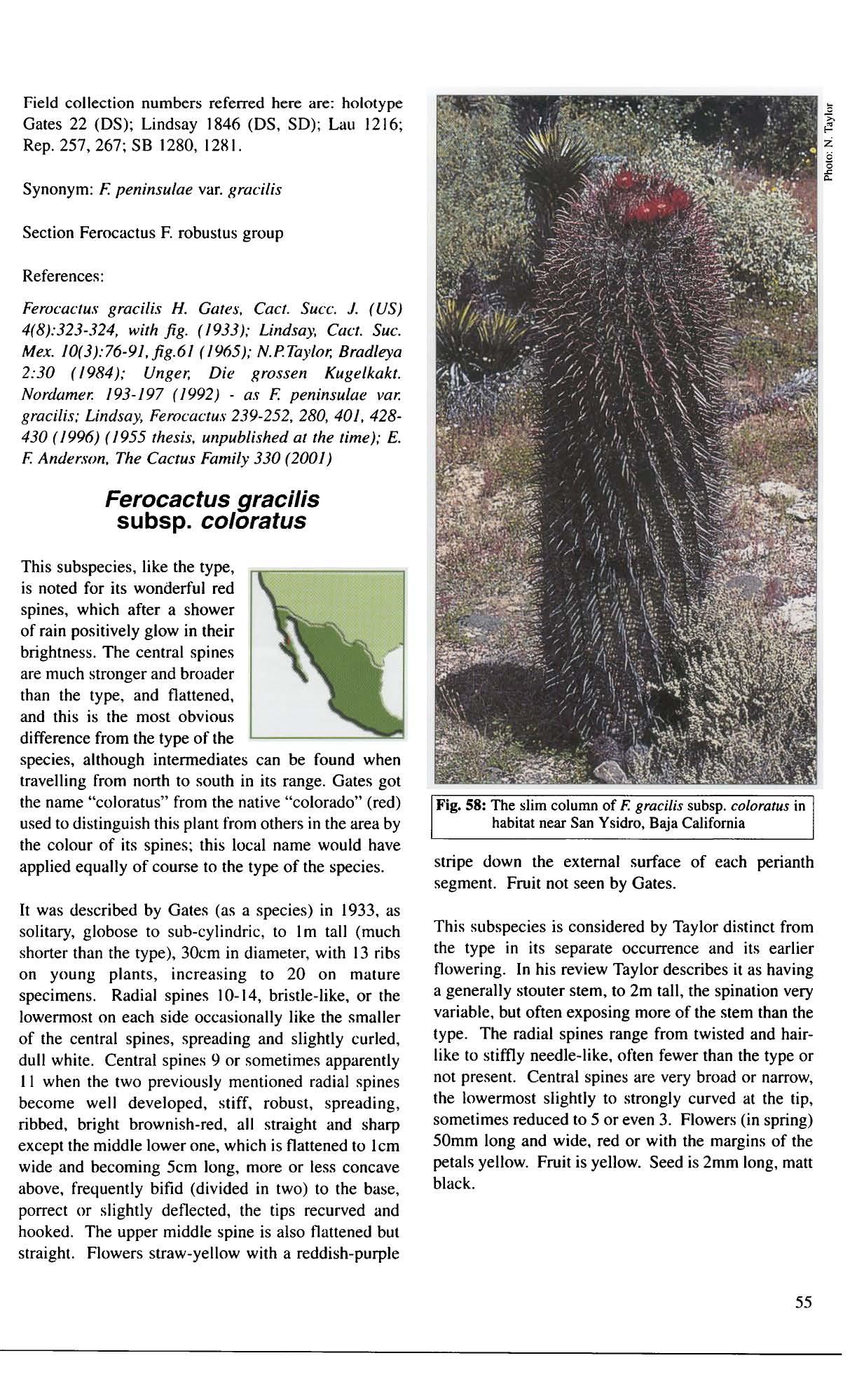
Reported from Mexico, in the south of the northern part of the BAJA CALIFORNIA peninsula. from aboul EI Crucero (south of Laguna Chapala) 10 the vicinily of EI Arco (280 N), wesl to the coaM at Miller's Landing; Vizcaino Desert in sand or on granite; Santa Rosalillila, and EI Tomatil, 8km N of Mesquital. Rancho Tabalon; at 10-1 OOm altitude.
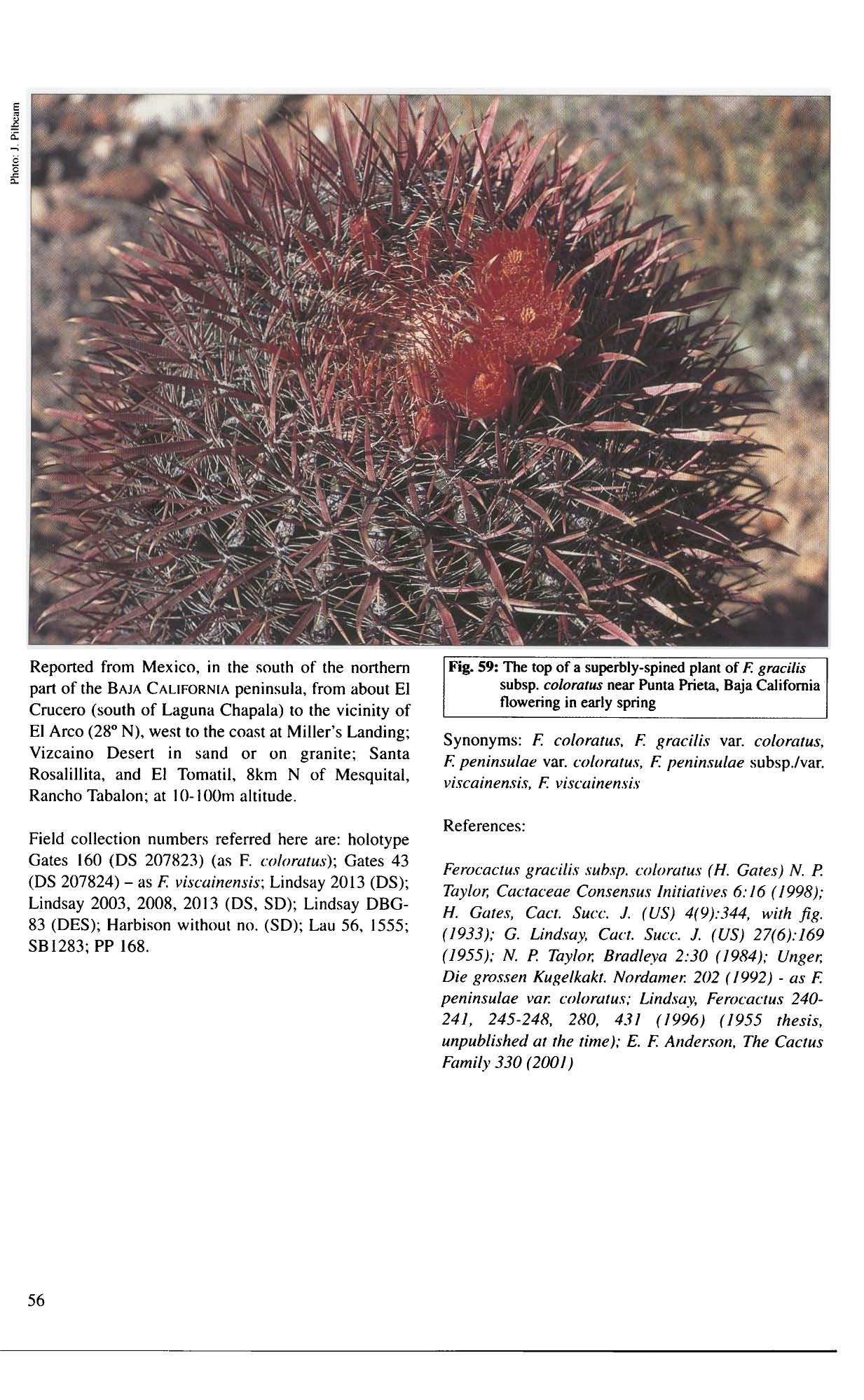
Field collection numbers referred here are: hololype Gates 160 (DS 207R23) (as F. coloratu.\·); Gates 43
(OS 207824) - as F. vheainensis; Lindsay 2013 (OS); Lindsay 2003, 2008, 20D (OS, SO); Lindsay DBG83 (DES); Harbison wi'hou' no. (SO); Lau 56, 1555; SB1283; PP 168.
Synonyms: F. coloratlls, F. gracilis var. coloratus. F. peninsulae var. (:oloratus. F. peninsulae subsp./var. viscainensis. F. viscainensis
References:
FerocaclUs gracilis subsp. coloratus (H. Gates) N. P. Taylor, Ca(·taaae Consensus Initiatives 6: 16 (1998);
H. Gates, Caet. Suec. J. (US) 4(9):344, with fig. (/933); G. Lindsay, Caet. Suec. J. (US) 27(6):169 (/955); N. P. Taylor, Bradleya 2:30 (/984); Unger,
Die grossen Kugelkakt. Nordamer. 202 (/992) - as F. peninsulae var. coloratus; Lindsay, Femcactus 240-
Ferocactus gracilis subsp. gatesii
Plants grown from seed sown in 1981 are very similar in appearance to F. gracilis, and Nigel Taylor's recent placing as a subspecies here makes good sense.
This disjunct island subspecies is worthy of detailed considenttion by the collector. being. as many of the island dwellers are, different enough from the collector's point of view to warrant its inclusion in a collection, whatever its slatus. Unfortunately it is nol often seen commercially because of its remole occurrence on small Baja California islands in the Gulf of California near Bahia de los Angeles. not the mosl accessible or hospitable of islands, and with no guarantee of course for those who do tind their way there. of finding ripe fruit and seed of this species at thai time. Alfred Lau visited Isla Vemana in the early 1970s, and seed he collected at that time is probably the source of most larger plants in cultivation today. He reported that the island is nearly totally infertile wilh liule vegetalion, the cacti there (this species and Mammillaria insularis) growing in shallow valleys between rolling hills, in mineral soil. Paul Hoxey also visited the island more recently and describes how it is mostly surrounded by steep cliffs unsuitable for landing. but there is a small bay favoured by local anglers as a resting point, with a gently sloping beach. From there a path led up into the hills, where there were loose granile rocks with sparse it is as Alfred Lau indicated a very dry, nearly barren place. The plants of this FerocauuJ grew among the loose rocks, and there were plants of all ages from small seedlings no more than 2cm across to large, aged plants nearly 1.5m tall, the base of the latter losing their spines and discolouring. Plants in flower included some al only about 12cm in diameter (excluding the spines). As well as the encouraging evidence of regeneration, it was the most numerous of the larger plants on the island, which included an Agave, a Bursera growing low to the ground with swollen stems, a few Pachycaeus pringlei, a Fauquieria, two different species of Opun/ia and Mammillaria dioica and M. insularis. There were many Feroeae/uJ in abundant flower and with ripening seed pods, with no evidence of predation evident.
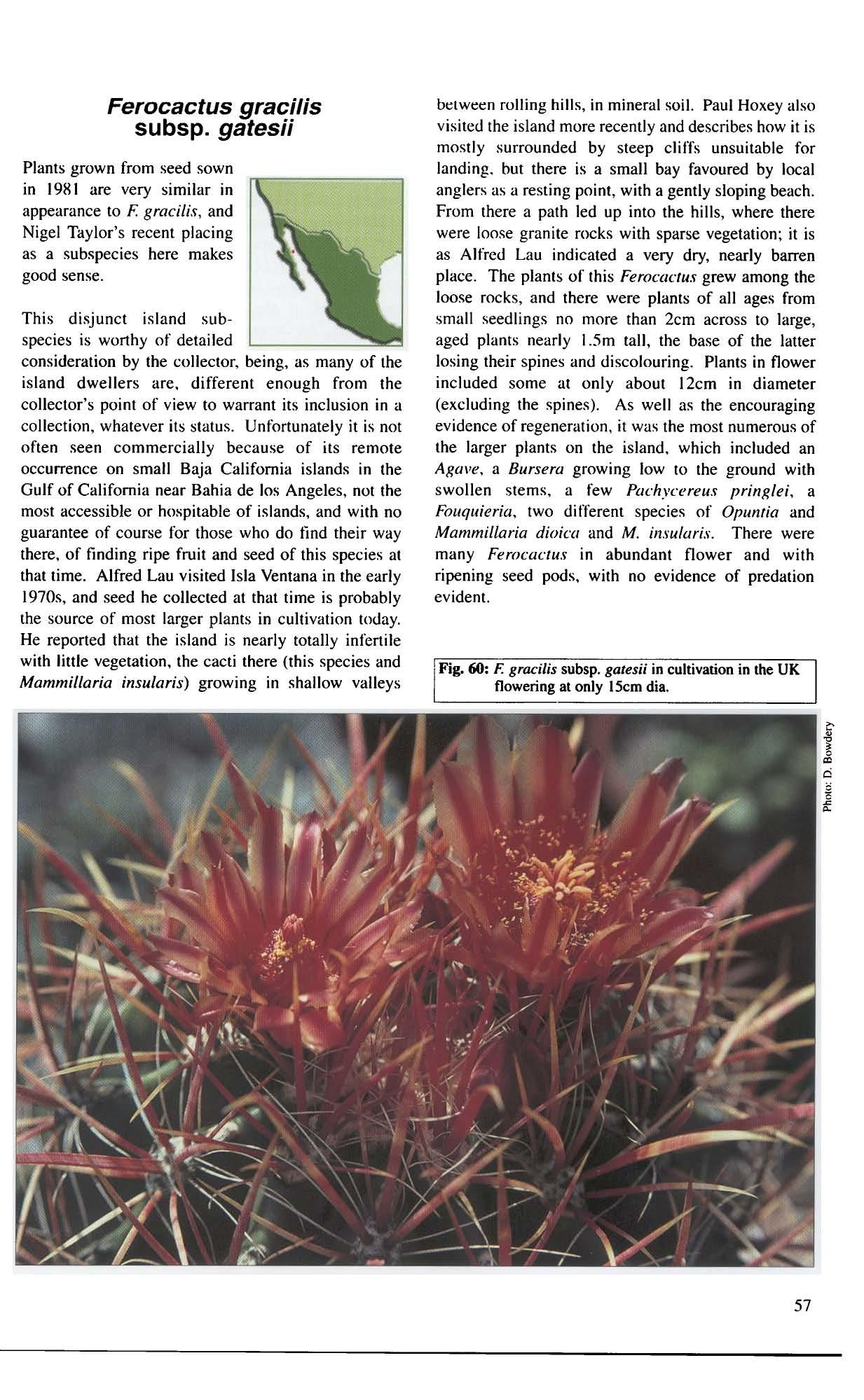
It was described as solitary, globose to short-cylindric. to 1.5m tall, 30cm in diameter, with 30 to 32 acute ribs. There are about 16 radial spines, those at the sides thin, twisted and bristle-like, the two or three at the top and at the bottom of the areole, stronger and ribbed, similar to the usually 4 central spines, pink, yellow or brownish-yellow, ageing to grey, tlauened and ribbed. to 70mm long, 3mm wide, the lower the longest, curved at the tip, but not hooked. Flowers are large. to 60mm long and wide, red, the inner petals with yellow margins, stigmas yellow. Fruit too is large, elongate. to 75mm long, 25mm in diameter, yellow. Seed is black, to 2.5mm long, I.75mm wide.
Reported from Mexico, BAJA CALIFORNIA, in the Gulf of California, on Isla Ventana, a small islet in the Isla Smith group. on the north side of the entrance to Bahia de los Angeles, 28" 59.5' N, 113" 32.5' W, and known only from islands and islets in this bay; at I-150m altitude.
Field collection numbers referred here are: the type, Moran 4103 (OS); Lindsay 2240 (OS, SO); Lau 24.
Synonyms: F. gatesii, F. x gates;; Ferococrus gracilis subsp. gatesii (G. Lindsay) N. P. Taylor; CaClaceae Consensus Initiatives 6: 16 (1998); G. Lindsay, Cael. Succ. J. (US) 27(5):/50-/5/, figs./46, /47 (/955); N. P. Taylor, Bradleya 2:30 (/984); Unger; Die grossen Kugelkakt. Nordamer. 238 (/992) - as F. X galesii; H. Muller, Kakl.u.a.Sukk.47( 11): Karl 2/ (/996); Lindsay, Feroeaelus 249-252, 397 (/996) (/955 Ihesis, unpublished at the time) - as F. gatesi;; E. F. Anderson, The Caelus Family 330 (200/)
Fig. 61: F. gracilia subsp. gOlesii leaning towards the sea on Isla Ventana. part of the Smith group of islands in the Gulf of California. Baja California, Mexico
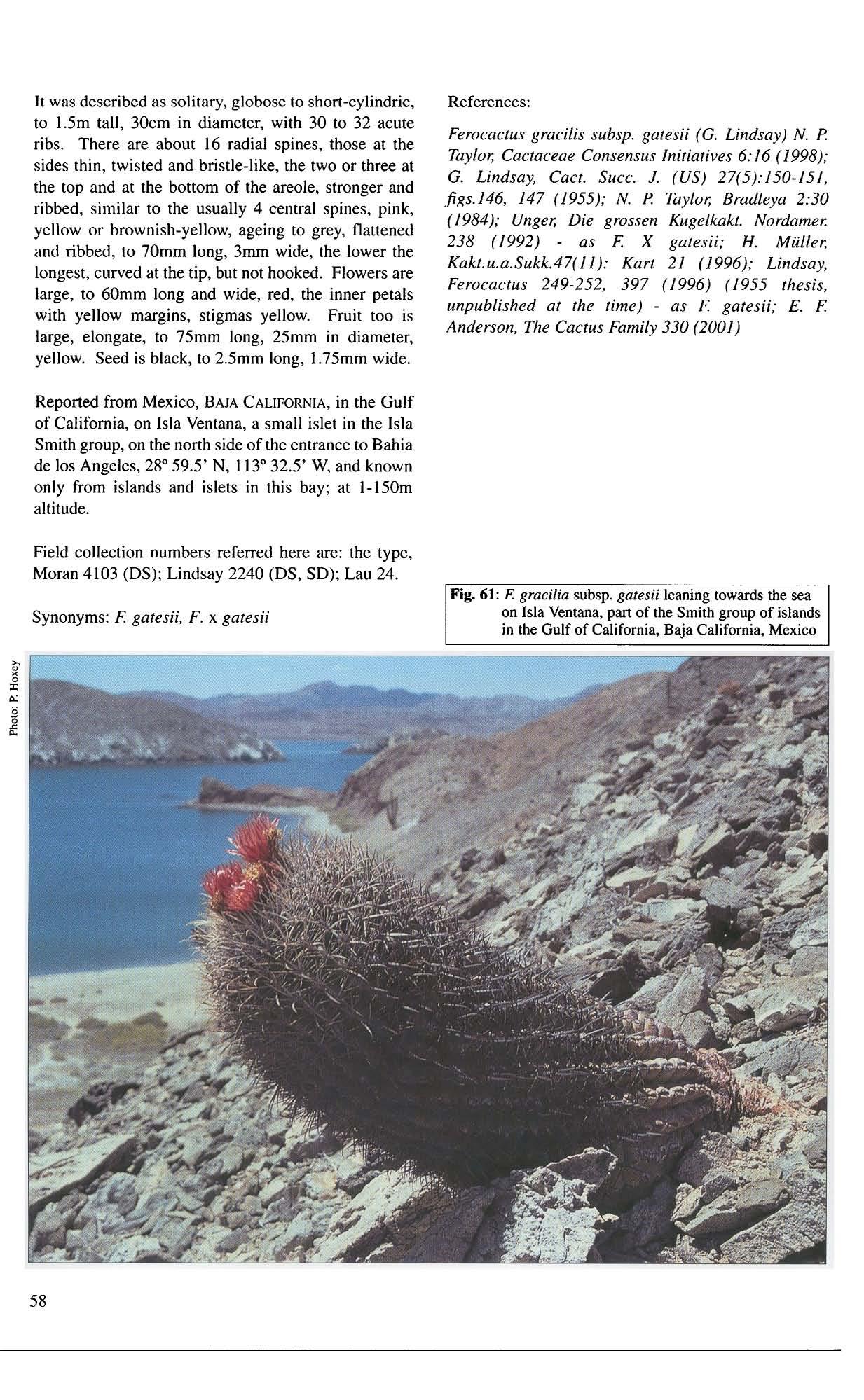
Ferocactus haematacanthus
This is a slow growing species in cultivation, and seldom seen. A more or less globular plant at least 20 years old in Derek's collection has reached only about 25cm in diameter. and has yet to oblige with flowers. but the areoles have started to coalesce and form a continuous woolly rib. and hopefully will nower within the next few years; in recent years during the spring buds have formed but aborted. The stems are a most anractive. pale. apple green, contrasting well with the blood-red spines. which have a continuous. scimitar-like curve. Coming from southern Mexico. in Puebla. a higher temperature than for most Ferm.:actu.'i species is probably required to ensure the plants do nO( suffer.
Plants seen in the wild in March/April, in grassland, had dark reddish-purple buds. promising flowers wilhin a few weeks. but not unfortunately while we were able to see them. and we are indebted to Salvador Arias Montes for his photo of this species taken at a more propitious time.
Brillon and Rose admitted that they did not know this species. and in view of its southerly occurrence in Puebla. this is not surprising. They repeated Weber's description of 1896. who described this species as simple, sometimes perhaps proliferous. short-cylindric. 50cm tall, 30cm in diameter. with 12 to 20 ribs. stout, light green. Spines are all straight, reddish with yellowish tips. the radials 6, the centrals 4, 3 to 6cm long. Flowers are funnelform. 6cm long. purple; scales of ovary round, whitemargined. Fruit is ovoid. 30mm long. deep purple.

Charles Glass, who took us to see this species in the wild a few years ago, pUblished a more detailed description of it in his last publication. whicb is worth repeating. as it was based on detailed observation in the field. He pictures a rare cluster of about 6 stems, looking to be about a metre tall. and describes the species as up to 1.2m tall, 38cm in diameter. ribs 13 to 27. prominent pale green. 4 to 5cm tall and with confluent tubercles on older specimens. Radial spines 6. needle-like. flexible. the 2 upper blood red the tips white. 25 to 35mm long. those at the side white, 22 to 35mm long, the two lower red with while tips, 20 to 29mm long. Central spines 4, subulate. ribbed. slightly flattened. erect. rigid, in cross formation, blood red with yellowish tips, the lowest the longest, 4 to 7cm long. Flowers are funnelfonn. opening widely, 7cm long and wide, rosy purple, filaments and anthers yellow, stigma lobes intensely yellow. in habitat were all solitary. no more (han about 50 or 60cm tall and two-thirds as wide, with prominent, narrow ribs, the spines yellow tipped. and with dark reddish-purple nower buds.
The plants we saw with him were all solitary. no more than about 50 or 60cm tall and two-thirds as wide. growing among grasses.
Reported from the Mexican states of PuEBLA and VERACRUZ around their border: on the road between Tehuacan and Cumbres de Acultzingo. Esperanza, Barranca de Acultzingo. and Barranca de Maltrata, Puerto del Aire W of Acultzingo. Azumbilla to Morelos Canada; from VERACRUZ. at Maltrata. very near the border with PUEBLA; at 1.750-2,500m altitude.
Fig.. 62: An aged F. Mernatacanthus in the Pueblal Veracruz border area. west of Orizaba. Mexico
Field collection numbers referred here are: Purpus 5358, 5497 (Ue); neOlype Sanehez-Mejorada 10786 (MEXU); Lau 1054; Rep. 1350a.

Synonyms; Ili,mugu haematacantlw. Echino('(l('tus dectraHlI/thus [var,] haemata<:anthus. E. hO('fl1atacanthus
Section Bisnaga F. latispinus group
References:
Feroe'actus haematac:anthus (Sa/m-Dyck) H. Bravo-Hollis ex Backeberg & F. Knuth, Kakrus-ABC 352 (/935 publ. /936); SalmDyek. Caer. HOrT. Dyek. /849:/50 (/850); Monville ex f: A, C Weher in Bois, Dict. Hort, /:466 (/896): Britton & Rose, The Caer. 3:/47 (/922); Sanehez-Mejorada, Cael. Sue. Ma. 9(2):4/ (/964); &/ /(2):3/40,5/-52, wilh figs, (/966); Krahenbuh/. Kakl.u.a.Sukk. 3/( /): /4-/6 wirhfigs. (/980); N, P. Taylor, Bradleya 2:24 (/984; Lindsay, Feroeaera" 329, 432 (/996) (/955 thesis, unpublished al the time),' GJass. !dent. Guide Threatened Cacti Mexico J: FE/HA, pages unnumbered (/998, {Juhl. /997): Salvador Arias Montes, Cactus & Co. 4(1):20-29 (2000); E. F. Anderson, The Caelus Fami/y330-33/ (200/)
Fig. 64: The superb dark purple flowers of F. ooemata{:anthus in habital al Morelos Canada, Puebla, worth striving for in c._u_lti_va_li_on_,__ ----'
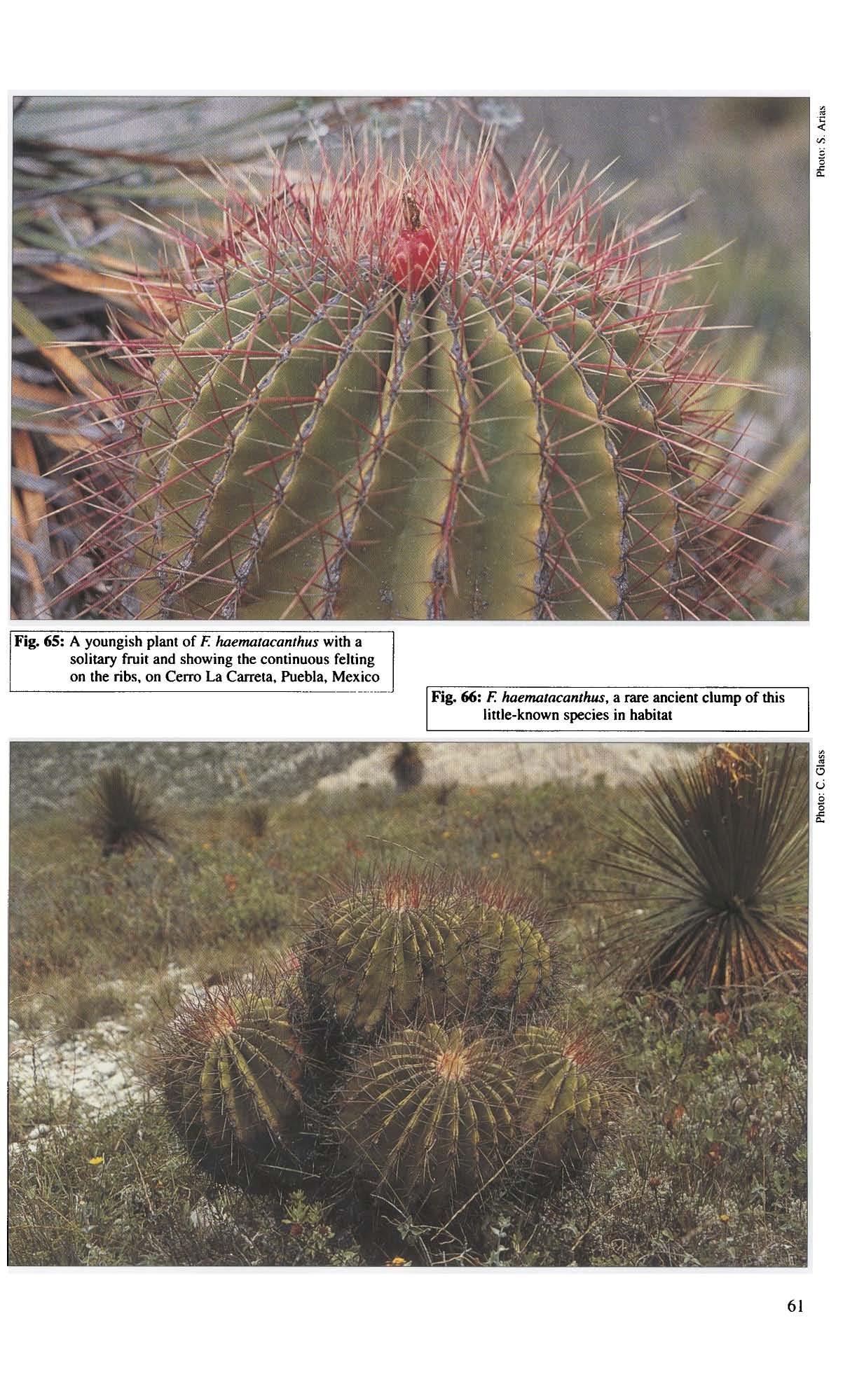
Ferocactus hamatacanthus
This species has been known in cultivation for many years as HamatocQc/us homo/acanthus, or by those who insist on shortening the names or giving nicknames to their plants, as "Ham squared". But the placing by Britton and Rose, over 70 years ago is more in keeping with the current trend towards amalgamation of genera, and it was firmly returned here by Nigel Taylor in his review of 1984, recently endorsed in the CITES Cactaceae Checklist (I999). We are bound to point out that unlike all other species this one does not have clearly formed ribs, and many enthusiasts have hung doggedly on to the more familiar name Hamatocactus. Hamatocactus setispinus, the other species in the now discredited genus HamatocaCIUS has been referred to the genus TheLocactus. species (correctly identified that is) with red in the throat. Fruit is ovoid to oblong, to 50mm long, to 25mm in diameter, pinkishred, the interior juicy, often bursting near the apex and exuding the seed in thick, sweet fluid. Seed is black. to 1.6mm.
In the wild this is often a scruffy looking plant with a tangle of long, greyish spines. straw yellow in youth, and hooked at the tip, waiting like a patient angler to snare your unwary ankle. In cultivation it rarely makes a handsome plant, and is seldom seen doing its best to warrant the space it needs to grow to maturity, the owner often giving up before it reaches anything like its potential size.
F. hamatacanthus is divided into two subspecies, which intergrade:
Ferocactus hamatacanthus subsp. hamatacanthus
The type was described as solitary, rarely clustering in the wild [or in cultivationl, hemispheric to cylindric, the stem to 60cm tall, 30cm in diameter, [mid to brownish-green], with 12 to 17. rounded, strongly tuberculate ribs. There are 8 to 20 radial spines, J5 to 40mm (rarely to 80mm) long, with 4 to 8 central spines. to 80mm long (or exceptionally up to J65mm is reported). round or somewhat flauened in section, recurved to hooked at the tip, stiff, sometimes twisted. Flowers are large in comparison with other species, and for a comparatively small plant, to about 7cm long and nearly IOcm in diameter, yellow with yellow stigmas. They can be produced on plants no more than about JOcm in diameter, but a sunny situation is needed for this. As mentioned above a fundamental difference from other species is that even in maturity this species is tuberculate rather than ribbed. Taylor's report in his review of the flower being "often red in the throat" was based on Weniger's description. but was doubted by him (Taylor) in a later issue of Bradleya, and this is endorsed by the authors who have never seen a flower of this Reported from USA and Mexico; specifically from USA: south-east NEW MEXICO; west and south TEXAS, including specifically Pecos County and Crockett County; from Mexico, west of Sierra Madre Oriental, mostly in Chihuahuan desert. widespread from the states of CHIHUAHUA in the south; DURANGO in the east; SAN LUIS POTosi and ZACATECAS; reported also extensively from the states COAHUILA, NUEVO LOON, TAMAULJPAS and PUEBLA; at IO-2,J50m altitude.
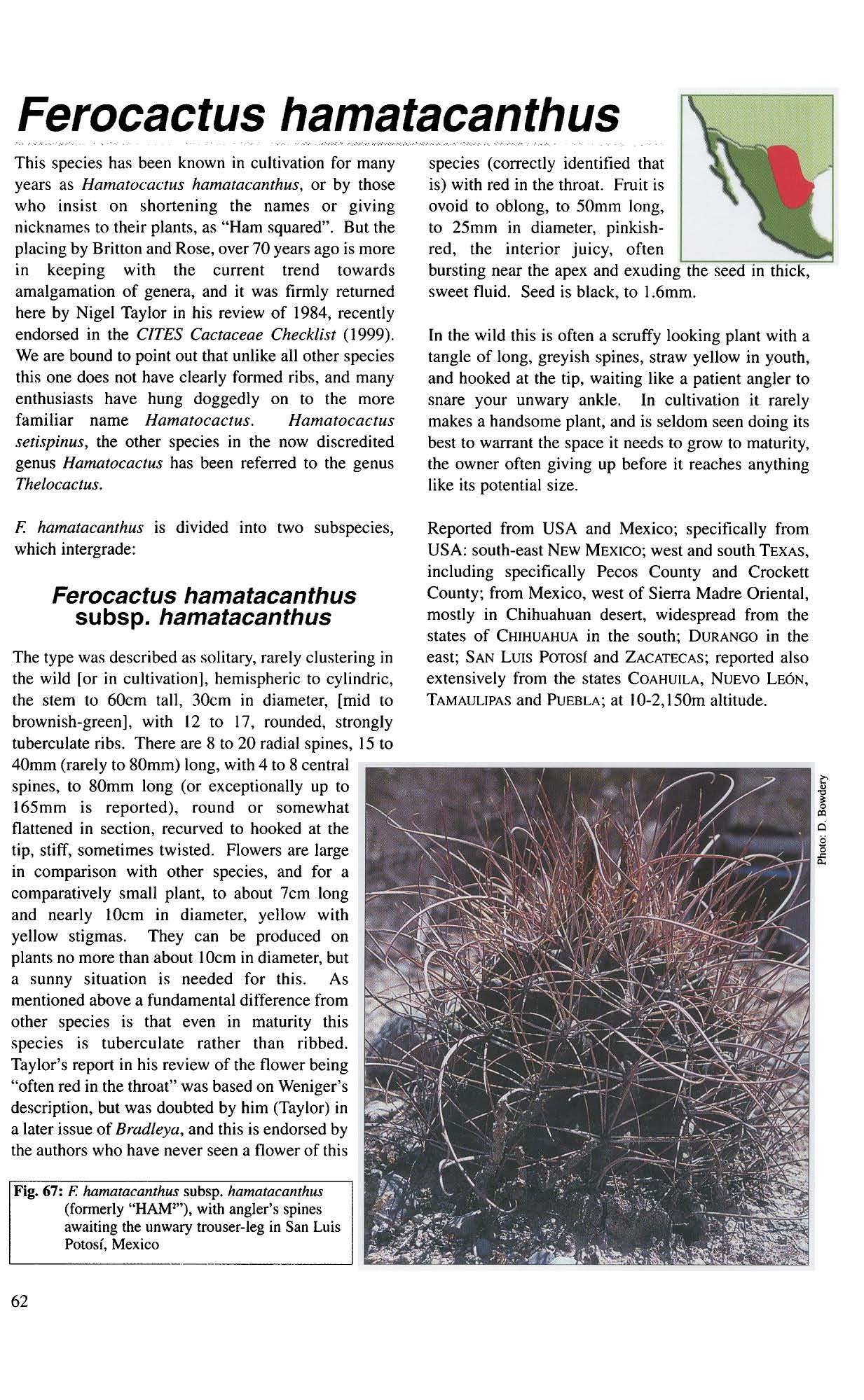
Fig. 67: F. hamatacanthus subsp. hamatacanthus (fonnerly "HAM'''). with angler's spines awaiting the unwary trouser-leg in San Luis L- PotOSI, Mexico .
iFIg. 68: F hamalacunthus subsp. ! hamatacanthus, flowering in cultivation in Austria
Field collection numbers referred here are: L. & R. L. Ben,on 15507 (POM); D. 5. & H. 5. Correl 30894 (LL); Rep. 377a. 420.451,459.469. 548. I080b. 1083e. 1192a. 1202e. 1537. 1678a. 1845. 2164e. 2270b. 2283a. 2296e. 2303d. 2331 b. 2335b. 2336b. 2352<; GL 150; 5B 393. 1096; CZlCH Oil; C5D 239.
Synonyms: hamatacantha. EchinoclKttfS hamalacanlhus, 1::. longihamatus, £. var. crassispinus, F. hamatacanlhus var. crtlssispinus, Hamato-cQctus hamatacanthus
Seclion Bisnaga F. latispinus group. References:
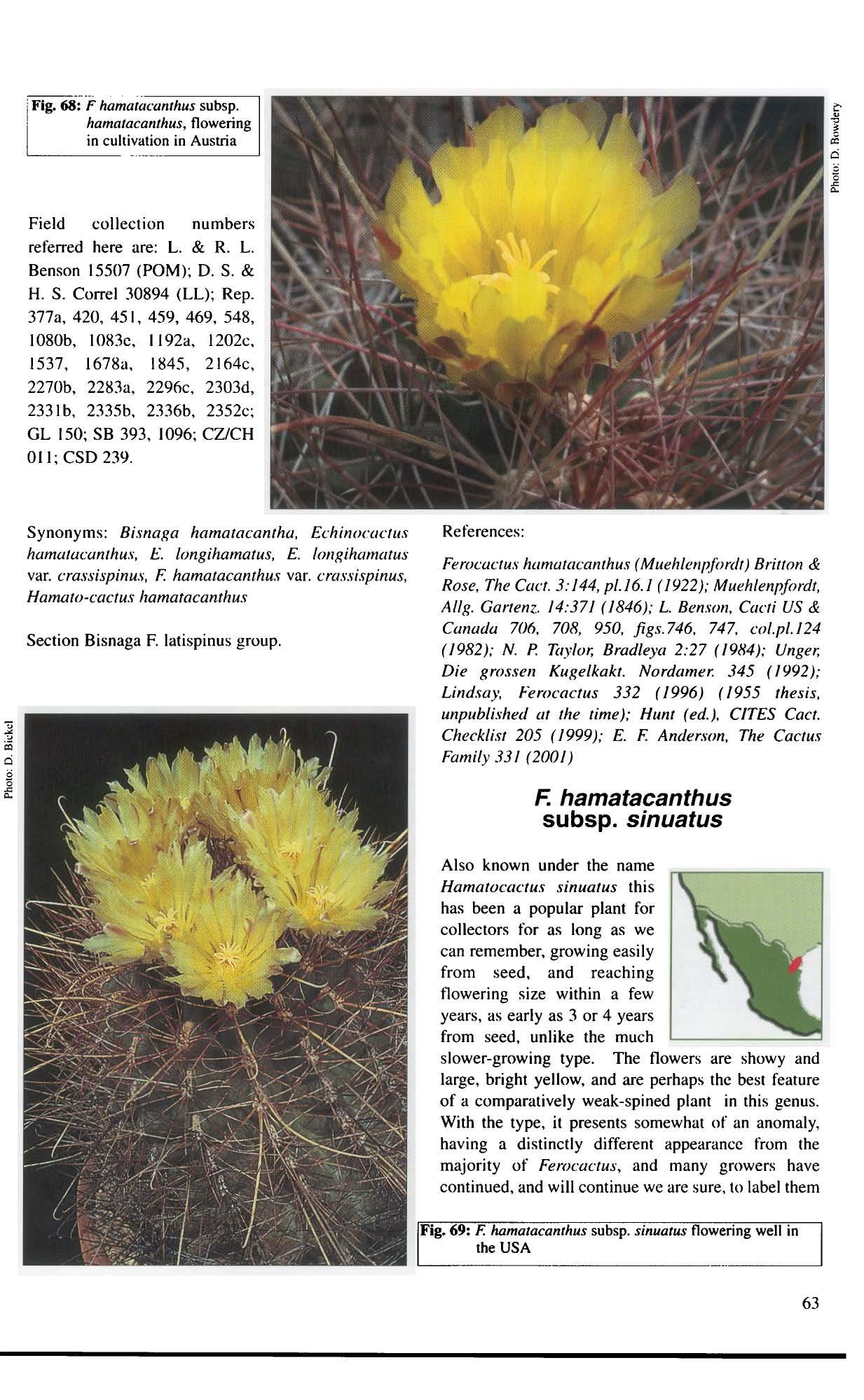
Ferocactus hamatacanthus (Muehlcllp}lmlt) Brillon & Rose. The Cael. 3:144. pl. 16. 1 (1922): Muehlenp/ordl. Allg. Ganem.. /4:37/ (/846): L Benson. Cacti US & Canada 7116. 708. 950. figs. 746. 747. col.pl./24 (/982): N. P. Tilylor, Bradleyo 2:27 (/984): Unger, Die grossen Nordamer. 345 (1992); Lindsay, Femcactus 332 (1996) (1955 thesis. unpublished at the time); Hunt (ed.). CITES eaa Checklist 205 (/999); E. F. Anderson. The Cactus Family 33/ (200/)
F. hamatacanthus subsp. sinuatus
Also known under the name Hamatoc'actus sinuatus this has been a popular plant for collectors for as long as we can remember. growing easily from seed. and reaching flowering size within a few years. as early as 3 or 4 years from seed, unlike the much slower-growing type. The flowers are showy and large, bright yellow. and are perhaps the best feature of a comparatively weak-spined plant in this genus. With the type. it presents somewhat of an anomaly. having a distinctly different appearance from the majority of Ferocactus, and many growers have continued. and will continue we are sure. to label them
Fig. 69: F. hamatacanthus subsp. sinuatus flowering well in the USA
with the now discrt:ditt:d gt:m:ril: namt: HClmCltocu(."/u.L Whatever you call it this is a worthwhile plant to grow. and will reward you at an earlier age than most in this genus wilh bloom.
It was described as having a stem 10 30cm tall, to 20cm in diameter. mature when smaller. with 13 narrow. more acute and well·defined ribs than in the type. There are 8 to 12 radial spines. some of which are markedly flattened. varying in length from I to nearly 6cm long. red to purple with yellowish tips or all yellowish, all grey in age. There are 4 central spines. the upper three are 3 to 6.5cm long, straight, yellowish with red banding, the lowermost strongly flattened. strongly hooked and more or less bendy. 5 to 9cm long, reddish, later all grey. Rowers are yellow. about 6 to 7.5cm long and wide or wider. stigmas yellow. Fruit is elongated·globose, to 25mm long and to about 15mm wide, dark greenish to dark brownishred. juicy. Seed is up 10 I mm. shiny black.

Reported from USA and specifically from USA: south-east TEXAS, east of Devil's River. in San Patricio County; and southwards into in the north-east, on the east side of the Sierra Madre Oriental: from COAHUILA at Nueva Rosita; from TAMAULIPAS. in Ciudad Victoria near Santa Engraeia, Jaumave, San Vicente. Calles; from NUEVO LEON. in brushlands at low elevations, Linares. Presa Rodriguez Gomez, Rayones, EI Mirador. Eof Monterrey, Huasteca Can· yon near Monterrey. Puerto de la Boca. Cerro de 101 Silla near Cadereyta. Jimenez near Monterrey; at 350 to J.3OOm altilUde.
Field collection numbers referred here are: Wright without no. (Mo); R. O. Albert 5 1.1 (POM); Rep. 3R2, 390, 4IXI, 1294a; 58 2R2. 319; GL J52, J53.
Synonyms: Bisnagll hamatac:umha var. sinuata. Edrino<:ac:tus /ongihamatus sinuatus, E. utispinus sinuatus, £. s;nuutwi. F. hamutocactus var. sinuatus, Hamatoc:actu ... sinuutus Ferocac:tus hamatGcallthu.{ suhsp. .\·ifluutus (A Dietrich) N. P. Tay/or, Cact. Con.... /nit. 5: 13 (1998); A. Dielrich, Allg. Cartenz. /9:345 (/85/) - as Echinocac:tus; L. Benson, Cact. Succ. J. (US) 4/(3):/28(1969); Brit/on & Ro.,·e, 3:/44-/46, fig./52 (1922); OrcuIl, Coclography /·5 (1926); Unger, Kokl.u.u.Sukk. 3/(10):289-29/, wilhfigs. (/9110); Die grossen Kuge/kakt. Nordamer. 360 (1992); Lilld!ia): Ferocac:tUJ 332 (/996) (/955 thesis, unpublished at the time); E. F. Anderson. The Cac·tus Family 33/
(2oo/)
Fig. 70: F. hamotacanthus subsp. silluutus flowering early in life in lhc UK if not as well as in the USA
Ferocactus histrix
This is a very widespread species. invariably solitary, but not making the height of some of its more weighty relations. often remaining globular. only in age becoming shortly cylindrical. The curving spines on young plants make it a most attractive species to grow from a small plant, and in cultivation it will grow quickly into an impressive globular plant. sometimes doubling the number of ribs in a growing season. Even when a sizable plant has been achieved the yellow spines make it a most attractive addition to a collection. It will tlower at about 25cm in diameter in cultivation, the yellow flowers adding to the lustre of the yellow spines.
II is in some danger from the custom of making a sweetmeat from the flesh of the planl by soaking chopped up pieces of it in a sugar solution. Charles Glass was concerned at the depredation of wild plants for this purpose, and had ideas about teaching the Mexican perpetrators of this practice how 10 grow and cultivate plants from seed for this purpose. Given their slowness of growth to make any size which would be useful for Ihis purpose. and a natural impatience for results, this scheme was unlikely ever 10 have succeeded. Although the name Echillocactus me!ococtilormis is older than E. hisfrix, Taylor dismisses it as of uncertain application. and takes E. hisfrix, descrihed within a year or so of E. melococtifonnis as representing a surer application to the taxon in question.
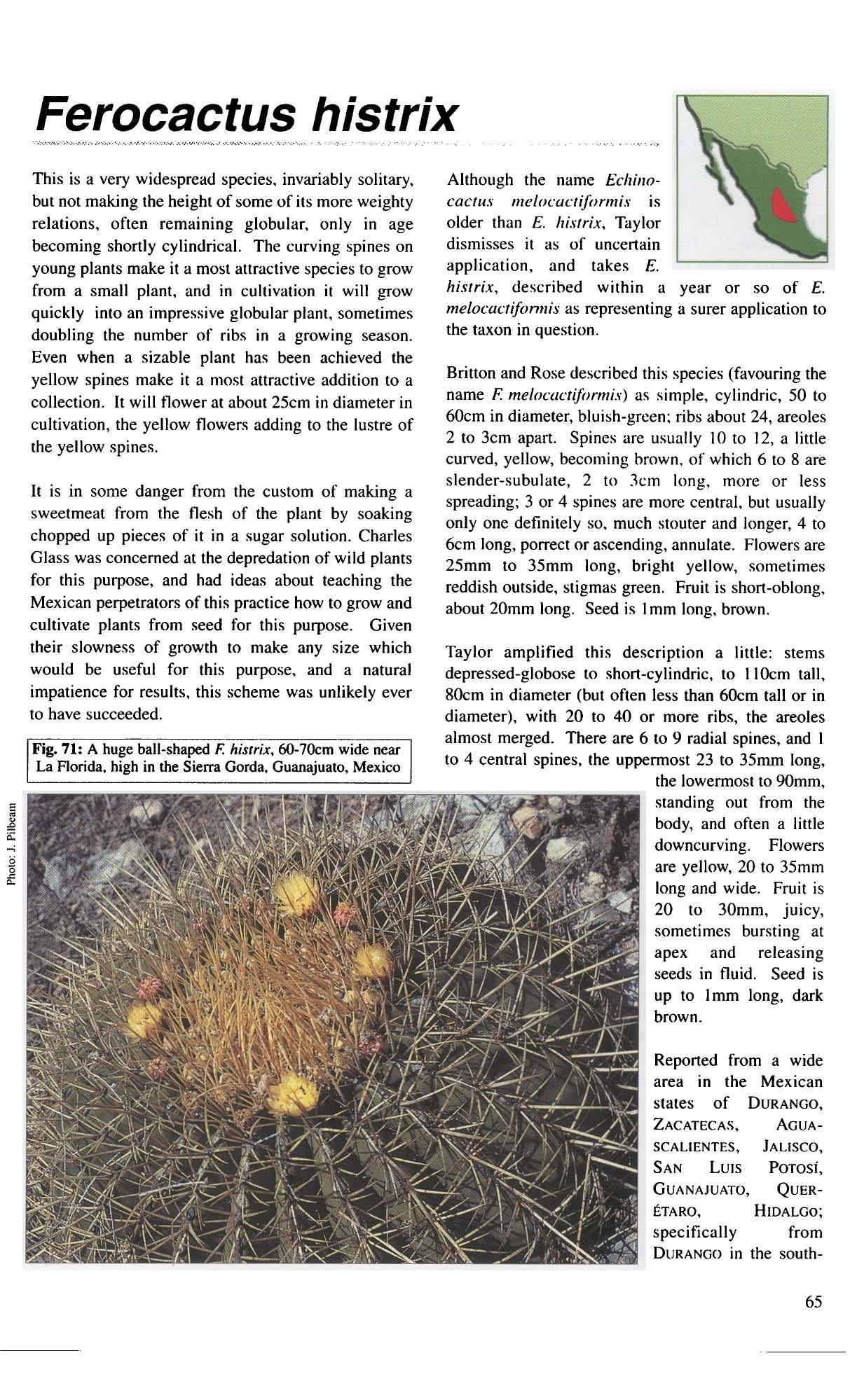
Britton and Rose described this species (favouring the name F. melococfiformi'\") as simple, cylindric, 50 to 60cm in diameter. bluish·grcen: ribs about 24. areoles 2 to 3cm apart. Spines arc usually 10 to 12, a little curved, yellow, becoming brown. of which 6 to 8 are slender·subulate, 2 to 3cm long, more or less spreading; 3 or 4 spines are more central. but usually only one definitely so. much stouter and longer, 4 to 6cm long, porrect or ascending, annulate. Flowers are 25mm to 35mm long, bright yellow, sometimes reddish outside. stigmas green. Fruit is short-oblong, about 20mm long. Seed is Imm long. brown.
Taylor amplified this description a little: stems depressed-globose to short·cylindric. to IIOcm tall, 80cm in diameter (but often less rnan 60cm tall or in diameter), with 20 to 40 or more ribs, the areoles almost merged. There are 6 to 9 radial spines. and I to 4 central spines, the uppermost 23 to 35mm long, the lowermost to 9Omm, standing out from the body, and often a little downcurving. Flowers are yellow, 20 to 35mm long and wide. Fruit is 20 to 30mm, juicy, sometimes bursting at apex and releasing seeds in fluid. Seed is up to Imm long, dark brown.
Reported from a wide area in the Mexican states of DURANGO. ZACATECAS, AOUASCALIENTES, JALISCO, SAN LUIS POTOSI, GUANAJUATO, QUERETARO, HIDALOO; specifically from DURANGO in the south-
Ci: Three moss;ve globes 011 F. histrix after rain in the mountains of San Luis POlosi. Mex.ico
__ . . __ ---.J
east: from ZACATECAS, Troncoso, La Cienega, Ojocalienles. Pinos. La Huiguerra. Monte Escobedo/EI Saito. Huejuquilla, La Blanca;
from AGUASCALIENTES, La Punta, San Gil; from eastern JALISCO. 37km W Ojuelos, La
Paz; from SAN LUIS POTOS{, Bocas, Mexquiticcharcas, EscaJarias. Zaragoza de Solis, Labor Vieja, Arroyo Carnzal E of San Luis Potosi, Huacuma, Pedro Montoya (San Ciro), Ciudad Hidalgo. Ojo Caliente, Ahualulco. La Presa. Verba Buena. Sierra Alvarez, Tinaja, Arroyo Pila. LeoncilO. Jasos, Porvenir. Buena Vista/San Rafael; from GUANAJUATO, San Luis de la Paz, Villa Victoria, San Felipe. Puerta Caroza, La Posta, Atotonilco, Calera. Tierra Blanca. Barranca Cedros near San Jose Iturbide, Carboneras neur Pows, San Diego, Trancas near San Luis de la Pal.. OrganitoslCanadu Moreno; from QUERETARO, Vi zarro. E Cadereytu, mountains around Colon, Villa Hermosa. Higuerras. Higuerillas to San Pablo pass near Bernal, Tolim<ln near Bernal, BucareJi, Amoles at Rio Moclezuma, Queretaro, Rio San Juan; from HIDALGO, near Vi7.arron, at 1200 to 2600m altitude, Barranca de Venados. San Cristobal 10 Metztitlan, Cardonal. Gilo. Agua Blanca. Ixmiquilpanl Porlezuelo. Toliman, Tecozautla, Mezquital, Taquillo, Metztitlan, Rincon; at 1,2002.600m altitude, on non-calcareous soils.

The neotype cited by Lindsay is a water-colour plate by Heyland on which A. P. de Candolle wrote the determination of this species (as Eehinocactus histrix) in the general collection of the Herbier Delessert. Conservatoire et Jardin Botaniques, Geneva. Switzerland; the holotype seems nol to have been preserved. Nigel Taylor in 1984 promoted this same waler colour plate by designating it as the lectotype for Ihis species; lectotype has precedence over a neoLype.
Field collection numbers referred here are: Lindsay 2031.2576 (OS. SO); Orcutt 19241581 (OS); Purpus 5358.5497 (Ve); Lau 1415; Rep_ 25.38.297.300. 345.974. 1736b. I 737b. 1757•. 1816c. 1823a. 1825b. I 878b. 1951 b. 20070, 202Oc. 2030, 20330, 2038h. 2041b, 2045, 2054b, 2127d. 2131 •• 2140, 22540, 2258., 2270c, 2352b, 2355.; OJF 603; S8 1877; eZieH 251; eso 290, 309_
Synonyms: Bisnaga 11l\lrix, Eehinocaetus histrix, F. electracanthu.\" Hort., F. meloeactifiJrmis. F. hystrix in error
Section Bisnaga F. latispinus group
References:
Feroeactus histrix (De Candolle) G. Lindsay. Caet. SacCo J_ (US) 27(6):/7/-/73, fiK-/59 (/955); De Candolle, Mem. Mus. Hist. Nat. Paris /7:/ /5 (/829); De Candolle. Prodr. 3:462 (/828): 8rillon & Rose. The Caet. 3:/38 (1922) - us F. meloeaetiformis; Sanchez-Mejorada. Caet. Suc. Mex. /0(3):66. 72, figs. 36.37. 42c. 43c /1965); Castillo Sanchez. Ca('/. Sue. Mex. 28(/):3-12 (/983); Unger. Die grossen Kugelkakt_ Nordamer. 317 (/992); Lindsay. Ferocactu., 1/5-/22. /39. 405. 433 (/996) (/955 thesis. unpublished at the time); E. F. Anderson. The Cadus Fami/y 33/-2/200/)
Ferocactus johnstonianus
Our experience of this island species in cultivation is limited to 10 year old seedlings, with spine colours varying from yellow to red in youth. In their short life so far they have reached about 15cm tall and about IOcm in diameter. Nor have we visited this species in habitat - yet. We are therefore particularly indebted to Mark Muradian for pictures of authentic plants in cultivation in the USA, grown to flowering size.
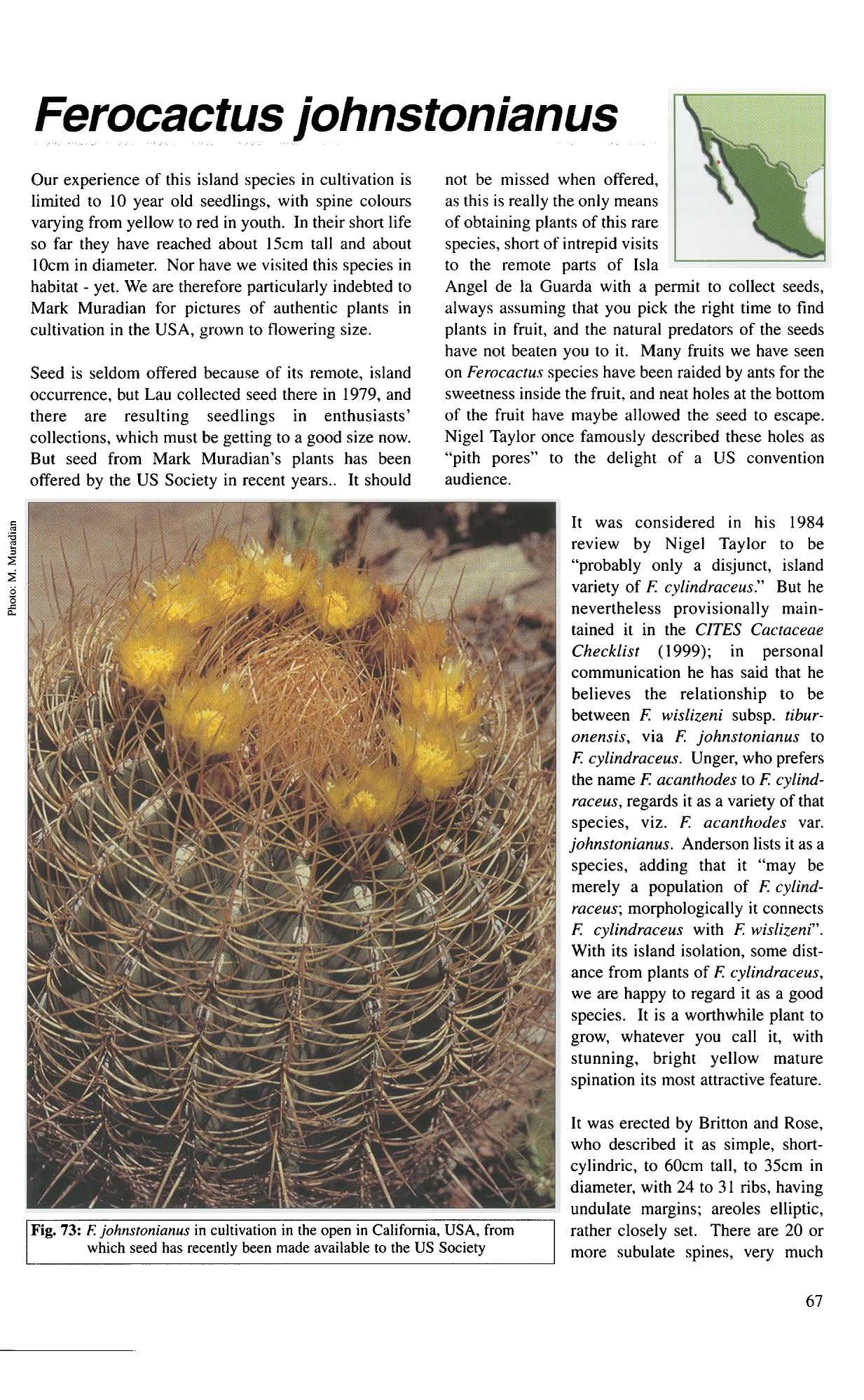
Seed is seldom offered because of its remote, island occurrence, but Lau collected seed there in 1979, and there are resulting seedlings in enthusiasts' collections, which must be getting to a good size now. But seed from Mark Muradian's plants has been offered by the US Society in recent years.. It should not be missed when offered, as this is really the only means of obtaining plants of this rare species, short of intrepid visits to the remote parts of Isla Angel de la Guarda with a pennit to collect seeds, always assuming that you pick the right time to find plants in fruit, and the natural predators of the seeds have not beaten you to it. Many fruits we have seen on Ferocaetus species have been raided by ants for the sweetness inside the fruit, and neat holes at the bottom of the fruit have maybe allowed the seed to escape. Nigel Taylor once famously described these holes as "pith pores" to the delight of a US convention audience.
It was considered in his 1984 review by Nigel Taylor to be "probably only a disjunct, island variety of F. cylindraceus." But he nevertheless provisionally maintained it in the CITES Cactaceae Checklist (1999); in personal communication he has said that he believes the relationship to be between F. wislizeni subsp. tiburonensis, via F. johnstonianus to F. cylindraeeus. Unger, who prefers the name F. ac.:anthodes to F. cylindraceus, regards it as a variety of that species, viz. F. aeanthades var. johnslOnianus. Anderson lists it as a species, adding that it "may be merely a population of F. cylindraceus; morphologically it connects F. cylindraceus with F. wislizeni". With its island isolation, some distance from plants of F. cylindraceus, we are happy to regard it as a good species. It is a worthwhile plant to grow, whatever you call it, with stunning, bright yellow mature spination its most attractive feature.
It was erected by Britton and Rose, who described it as simple, shortcylindric, to 60cm tall, to 35cm in diameter, with 24 to 31 ribs, having undulate margins; areoles elliptic, rather closely set. There are 20 or more subulate spines, very much
alike. none hooked, slightlyspreading. more or less curving outwards. to 7cm long, yellow to brownishyellow. ribbed. Flowers including ovary are 5cm long. yellowish, or with outer petals tinged red. stigmas flesh coloured. Fruit is 25mm in diameter, yellow. Seed is shiny black, 2 to 2.5mm long. 1.5mm wide.
Taylor adds to the above description only that the spines number 22 to 25.
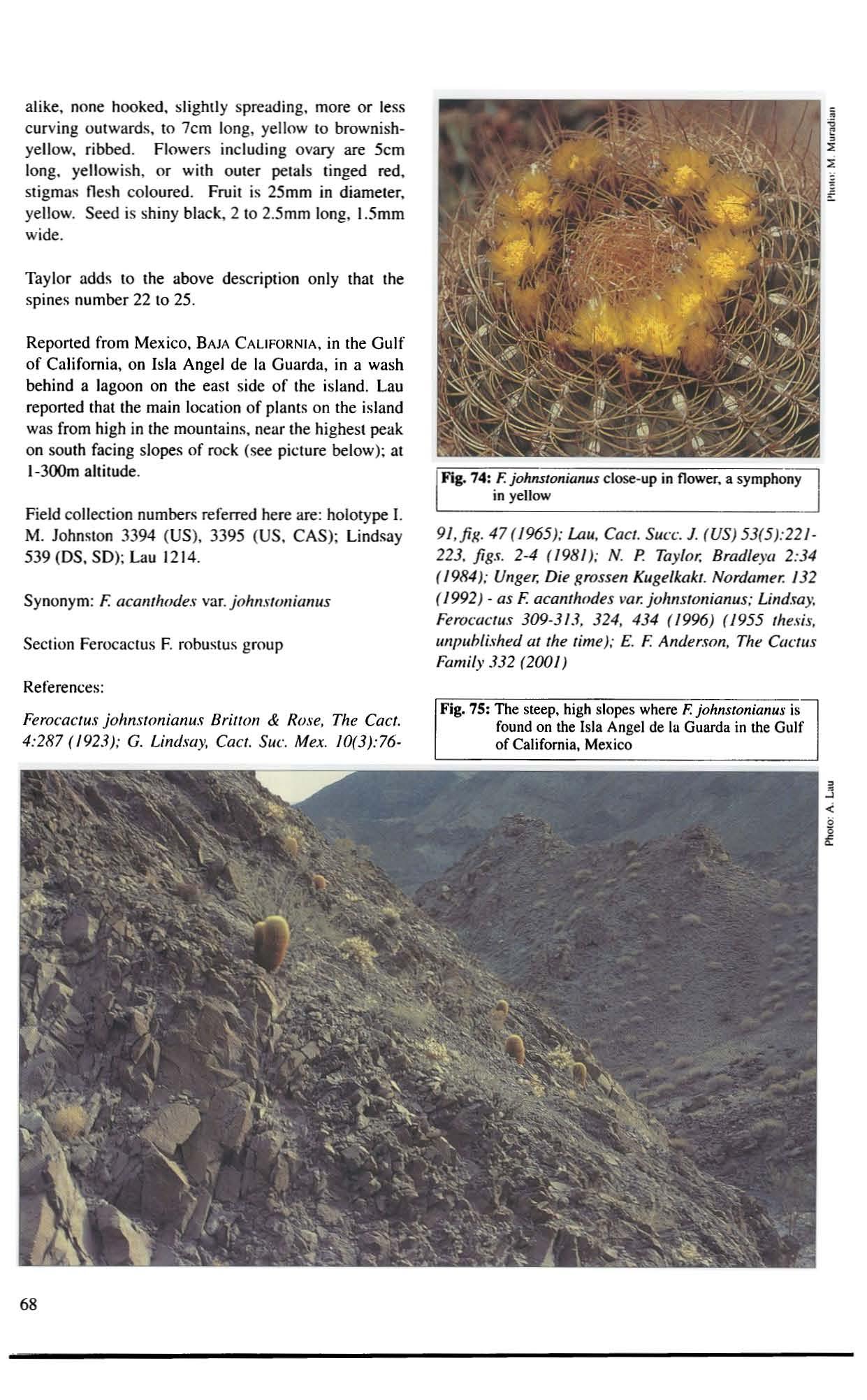
Reported from Mexico. BAJA CALIFORNIA. in the Gulf of California, on Isla Angel de la Guarda. in a wash behind a lagoon on (he east side of the island. Lau reported that the main location of plants on the island was from high in the mountains, near the highest peak on south facing slopes of rock (see picture below); at I-300m altitude.
Field collection numbers referred here are: hololype I. M. Johnston 3394 (US), 3395 (US, CAS); Lindsay 539 (DS, SD); Lau 1214.
Synonym: F. acamlwdes var. johmlollianus
Section Ferocactus F. robustus group
References:
91, jig. 47 (/965); Lau, Cael. Suec. 1. (US) 53(5):22/, 223, fig.,. 2-4 (/98/): N. P. Taylor. Bradley" 2:34 (1984); Unger. Die grossen Kugelkakl. Nordamer. /32 (/992) - as F. acanthodes var. jolmstollianus; LiIld.fOay. Feraeae'u", 309-313, 324, 434 (/996) (/955 the.,;., wlpuhlished at the time); E. F. Anderson, The Cac:tus Fami{y 332 (2(01)
Fig. 75: The Sleep. high slopes where F. johnsronianus is found on the Isla Angel de la Guarda in the Gulf of California, Mexico
Ferocactus latispinus
This is a wonderfully spined species to grow in cultivation. with the broadest. llal spines seen in any species. It needs maximum light to bring out the best in spine development. and to encourage flowering which will occur once it gels to about IUcm in diameter. It is not a large-growing species. and usually stays shorter than broad. It is popular with commercial growers in the Canary Islands, and beautiful plants are often secn for sale in Europe commercially emanating from there. where clearly the growing conditions favour the best development of spines and flowering capabilities.
h seems to be difficult to keep growing well in cultivation, and frequent repouing is recommended in the early years. A fUfther difficulty arises in the UK with its late production of tlower buds. which often do not develop as the days shorten and the temperature drops at night. If this occurs it is advisable, in order to encourage the flowers to open, to raise the temperature in the glasshouse w about 15°C, or perhaps more economically w bring the plant into the dwelling house and keep it in the sunniest spot. Taylor rejects the name F. recurvus as of imprecise application. preferring the name F. latispillus subsp. spiralis for plants of this relationship occurring in Oaxaca. with a somewhat different aspect and flowers. Unger recognizes F. recurvus as a good species, and places F. latispinus beneath it, i.e. as F. recurvus var. latispinus! We regard them as sufficiently different to maintain as separate species. sec f: recurous on p. 89.
In the wild F. latispillus is frequently found half hidden by surrounding grasses and other vegetation, waiting like a mantrap for the unwary foot to try out the thickness of its bootsole.
It was described as depressed-globose or tlattened. to 30cm tall. 40cm in diameter. with about 21 ribs in maturity. body green to yellowish-green. There are 9 to 15 radial spines. varying from fine, white needlelike spines to dark yellowish or reddish brown. about

2.5cm long. There are 4 central spines dark reddishbrown or amber coloured. the upper three ascending. to 4cm long. straight. l1attened. the lowermost descending. to 50mm long and noticeably much wider. 9mm. curved to hooked at the tip. strongly ribbed. Flowers are purplish·pink on red-brown spined plants or whitish-yellow on amber-spined plants, 4cm long and wide. stigmas yellow. Fruit is ovoid. purplish-red. to 25mm long. 18mm in diameter. juicy. covered with densely overlapping, acute. hard scales. Seed is 1.5 to 1.8mm. Imm wide, dark brown to black. shiny.
Reported widespread in the Mexican states of DURANGO. ZACATECAS. LUIS Pmosi. state of MEXICO. MEXICO OF (Oistrito Federal). MICHOAC.\N, MORELOS. QUERETARO. HIDALGO. GUANAJUATO. JALISCO; specifically from DURANGO. Partido de Nombre de Dios; from ZACATECAS. Troncoso, Ojo Caliente. Alamo. Pinos. Zacatecas to Saltillo; from SAN LUIS POTOSI, E of San Luis Potosi, Salinas. Jasos. Soldad, Arriaga, N of San Luis Potosi, Leoncito, Zaragoza de Solils. Ahualulco. Porvenir; state of MEXICO. Teotihuacan. Tulpetlac, Santa Catarina to Tezcoco; from MEXICO OF, Indio Verde, Cerro Zacoalco; from MICHOACAN, Mesa Central; from MORELOS. at Cuautla; from QUERETARO, Del Ciervo a San Juan Alta Mirano. San Juan del Oro. E Cadereyta. Colon. Tequisquiapan. La Canada. San Juan del Rio. Vizarron. Higuerillas to San Pablo to the pass at Bernal. Toliman near Bernal. San Antonio. Queretaro. Saucillo; from HIDALGO. Nand E of Pachuca.

Ixmiquilpan. Tula. Santa Matilda. Cardonal, Los Arcos, EI Manzana, Tecpatepec to Tulancingo. Xhaja. Ixmiquilpan to Portezuelos; from GUANAJUATO, Dolores Hidalgo, Villa Victoria, Puerta Carosa. San Felipe, La Posta near San Miguel Allende. Organitos to Canada Moreno. Carboneras. Pozos, Atotonilco. Calera. Trancas and San Luis de la Paz, San Diego, San Luis de la Paz; from JAUSCO, La Paz, Cuarenta; in grassy plains and rocky hillsides at 1.500-2.500m altitude.
Field collection numbers referred here are: neotype
Lindsay 2583 (OS); Lindsay 2034.2035 (OS); Lindsay 2581. 2593. 2594 (OS. SO); Pringle 3270 (Ue. MEXU); Altamirano 1730 (MEXU); Orcutt 2660 (OS); Dawson 3084 (AHFH); Maluda 19436 (UC); Lau 1406; Rep. 7. 17. 26. 39. 47. 64. 77. 139. 141.344. 609. 609a. 801, 906a. loolg. 1096a. 1171a. 1252b. 126Oa, I397b. 1411 a, 1463a. 1625c. 1678b, 1736a.. 1816b. 1878a. 1967a. 1980a, 1983a. 2020b, 2034b, 2127c, 2139. 2258b. 2266a, 2270a; F0.52, 71; 58 548. 549, 1584. 1639; CZlCH 226; LH 296.
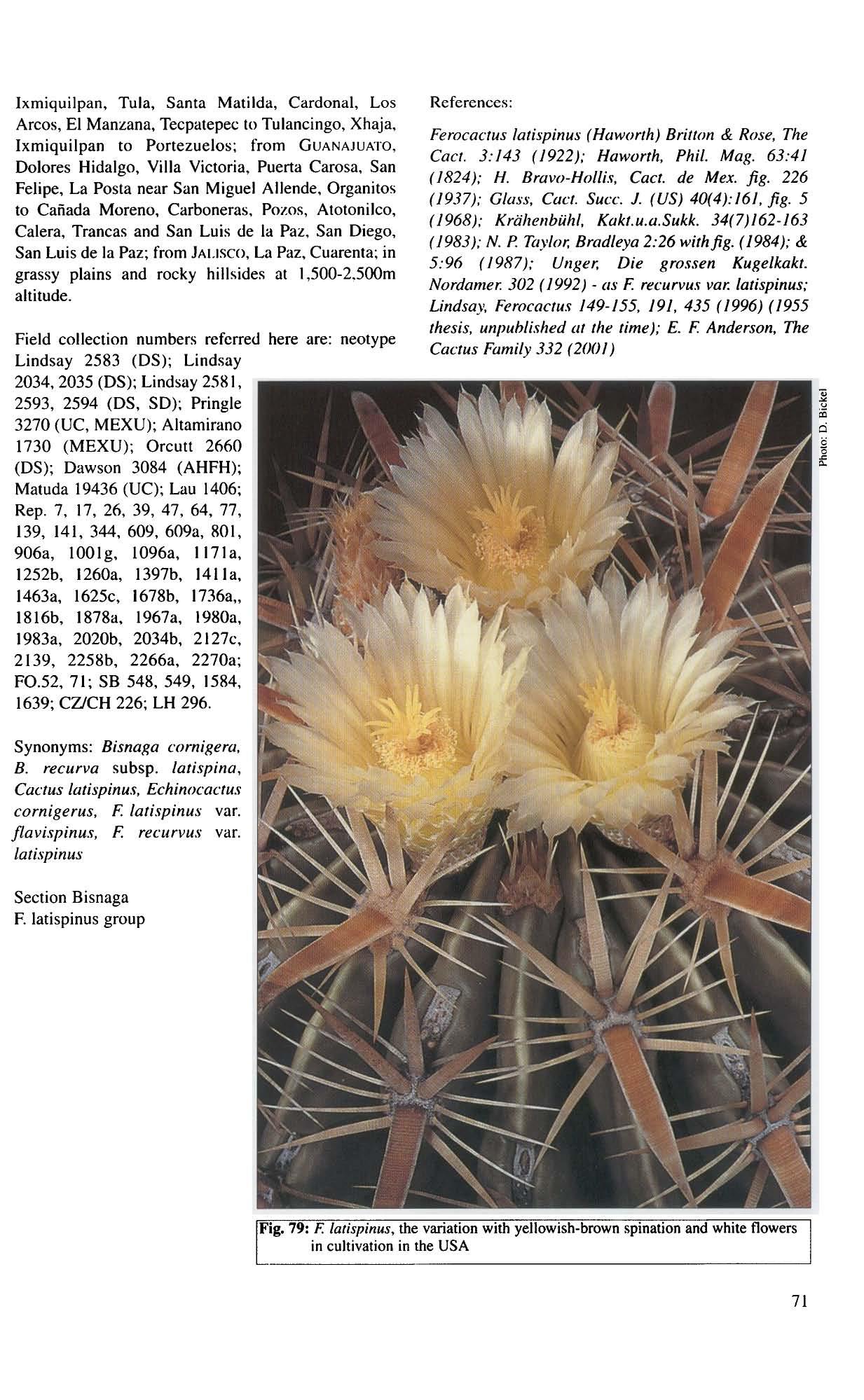
Synonyms: Bisnaga cornigera. B. recurva subsp. latispina, Cactus latispinuJ. Echinocactus cornigerus. F. latispinus var. Jlavispinus. F. reeurvus var. latispinus
Section Bisnaga F. latispinus group Ferocactus latispinus (Haworth) Britton & Rose. The
Cael. 3:/43 (/922/; Haworth. Phil. Mag. 63:4/ (/824); H. Bravo-Holli.', Caet. de Mex. fig. 226 (/937): G/ass, Caet. Suec. J. (US) 40(4):/6/, fig. 5 (/968): Krahenbuhl, Kakl.u.u.Sukk. 34(7)/62-/63 (/983); N. P. Taylor, Bradleya 2:26 with fig. (/984); &
5:96 (1987); Unger. Die grossen Kugelkakt. Nordamer. 302 (1992) - (IS F. recurVUJ var. latispinus:
thesis, 'unpubliJhed lit the time); E. F. Anderson. The
Caetus Fumily 332 (2001)
Ferocactus lindsay;
This is a species seldom secn in cultivation. since seed is not often offered. This is nOl surprising in view of its occurrence in one of the more remote pans of a remote state of Mexico. Michoacan. When it is offered. the opportunity to grow this rare species should be seized, as it is a lovely. attraclively-spined. bluish-green bodied addition 10 a collection of (his genus. It will nol take low temperatures. which threaten its survival in the UK in cultivation, at least JOOC should be maintained for safety. Plants seen in cultivation in the Cante Botanic Garden, in San Miguel Allende, Guanaju31o, had bright, buttercup yellow tlowers on siems only about 25cm tall. Seedlings raised in Derek's collection in Norfolk. where winters are not kind, got to about 100m in diameter in 6 years before a bad winter demolished them.
We visited the southern part of the state of Michoacan in the autumn of 2003 (0 see this rare species for ourselves. When we got to the turnoff for the Canyon of Infiernillo the road had a barrier indicating that we should nOI proceed further. After a few enquiries from local people at the junction we learned that a bridge had collapsed. but that it was safe to proceed for about 20km. So we drove around the barrier and proceeded with caution, looking out apprehensively for bridges, collapsed or otherwise. We saw a few small plants on the journey down into the canyon, in near-inaccessible places on the sides of the deep cut road, but gave them a miss until such time as we were maybe forced to tum back. But after a linle more than 20km we came to a new bridge across the old road we were travelling upon. clearly pan of a new. more sophisticated road, as yet incomplete. On the left side of the road on a steep hillside beside the new bridge we spotted a good sized colony of this Ferocactus some way up. The patiently waiting plants, in full nower in celebration of our visit, were reached after a steep climb on treacherously loose rock. There were several hundred plants from small seedlings to nowering plants no more than about 15cm in diameter, and mature plants to about 80cm or more. a few with one or two offsets around the base.
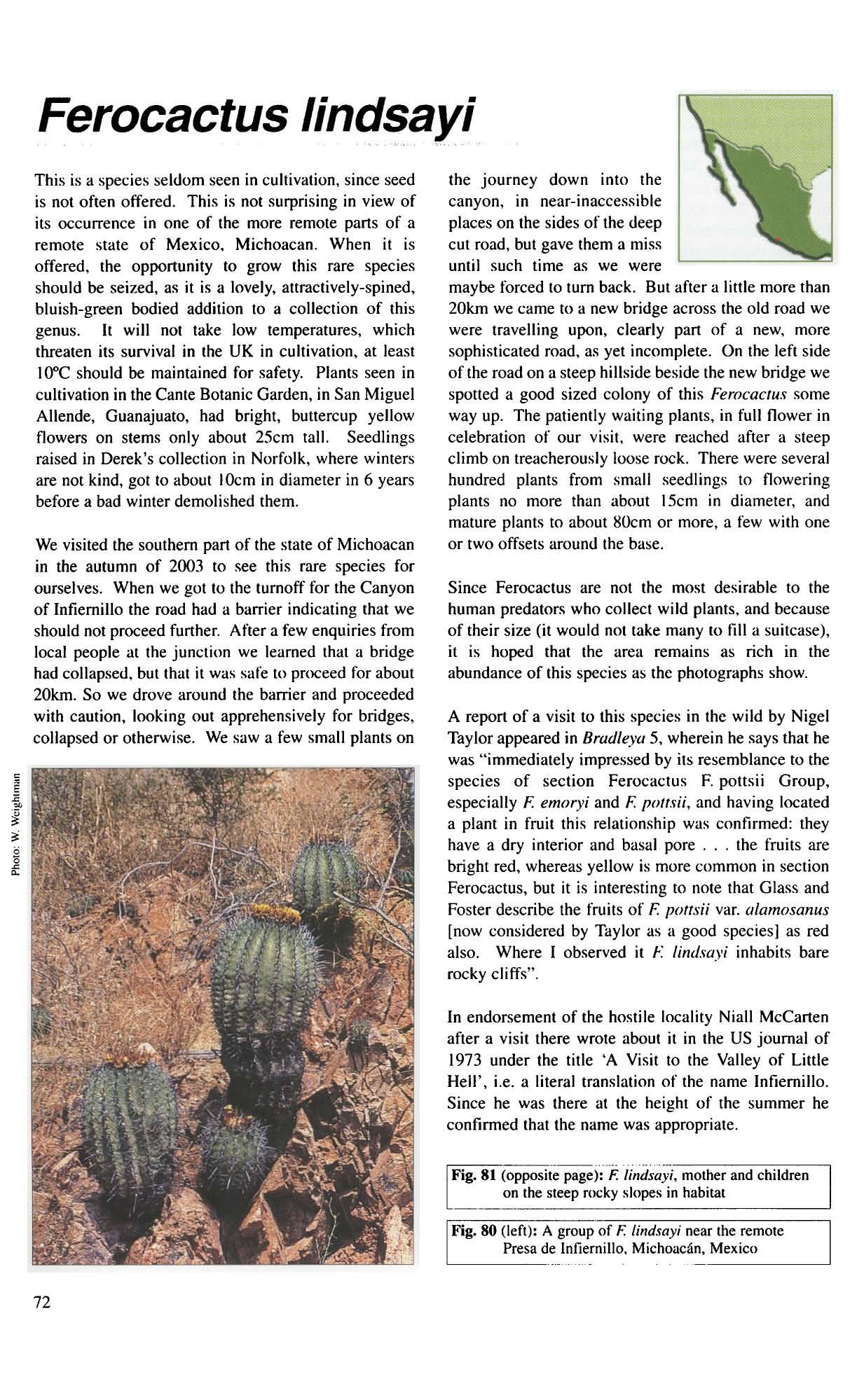
Since Ferocactus are not the most desirable to the human predators who collect wild plants. and because of their size (it would not take many to fill a suitcase), it is hoped that the are,l remains as rich in the abundance of this species as the photographs show.
A report of a visit to this species in the wild by Nigel Taylor appeared in Bradleyo 5, wherein he says that he was "immediately impressed by its resemblance to the species of section Ferocactus F. pottsii Group, especially F. emory; and F potts;i. and having located a plant in fruit this relationship was confirmed: they have a dry interior and basal pore ... the fruits are bright red, whereas yellow is more common in section Ferocactus. but it is interesting (0 note that Glass and Foster describe the fruits of F. pom''''' var. alamosanus [now considered by Taylor as a good species] as red also. Where I observed it F lindsay; inhabits bare rocky cliffs".
In endorsement of the hostile locality Niall McCarten after a visit there wrote about it in the US journal of 1973 under the litle 'A Visil 10 Ihe Valley of Lillie Hell', Le. a literal translation of the name Infiemillo. Since he was there at the height of the summer he confirmed that (he name was appropriate"
[Fig. 81 (opposite pagej":""'F. mother and children on the steep rocky slopes in habitat
Fig. 80 (left): A group of F. lindsay; near the remote Presa de Infiernillo. Michoaclin. Mexico
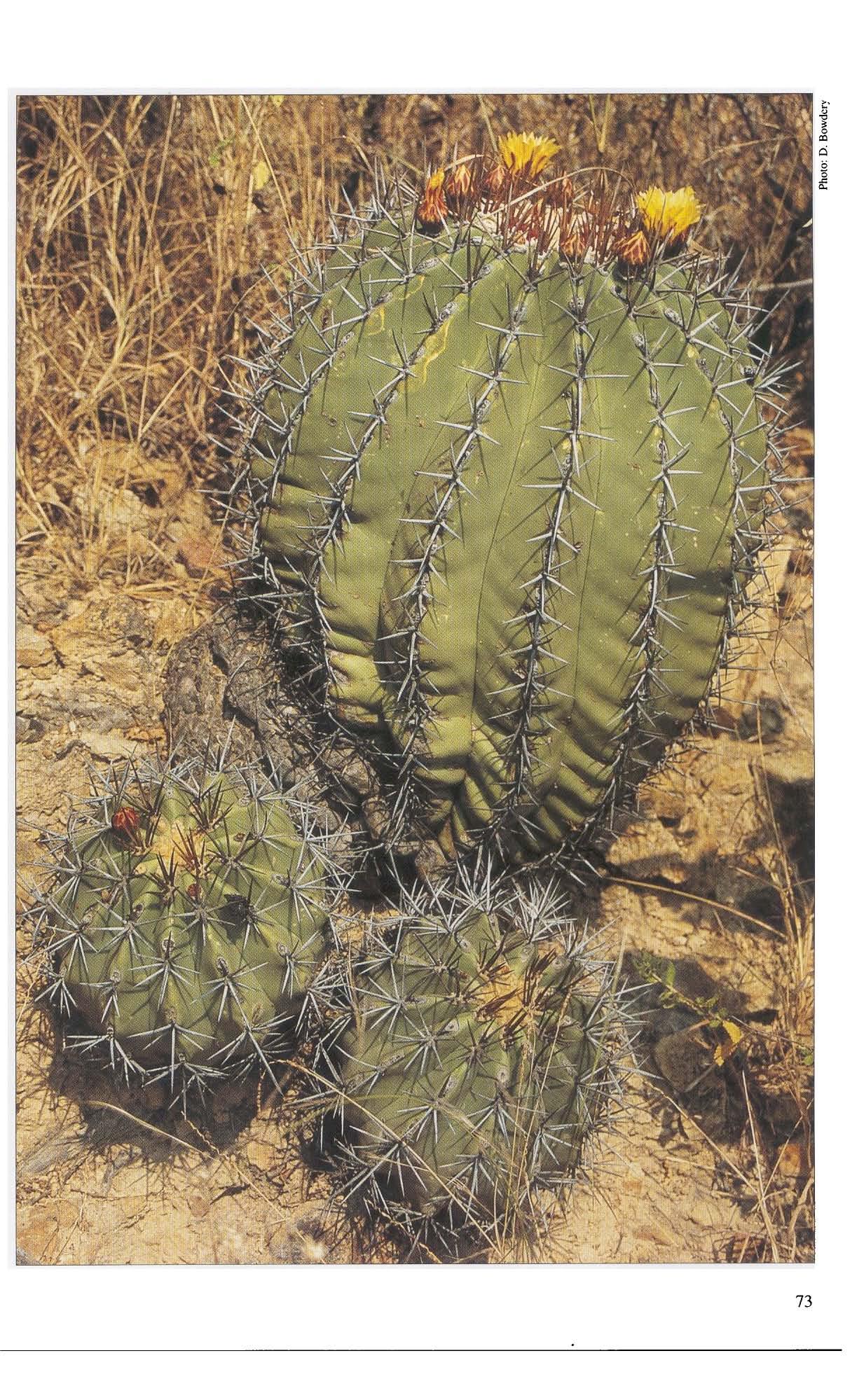
It was described as globose to short-cylindric, stems to 60cm tall, 40cm in diameter, glaucous green, with 13 10 18 ribs. There are S or 6 radial spines, 25 to 30mm long, and one centralspine, 4Smm long, straight, not flattened. Flowers are yellow, 50mm long, 34mm wide, with yellow stigmas. Fruit is ovoid, about ISmm long, bright red, with dry interior and basal pore. Seed is distinctive, to Imm, elongate, curved, dark brown to black, tiny compared to other Ferocactus species and boomerang-shaped.
Reported from the Mexican state of MICHOACAN. basin of Rio Balsas, south-east of Apatzingan, at Infiemillo; road from Uruapan to Infiemillo, Presa de Infiernillo, Cuenca del Balsas, Paso de Chivo; at 250300m altitude.
Field collection number referred here is: H. BravoHollis 391 (MEXU).
Section Ferocactus F. pottsii group
References:
Ferocactus lindsayi H. Bravo, Caet. Sue. Mex. 11(1):9-12, with figs. (1966); McCarten, Cact. Succ. J. (US) 45(3):104. figs. 3, 4 (1973); SanchezMejorada, Cact. Suc. Mex. 25(3):66 (1980); N. P. Taylor, Bradleya 2:24 (1984); & 5:95 with fig. of fruits (1987): Unger, Die grossen Kugelkakt. Nordamer. 282 (1992): Lindsay, Feroeactus 327 (1996) (1955 thesis. unpublished at the time); E. F. Anderson, The Caetus Family 332-3 (2001)

Ferocactus macrodiscus
This is a species to turn any grower of cacti on to this genus, flowering at only about lOem in diameter. and at full size only about 100m tall, and up to 30cm or so in diameter. II is indeed the first that atlracted Derek to this genus, especially when it unexpectedly flowered at a small size. It is similar in appearance to the well-known "horse-crippler", Echinocactus (syn. Homa/(J(:ephaJa) texensis. but can be distinguished by the areoles which sit in a depression on the ribs and the flowers which have no ciliate margin to the petals. and are darker coloured.
Taylor splils this species into two sUbspecies. the second unnamed at the time he wrote his review of the genus in 1984, but subsequently named by Jorge Meyran as var. seplemriona/is, and elevated recently by Taylor to subspecies. see page 77.
Fig. 84: F. macrodiscus subsp. macmdiscus. ai'homeiil"j the Sierra Juarez, east of Oaxaca city. Oaxaca. . southern Mexico
Ferocactus macrodiscus subsp. macrodiscus
This. the type. is that most commonly seen in cultivation. and is widely grown as it is small growing and obliges with flower early in life.
We nearly trod on plants we saw in the Mexican sU.lte of Oaxaca. so obscured were they in their habitat. growing almost flush with the ground and partly hidden among grasses. Those in flower were the easiest to spot. and fortunately we were there in early spring. the right time for blooming. when many were warning off our heavy boots with their startling. bright pink tlowers. Thc unopened buds are reticulated and reminiscent of snake scales.
It was described as soli.ary. with the stem deep seated (often flush with the ground in the wild), to IOcm tall, 30 to 40cm in diameter. blue-green. with 13 to 35 ribs, the areoles in deep notches. There are 6 to 8 radial

spines, yellowish or red, about 20 to 30mm long, mostly recurving back 10 the stem, with 4 central spines, to 35mm long, forming an upright cross. Flowers are purplish-pink with white margins to the petals, 30 to 40mm long and wide. with yellow stigmas. Fruit is more or less globular, magenta red. 40mm long, 30mm in diameter. juicy, covered with fleshy ovate-deltoid scales with white. hyaline margins. Seed is up to 2mm long. 1.5mm wide, dark brown or black.
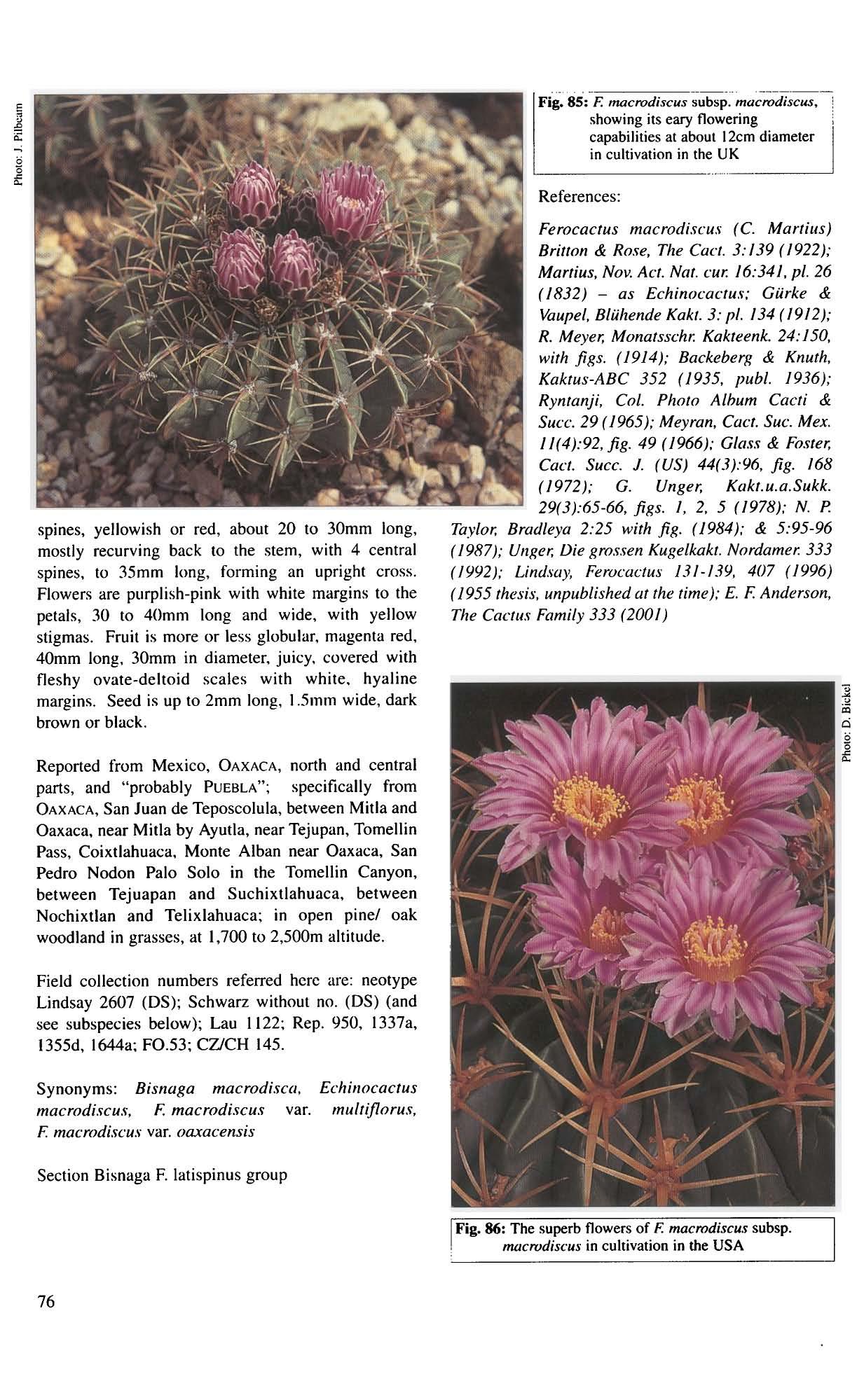
Reported from Mexico, OAXACA. north and central parts, and "probably PUEBlA"; specifically from OAXACA, San Juan de Teposcolula. between Mitla and Oaxaca, near Milia by Ayuda. near Tejupan, TomeJlin Pass, Coixllahuaca. Monte Alban near Oaxaca. San Pedro NOOon Palo Solo in (he Tomellin Canyon. between Tejuapan and Suchixtlahuaca. between Nochixllan and Telixlahuaca; in open pinel oak woodland in grasses, at 1.700 to 2.500m altitude.
Lindsay 2607 (DS); Schwarz without no. (DS) (and see subspecies below); Lau 1122; Rep. 950, 1337a, 1355d, l644a; F0.53; CZlCH 145.
Synonyms: Bisnaga macrodisca, Echinocactus macrodiscus. F. macrodiscus var. multiflorus, F. macrodiscus var. oaxacensh;
Section Bisnaga F. latispinus group
Fig. 85: F. macrodiscus subsp. macrodiscus,
showing its capabilities eary flowering at about ..12cm diameter : I
in cultivation in the UK
References:
Ferocactus macrodiscus (c. Martius)
Brillon & Rose, The Cael. 3: 139 (1922):
Martius. Nov. Act. Nat. cur. 16:341, pl. 26 (1832) - as Echinococtus: GOrke &
Vaapel, Blahende Kakt. 3: pl. 134 (1912);
R. Meyer, Monatsschr. Kakteenk. 24: 150,
with figs. (/914); Baekeberg & Knulh, Kaktus-ABC 352 (1935, publ. 1936);
Ryntanji, Col. Photo Album Cacti &
Suee. 29(1965); Meyran, Caet. Sue. Mes. 11(4):92, fig. 49 (1966); Glass & Foster, Caer. Suec. J. (US) 44(3):96, fig. 168 (1972); G. Unger. Kakt.u.a.Sukk. 29(3):65-66, figs. I, 2, 5 (1978); N. P. Taylor. Bradleya 2:25 wilh fig. (1984); & 5:95-96
(1987); Unger, Die grossen Kugelkakt. Nordamer. 333
(1992); Lindsay, Feroeaclus 131-139, 407 (1996)
(1955 thesis. unpublished at the time): E. F. Anderson,
The Cawls Family 333 (2001)
Ferocactus macrodiscus subsp. septenuionaHs
This more northerly occurring subspecies is some distance removed from the type. The differences, apan from the discrete locality, are the yellowish-green body colour (bluish-green in the type), the large size of the areoles, 12 to 25mm long (5 to 8mm in the Iype), the spines strong. straight or scarcely curving at the lip of the lower central spine (recurving to the stem in the type, and reddish or yellowish), and the whitish petals, with the central stripe yellowish-brown lO rosepurple in colour (red-purple in the type). Apart from these detailed differences. the plants are distinctive in cultivation because of the much wider ribs (more apparent in young plants) and stronger spination; they also seem to need to be larger than the type before flowers may be expected in cultivation. It is as yet not frequently encountered in cultivation.

It was described as solitary. flat-globose. 20 to 30cm in diameter. 8 to IOcm tall. the body yellowish-green. with 20 to 34 ribs. prominently tubercled. There are usually 6. but sometimes 8 or 9 radial spines. II to 30mm long. straight or slightly curved. yellowish or yellowish-brown. later grey or yellowish, the tip darker. There are 4 central spines. 23 to 50mm long. brownish-yellow. straight or slightly curved. in an upright cross. Flowers (produced in March in the wild) are white with yellowish-brown to rose-purple midstripe. stigma reddish-brown. yellowish below. to brown at the tips. Fruit is globose to pear-shaped. red. 38mm long. 24 to 28mm in diameler. juicy. Seed is l.5mm long. dark brown.
Reported from the Mexican states of GUANAJUATO and QUERETARO. also from SAN LUIS POTosf by Galeotti in the early 19th century, and by Lindsay in his thesis; specifically from GUANAJUATO. Mesa de Jesus. municipio de San Luis de la Paz. at 2090m altitude (the lype). between San Luis de la Paz and Xichu (QUERETARO). E of San Luis de la Paz. La Posta, Pozos, Canada de Moreno; from QUERETARO, at Xichu: from SAN LUIS Parosi: at 2,000 to 2,350m,
Field collection numbers referred here are: G. A. Navarro without no. (MEXU): Schwarz without no. (DS) - as F. macrodis('us from Guanajuato, Hills of Alejon, San Miguel de Allende: Meyran 4669, 29131: Rep. 1378a,1602a, 1%6, 1998: S8 1610.
References:
Ferocactus macrodiscus subsp. septentrionalis (Meyran) N. P. Taylor. Caet. Cons. Init. 5:13 (/998): Meyran, Cae!. Sue. Mex. 32(3):51-54, with figs. (1987); Meyran, Caet. Sue. Mex. 11(4):91, fig. 48 (/966); Glass & Foster. Caet. Suee. J. (US) 44(3):%, fig. 169 (/972); G. Unger. Kak1.U.a.Sukk. 29(3):65-66,figs. 3,4 (1978); N. P. Taylor. Bradleya 2:25 (/984) - as an unnamed variety; Unger, Die grossen Kugelkakt. Nordamer. 340 (1992); Lindsay, Feroeaetus 132-133, 136 (lower fig.). 139 (1996) (1955 thesis, un-published al the time). as "a distinct form" (of F. macrodiscus).
Ferocactus peninsulae
This is a striking plant to grow, with strong. curving. ruby red (intensely so when wetted) spination.
This species, widespread in Baja California and dominating the east side of the peninsula from about the middle and most of the southern half, was divided by Taylor in his 1984 review of the genus into three varieties including the type. but in the recently published CITES Cae/aeeae Che<'klis/ (1999) he lists the two other species which he referred hereunder (F. santa-maria and F. townsendianus) as provisionally accepted, not as subspecies hereunder, implying a change of heart. We are happy to take them out of limbo, since they are desirable collectors' plants, clearly distinctive and geographically separate.and recognize them as subspecies of F. peninsulae:
Ferocactus peninsulae subsp. peninsulae
This will flower in cultivalion at about 20cm tall, the flowers yellow with red midstripes to the petals. It will grow rapidly if regularly poned on. and if given good sunny conditions will give of its best in the impressive, strong spination for which it is noted.
IL was described as solitary. club-shaped, ovoid or tapering towards the apex from the base. most often no more than 70cm tall. and to 50cm in diameter. but sometimes up to 205m tall, dark blue-green, with 12 to 20 acute ribs, with deep grooves between, There are 6 to 13 slender, straight radial spines, whitish. 2-3cm long, with 7 to 9 stronger. straight, darker lower radial and central spines, with one central spine flaltened, directed downwards and hooked at Ihe tip. to about 70mm long (or up to 150mm when young). Flowers (produced in the wild in summer and autumn) are yellow, with broad orange to red midstripes to the petals. 50 to 60mm long and wide, stigmas yellow. Fruit is more or less globular, to 30 to 35mm in diameter, 20 to 25mm wide, yellow. with yellow, fleshy scales. Seed is about 2mm, lo5mm wide. reddish-brown, dark brown or black.

Nigel Taylor reports some mingling of genes with F. gracilis subsp. coloratus where they overlap in central Baja California. The earlier flowering, red spination and more narrow columnar habit of Ihe latler distinguish the two. but Taylor is clearly of the opinion that hybrids occur,
Reported from Mexico, central and east BAJA CALIFORNIA, from Bahia de los Angeles and W of San Borja. S to Bahia Concepcion and perhaps further, Vizcaino and Central Gulf Deserts, specifically from near Mulege (the type), NW of San Ignacio. and in the Sierra de la Giganta. near Loreto, and Cerro Colorado, N of Santa Rosalia. EI Progreso, Llano la Laguna. Cerro Las Venecas. Pozo Aleman, Santa Rosalia, Mision San Borja, SE of Ciudad Constitucion, San Fracisquito Bay, Guadelupe Point and Coyote Point by Concepcion Bay, W of San Luis Gonzaga; usually in rocky places, 100400m altitude.
Field collection numbers referrred here are: the type cited by Engelmann as M. Gabb II (Mo); JohnSlon 3453.3454. 4162.4163.4190 (CAS); Rose 16746.
Fig. 89 (opposite page):
F. peninsulae subsp. peninsulae, north of Santa Rosalia, Baja California Sur showing its Iypical tall, narrow column
Fig. 88 Oeti): F. pen;nsulae subsp. peninsulae with fiery nowers in cultivation in the USA --_. ._-
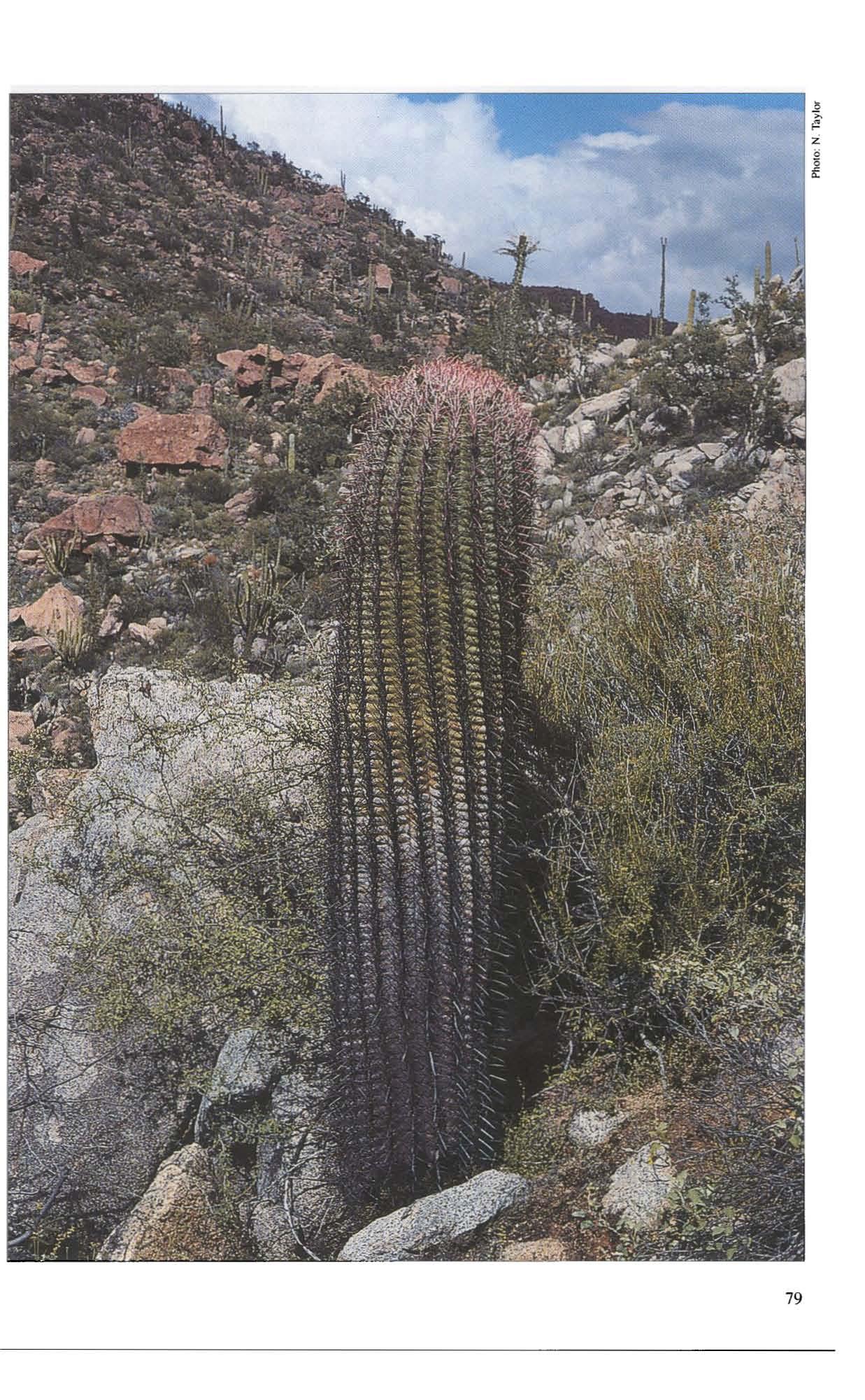

holotype of F horridus (US); I.indsay 5I 5, 1979,
1996.2242 IDS. SD); Moran 3942. 4118 IDS. SD); Wiggins 5718 IDS); Lau 15; Rep. 735; S8 1285. 1481,1684,1685,1686, 1687, 1688; DJF 30.
Synonyms: Echinocactus peninsulae, F. horridus (not as applied erroneously horticulturally - see F. wislizeni subsp. herrerae)
Section Ferocactus F. robustus group
References:
Ferocactus peninsulae (F. A. C. Weber) Britton &
Rose. The Caet. 3:133. jig. 140 (/922); F. A. C. Weber, Bull. Mus. Hist. Nat. Paris 1:320 (/895). & 4:101 (plate). 102·103 (1898); Engelmann in J. Coulter, Contrib. US. Nat. Herb. 3:361 (1896); Rowley et ai, Caet. Suee. J. (GB) 41:JJ2 (co!.p!. D. R. Hunt)
(1979); Unger, Die grossen Kugelkakt. Nordamer. /77
(/992); Miiller, Kakt.u..a.Sukk. 47(6):JJ7 (/996); Lindsay. Femcaetu.' 2//-237, 409, 436 (/996; thesis 1955. unpublished at the time); Hunt (ed.). CITES Caet. Checklist 205 (1999); E. F. Anderson. The Cactus Family 333-4 (2001)
Fig. 91 (below): F. peninsulae subsp. peninsulae in a rocky area north of Santa Rosalia. with "Boojums"
for company
Ferocactus peninsufae subsp. santa-maria
Nigel Taylor regarded this as a variety of F. peninsulae in 1984. bUI in the most recent CITES Cactaceae Checklist (1999) it is regarded as a provisionally accepted species (i.e. not aecep.cd as a species nor as a subspecies
for sure). Anderson (2001) lists it as a species. adding that it "is closely related 10 F. peninsuJae". We here regard it as a subspecies of F. peninsulae. which it resembles in many respects, although it is a much smaller growing plant.
It is a good sUbspecies to grow since. as indicated above, if space is limited it is generally a smallergrowing plant, reaching about the size of a soccer football in malUrity. and will flower when it is about 12cm in diameter. It has the attractive strong spinalion associated with this species. It does not seem to be common in collections. but seed is regularly offered and the opportunity to grow this comparatively small-growing plant with flowers also promised at a modest size should not be missed.
It was distinguished by Taylor from subsp. fownsendianus on the basis of its smaller size. commonly globose. the ribs thick, sometimes conspicuously tuberculate, the areoles and spines often much larger, the central spines to J Icm andlor much slOuter. its restricted locality. larger fruits and seeds, and its spring flowering. If this and subsp. fownsendianus were 10 be regarded as separate species. this would get our first vote for such a move.
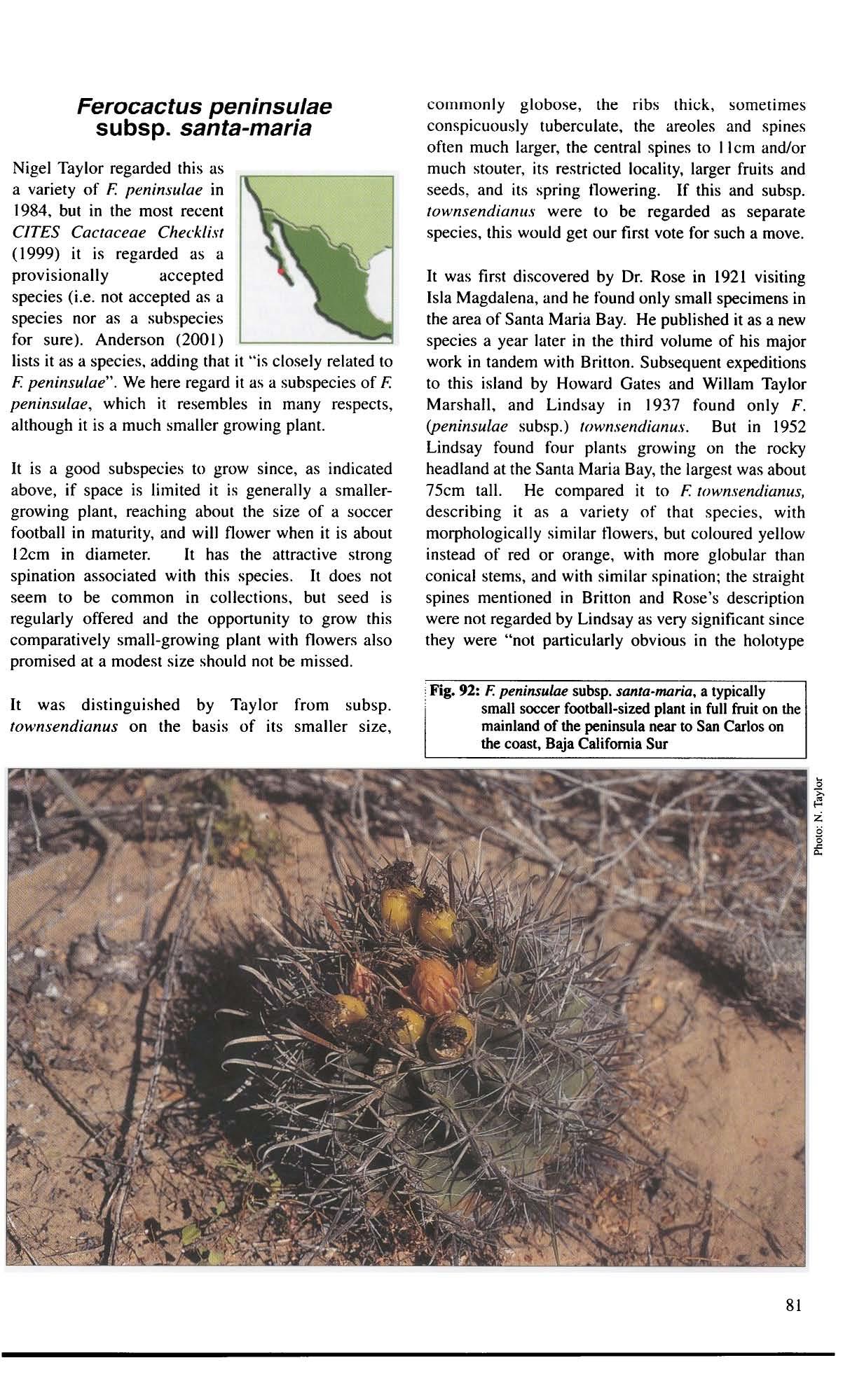
It was first discovered by Dr. Rose in 1921 visiting Isla Magdalena. and he found only small specimens in the area of Santa Maria Bay. He published it as a new species a year later in the third volume of his major work in tandem with Brinon. Subsequent expeditions to this island by Howard Gates and Willam Taylor Marshall. and Lindsay in 1937 found only F. (pen insulae subsp.) lownsendianus. But in 1952 Lindsay found four plants growing on the rocky headland at the Santa Maria Bay, the largest was about 75cm tall. He compared it to F. fOwnsendianus. describing it as a variety of that species. with morphologically similar tlowers. but coloured yellow instead of red or orange, with more globular than conical stems. and with similar spination; the straight spines mentioned in Britton and Rose's description were not regarded by Lindsay as very significant since they were "nOI particularly obvious in the holotype
!Fig. 92: F. peninsuJae subsp. santa-maria. a typically : small soccer football-siz.ed plant in full fruit on the mainland of the peninsula near to San Carlos on the coast. Baja California Sur
specimen or those which I collected, and specimens of F. townsendianus from near Cape San Lucas with straight or barely curved central spines are not unusual."
h was described as commonly globose. often much smaller than the other subspecies, with thick ribs, sometimes conspicuously tuberculate, the areoles and spines much larger, and the central spines to II cm long. and/or much stouter. Flowers are yellow or orange, produced in the spring in the wild. Fruit is to 50mm long, 40mm in diameter, yellow. Seed is 2mm long. mall black.
Reported from Mexico, west coast of BAJA CALIFORNIA, on Isla Magdalena by Santa Maria Bay, and the west edge of Llano de la Magdalena near San Carlos; at near sea-level to 10m, in flat. sandy areas.
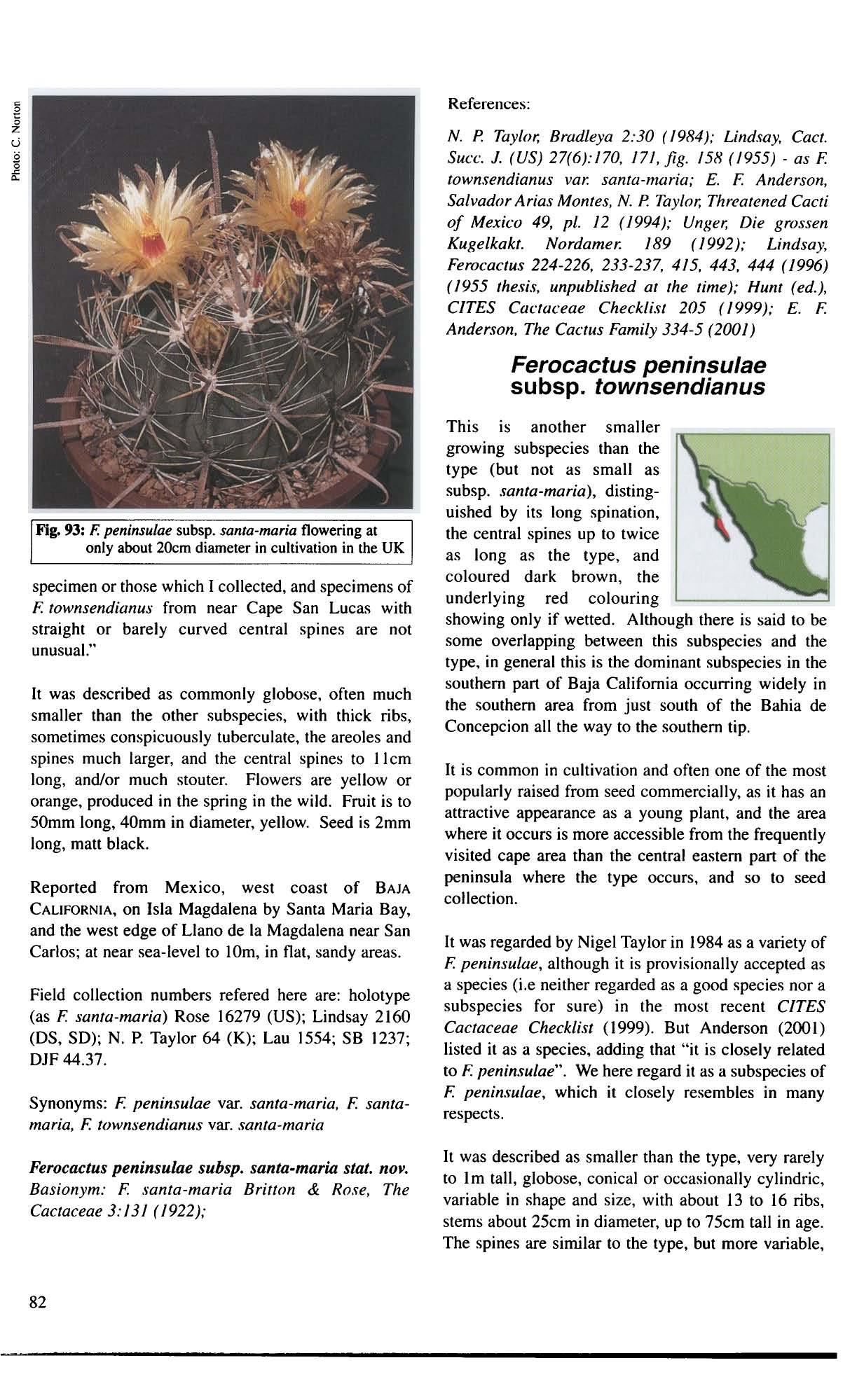
Field collection numbers refered here are: holotype (as F. santa·maria) Rose 16279 (US); Lindsay 2160 (OS. SO); N. P. Taylor 64 (K); Lau 1554; 56 1237; OJF 44.37.
Synonyms: F. peninsulae var. sanra-muria. F. santamaria. F. townsendianus var. santa-maria
Basionym: F. Junta-maria Brillon & Rose. The Cactaceae 3:131 (/922); N. P. Taylor, Bradleya 2:30 (1984): Lindsay. Cact. Succ. J. (US) 27(6):170. 171.fig. 158 (/955)· as F. townsendianus vat: santa-maria; E. F. Anderson, Salvador Arias Montes. N. P. Taylor. Threatened Cacti of Mexico 49, pI. 12 (1994); Unger, Die grossen Kugelkakt. Nordamer. 189 (/992); Lindsay. Ferocactus 224·226.233·237. 415. 443. 444 (/996) (/955 thesis, unpublished at the time); Hunt (ed.), CITES Cactaceae Checklist 205 (1999): E. F. Anderson. The Cactus Family 334·5 (2001)
Ferocactus peninsulae subsp. townsendianus
This is another smaller growing subspecies Ihan the type (but not as small as subsp. santa-maria), distinguished by its long spination, Ihe central spines up to twice as long as the type, and coloured dark brown, the underlying red colouring showing only if wetted. Allhough there is said to be some overlapping between this subspecies and the type. in general this is the dominant subspecies in the southern pan of Baja California occurring widely in the southern area from just south of the Bahia de Concepcion all the way to the southern tip.
It is common in cuhivation and often one of the most popularly raised from seed commercially, as it has an attractive appearance as a young plant, and the area where it occurs is more accessible from the frequently visited cape area than the central eastern part of the peninsula where the type occurs, and so to seed collection.
It was regarded by Nigel Taylor in 1984 as a variety of F. peninsulae, although it is provisionally accepted as a species (i.e neither regarded as a good species nor a subspecies for sure) in the most recenl CITES Cactaceae Check/isl (1999). But Anderson (2001) listed il as a species. adding Ihal "it is closely related to F. peninsulae". We here regard it as a subspecies of F. penimulae, which it closely resembles in many respects.
It was described as smaller than the type, very rarely to 1m tall, globose. conical or occasionally cylindric, variable in shape and size, with about 13 to 16 ribs. stems about 25cm in diameter, up 10 75cm tall in age. The spines are similar to the type, but more variable.
with 0 to 16 slender, whitish radial spines, the central spines sometimes straight or the central and lower radial spines reduced to only 5. Fruit is almost globular, about 25mm long, 20mm wide, yellow. Seed is 1.2 to 2mm long, matt black.
Reported from Mexico. south BAJA CALIFORNIA, from Cabo San Lucas at the tip of the peninsula to about 26° N. Isla San Jose. Isla Santa Margarita, Isla Magdalena, La Paz, Triunfo, Fraile Bay, Cabo San Lucas,between Queretaro and Pozo Grande, Boca de las Animas, San Gregorio, San Jose del Cabo, San Bartolo, Buena Vista; at lOO-450m altitude. usually in rocky areas or hillsides.

Field collection numbers referred here are: holotype Rose 16570 (US); Johnston 3935, 4084 (CAS); Lindsay 1919, 1968, 2248 (DS, SD); Lindsay DBG 275 (DES); Jones 27061 (POM); Remple 318 (AHFH); Wiggins 5711 (DS); Brandegee without no. (two specimens) (UC); Taylor quotes his collection number N. P. Taylor 59, from mountains to the south-west of San Javier; Lau 1421; Rep. 289. 589,593, 123h, 123m, 2199a; DJF 27.37,37.37; SB 1286; PP 150,151, 151A, 155, 165; JP 85/1254.
Ferocactus peninsulae subsp. townsendianus stat. nov. Basionym F. townsendianus Britton & Rose. The Cact. 3:127, fig. 133 (1922); References:
N. P. Taylor, Bradleya 2:28 (1984); Unger, Die grossen Kugelkakt. Nordamer. /84, 443, 444 (1992); Lindsay, Ferocactus 223-224, 237, 415 (/996) (1955 thesis. unpublished at the time); Hunt (ed.) CITES Cactaceae Checklist 205 (1999); E. F. Anderson. The Cactus Family 335 (2001)
This is a beautifully coloured species, the white hairlike radial spines contrasting wonderfully with Ihe stunningly bright red cenlral spines, and when the yellow and red flowers appear Ihe whole planl appears as if on fire. Planls grown in the Canary Islands under ideal conditions for slrong spine development are frequently seen offered in Europe some 25c01 or so tall and wide; these may flower althis size given good sunny condilions in cultivation.
It is one of the biggesl in the genus, making quite large individual stems, but notable for Ihe massive clumps il fonns in thewild, 3m or more across.
It was described as solitary or clustering, with siems to 3m tall, 50cm in diameter, with 13 to 20 ribs. There are numerous whitish, radial bristles, although these are somelimes absent. There are 6 to 12 main central spines, to 50mm long. strong, usually red (but plants with yellow spination occur in some populations of this species), more or less straight. Flowers are yellow to red, cup shaped. 4001m long, 250101 wide, pelals remaining more or less erect, stigmas yellow. Fruit is ovoid, yellow, 30 to 400101 long, covered wilh rounded scales, fleshy and acid, marketed for use in Ihe same way as for lemons. Seed is about 1.7Smm long, dark brown.
It should be mentioned here thal Ihe name preferred by Unger is F. pili/erus, and he quotes the description of it as such according to Lemaire ex Ehrenberg in 1848, which predares the first valid description of it as Echinocaclus pilosus by two years. Bm Taylor rejects this name as inadequately typified, and poinls out that Unger has not provided a neotype, "an essential prerequisite for the certain application of names based only on descriptions". In Ihe light of this, and the facl that it is the more widely used name, F. pilosus is
Fig. 98 (opposite page): F. pilosus, a majestic clump standing proud waiting to be photographed - again!
Fig. fJ7 (below): F. pilosus, a clustering, glowing red·spined plant of this favoured species at Nunez, San Luis Potosi,
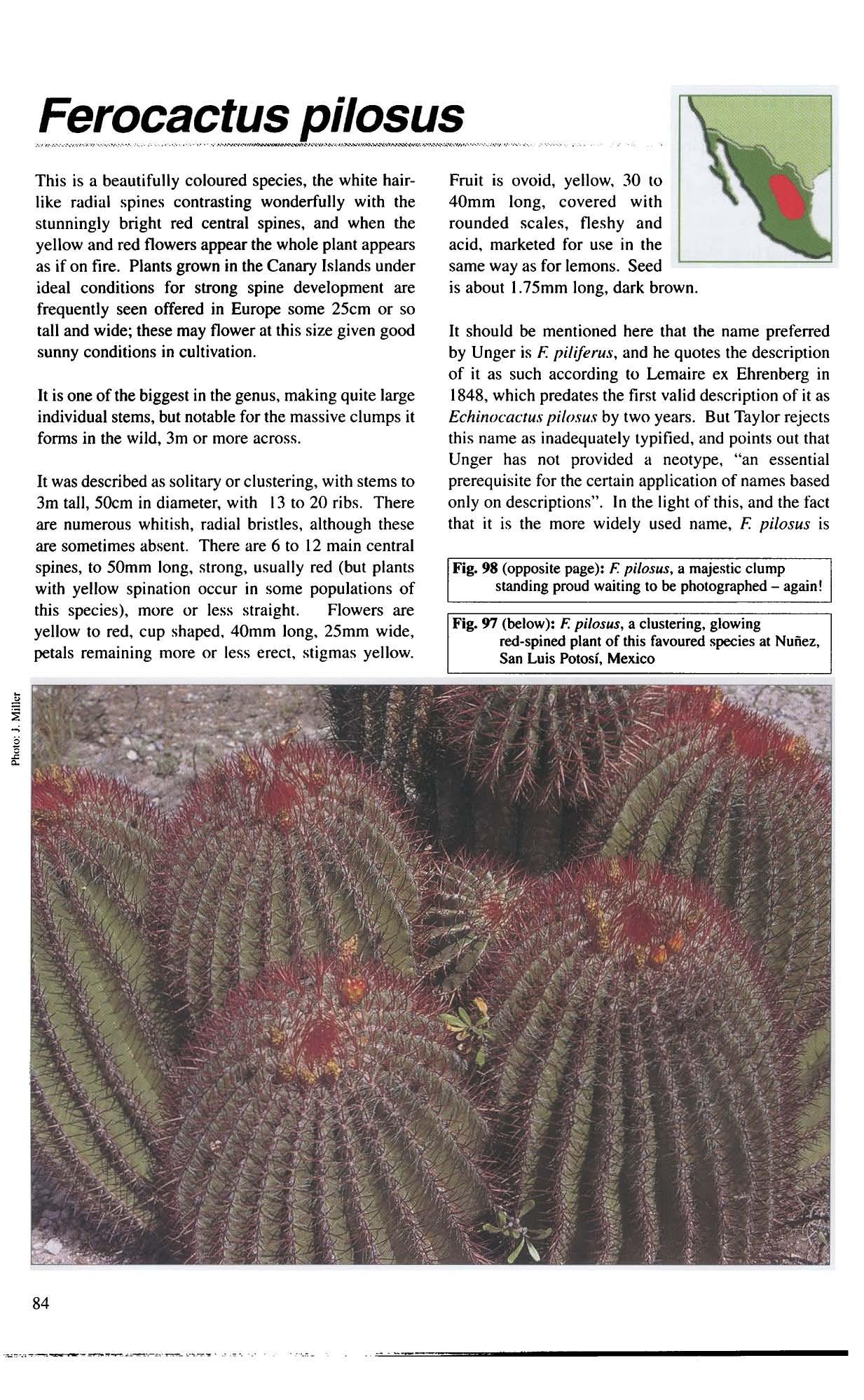
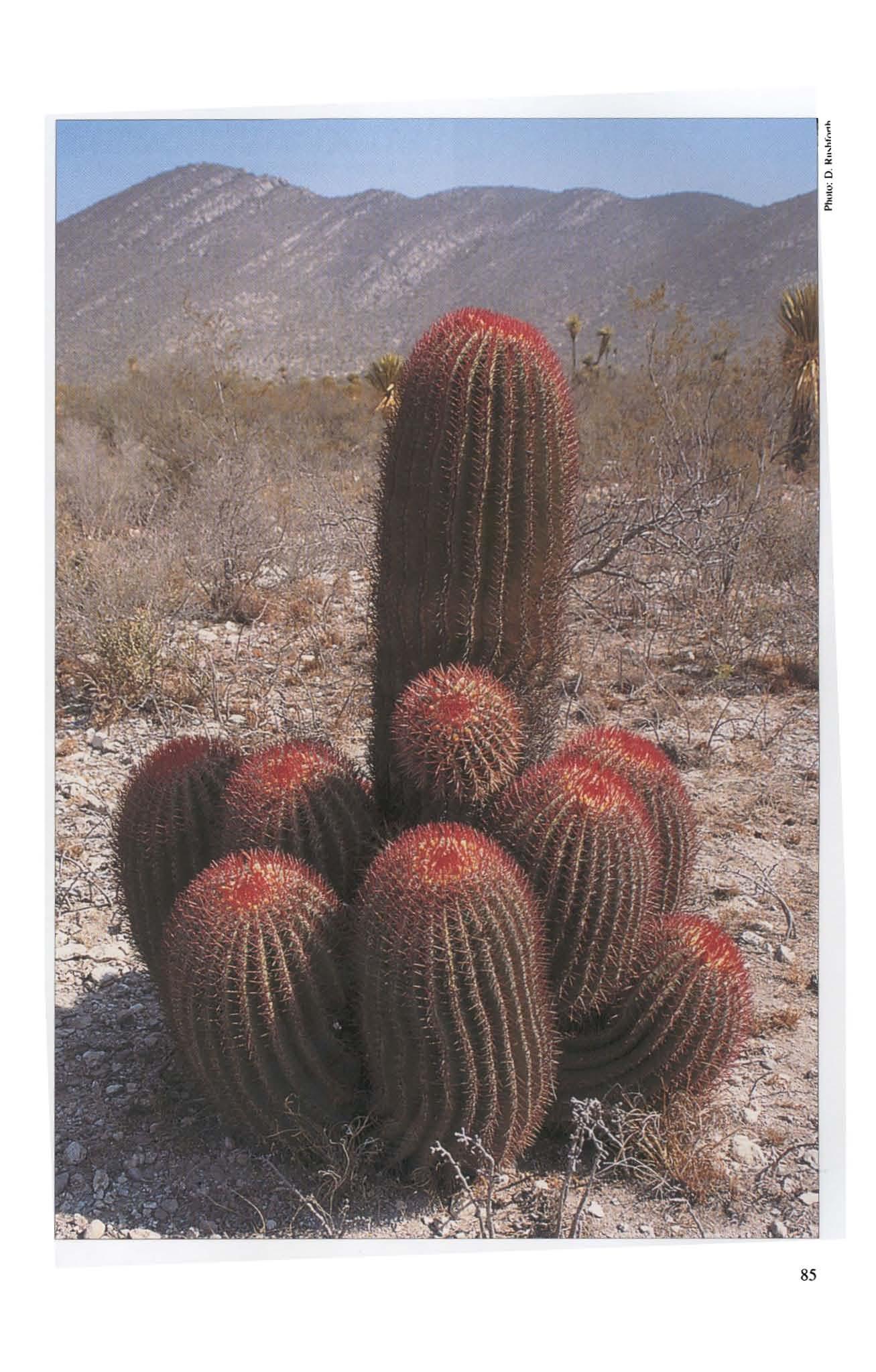
favoured here. This name also has precedence over F. staines;i, which is sometimes used as an allernative name under this species, but which was not validated as such until 1922. F. sWinesii is also sometimes applied (quite incorrectly) to variants of F. pilosus lacking hair-like radial spines: compare Britton & Rose's description of F. stainesii as differing from F. pi!osus in having more distant ribs, the areoles more widely separated, the spines duller coloured, more numerous, somewhat curved, two of them decidedly flattened, and the hairs white!
Reported from the Mexican states of SAN LUIS ParaSI, ZACATECAS, DURANGO, NUEVO LE6N, COAHUILA and TAMAULIPAS in the Chihuahuan desert: specifically from SAN LUIS POTOSI, E of San Luis Potosi Guadalcazar crossing, Huizache, Bonita, Zaragoza de Solis, La Jolla, Ciudad Maiz, Matehuala, Catorce; from ZACATECAS, Concepcion del Oro, Cedros: from DURANGO, Cerro Viznaga near San Bartolo; from NUEVO LE6N, Ascencion, Aramberri, Escondido, San Roberto, between Saltillo and Nuncio: from COAHUILA, on the road from Saltillo near Nuncio, and Viesca, and Parras, Ramos Arispe,Carneros, Saltillo, Sierra de Parras, Jimulco: from TAMAULIPAS, Lano de los Azua: usually in flat, sandy soil, at I.200-2,400m altitude. To say the least it is a widespread species.
Field collection numbers referred here are: neotype Lindsay 2588 (OS); Lindsay 2043, 2614 (OS, SO); Pringle without no. (UC), Pringle 154 (US); Purpus without no. (UC); Lau 1419, 1420; Rep. 379, 696a, t221b, t242d, t271, 1791a, 21580, 2276a, 2279a, 2331a,2335a, 2349b; DJF 620,627, 758.37; 58 819, 1618,1619; LH 345; CSO 88.110; CZlCH 115.

Synonyms: Echinocactus piliferus. E. pilosus, E. pilosus Ivar.) pringlei, E. pi/osus [var.] staines;;, F. piliferus, F. piliferus var. fJavispinus, F. piliferus var. staines;;, F. pilosus (var,) stainesii, F. pringlei. F. staines;;, F. stainesii var. haematacanthus (sensu Backeberg), F. staines;; var, pilosus, F. .Hainesii var. pringle;
Section Ferocactus F. robuslUs group
References:
Ferocat;tus pUosus (Galeaui ex Salm-Dyck) Werdermann in Fedde's. Rep. Spec. Nov.. SonderBeih. C. Ltg. 18, pl. 72 (1933); Galeott; ex Salm-Dyek. Caet. Han. Dyek. 1849. 148 (1850); N. P. Taylor, Bradleya 2:35 (/984); I.e. 5:96 (/987); Unger, Die grossen Kugelkakt. Nordamer. /62 (1992) as F. piliferus; Lindsay, Ferocactus 157-167, /9/, 437 (/996) (/955 thesis, unpublished at the rime); E. F. Anderson. The Cactus Family 334 (200/)
Ferocactus pottsii
Like a huge. blue-grey melon with spines. this is a good-looking. species with fat. wide. prominent ribs. The spination is unusual in being comparatively unferocious, and the plants have more body apparent Ihan most Ferocactus species. In the UK in cultivation it takes a long time to bloom, and seems to need 10 be about 25 or 30cm in diameter before it will achieve Ihis, but is wOl1h the wait for the beautiful, clear yellow, large flowers with contrasting red stamens. The open. relatively unprotected body of this plant is prone to damage from nearby more spiny species. and care is needed when placing it in a collection of Ferocactus species. or when transporting it to shows.
osanus (vaT. platygonus), bUI this is nowadays regarded as a redescription of this species. Nevertheless Lindsay's description is far more detailed than older accounts, and is quoted here.
He described it as solitary. to Im tall. 40cm in diameter (Taylor says 50cm), but usually much smaller, globular to short-cylindric. with usually 13 ribs, sometimes more in very large plants (Taylor says up to 25) broad and obtuse. There are 3 to usually 8 radial spines. to 25 to 45mm long. slightly nauened.
Fig. 101: F. pottsii with its typical unferocaclUs·like. sparse spination. bedded out at the Ruth Bancroft Garden. Walnut Creek, California, USA

The single central spine is up to 75mm long, straight Flowers are light greenish-yellow, 45mm long, 35mm wide, stigmas yellow. Fruit is ovoid, yellow, to 40mm long, 30mm in diameter, with broad scales. Seed is dark brown to black. to 3mm long, 2mm broad.
Reported from the Mexican states of SONORA CHIHUAHUA, SINALOA. and DURANGO, specificall; from SONORA, Guirocoba, E of Alamos, on the western slopes of the Sierra Tarahumara, Sierra Alamos, Taymuco, Sierra Canela near San Bernardo; from CHIHUAHUA, Villa Humada, at1,200m altitude, La Bufa/Rio Batopilas; from SINALOA, in arid SUbtropical thorn forest or higher in the pine belt, San Bernardo, Sierra Canela; from DURANGO in the east· at 1,150-I,8oom altitude. '
Field collection numbers referred here are: the type Bool & Lindsay without no. (DS, the synonymous F. alamosanus var. platygonus); Lau 1257; Rep. 534, 1589.
Section Ferocactus F. pottsii group
References:
Feroeaetus pottsi; (Salm-Dyck) Backeberg. Die Caet. 5:2738, fig.26oo (1961): Salm-Dyek, AUg. 18:395 (1850); Schumann, Gesamtb. Kakt. 327-328, fig.57 (1898); G. Lindsay, Caet. Suec. J. (US)14( /01/):139.wilh figs. (/942) - as F. alamosanus var. platygonus; S('hwarz ex Backeberg. Die Caetaceae 5:2743 (1961) - as F. guirocobensis (mentioned as a catalogue name); Unger, Kakl.u.a.5ukk. 22(10): 184187, figs. 1-4 (/97/); Glass & Foster, Cael. Succ. 1. (US) 56(2):62-63, figs.5.? (/984): N. P. Taylor, Bradleya 2:36 (1984); Unger, Die gmssen Kugelkakt. Nordamer. 248 (/992); Lindsay, Femeaetus 124-/25, 127-/29,139 (/996) (/955 thesis, unpublished allhe lime) - as F. alamosanus var. plarygonus; E. F. Anderson, The Cactus Family 334 (200/)

Ferocactus recurvus
Taylor in his paper on the genus abandoned this taxon for lack of typification, rejecting Lindsay's neotypification, and regarded it as subsidiary to F. talispinus, adopting the later typified name for it as F. latispinus var. spiralis, recenlly modified to F. latispinus subsp. spiralis. But this view has not gained ground in the subsequent 20 years, and most other authorities on the genus, and collectors too. have followed Lindsay and maintained it as F. recurvus. Ungee goes one step further and maimains it as a species and reduces F. talispinus beneath it.
Having seen this species and F. /atispinus extensively in the wild, we think thai there are sufficient differences in body shape, spination, flower and separate geography to follow the mainstream of thinking. and it is here regarded as a good species separate from F. latispinus. In addition, we have recognized Charlie Glass's var. greenwoodii as a subspecies, see below.
To be fair to Nigel Taylor, who was good enough to read through our text with some tolerance. he commented on the above conclusion that "to be consistent, you (i.e. we) should raise most of the subspecies recognized in this book to rank as species!" Tempting as this was we have not followed his advice.
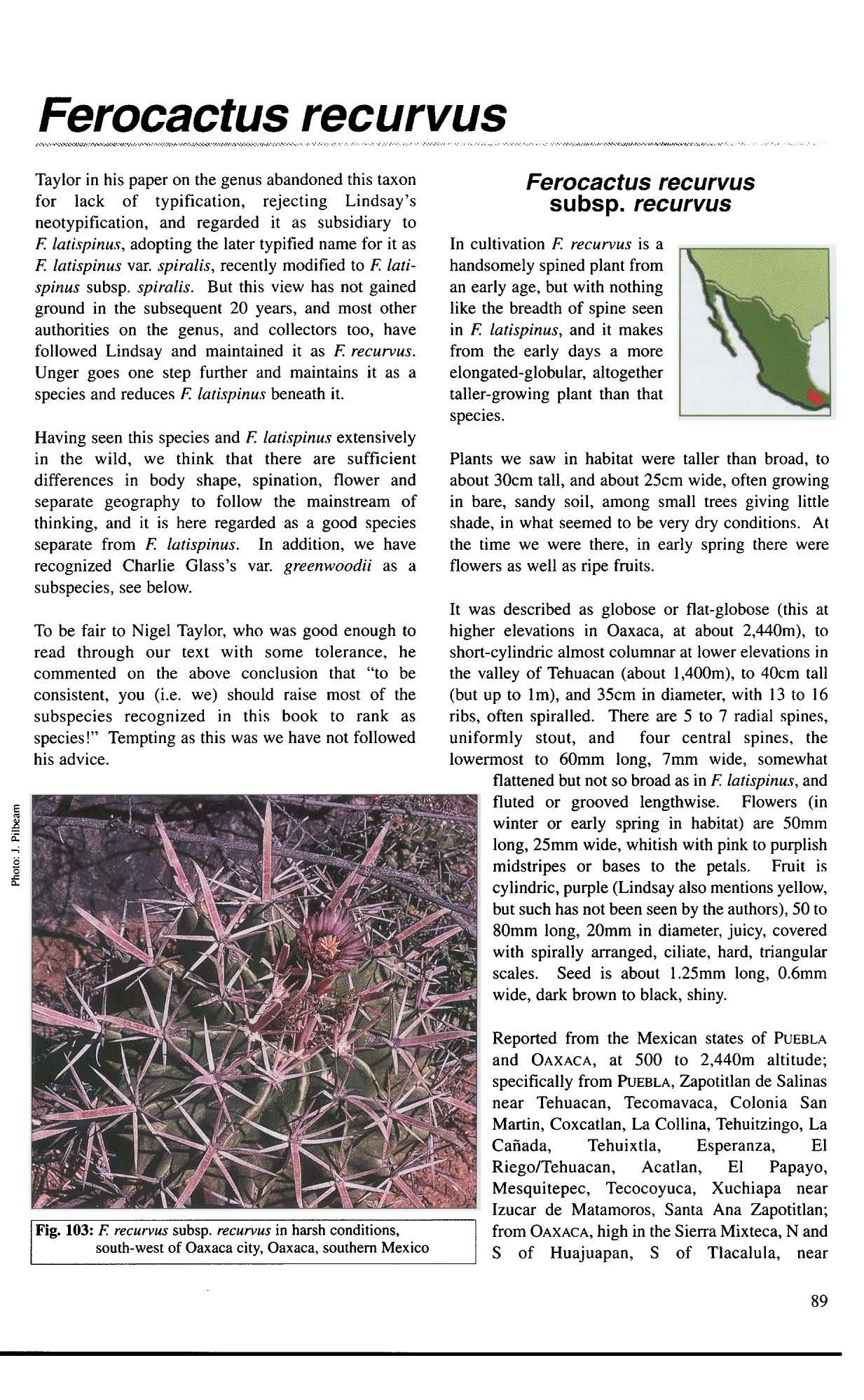
Ferocactus recurvus subsp. recurvus
In cultivation F. recurvus is a handsomely spined plant from an early age. but with nothing like the breadth of spine seen in F. latispinus, and it makes from the early days a more elongaled-globular, allogether taller-growing plant than that species.
Plants we saw in habitat were taller than broad, to about 30cm tall, and about 2Scm wide, often growing in bare, sandy soil, among small trees giving liule shade. in what seemed to be very dry conditions. At the time we were there, in early spring there were flowers as well as ripe fruits.
It was described as globose or flat-globose (this at higher elevations in Oaxaca, at about 2,440m), to short-cylindric almost columnar at lower elevations in the valley of Tehuacan (about 1,400m), to 40cm tall (but up to 1m), and 3Scm in diameter, with 13 to 16 ribs, often spiralled. There are 5 to 7 radial spines, uniformly stout, and four central spines, the lowennost to 60mm long, 7mm wide, somewhat flattened but not so broad as in F. larispinus, and fluted or grooved lengthwise. Flowers (in winter or early spring in habitat) are SOmm long, 25mm wide, whitish with pink to purplish midstripes or bases to the petals. Fruit is cylindric, purple (Lindsay also mentions yellow, but such has not been seen by the authors), 50 to 80mm long, 20mm in diameter, juicy, covered with spirally arranged, ciliate, hard, triangular scales. Seed is about 1.2Smm long, 0.6mm wide, dark brown to black, shiny.
Reported from the Mexican states of PUEBLA and OAXACA, at 500 to 2,440m altitude; specifically from PuEBLA, Zapotitlan de Salinas near Tehuacan, Tecomavaca, Colonia San Martin, Coxcatlan, La Collina, Tehuitzingo, La Canada, Tehuixtla, Esperanza, EJ RiegolTehuacan, Acatlan, EI Papayo, Mesquitepec. Tecocoyuca, Xuchiapa near Izucar de Matamoros, Santa Ana Zapotitlan; from OAXACA, high in the Sierra Mixteca, Nand S of Huajuapan, S of Tlacalula, near
Tehuantepec. San Jo:-oe Lachiguiri. Teotitlan. Milia, Matallan, Cuicatlan, Totolapan. Tamilzulapan. Tecomavaca. Chazumha. Nieves, Rio Salado, San Martin, Tomellin, Sierra Mixteca, Tilapa, Barmnca Ixcatlan; in flat, sandy areas al lower levels, but also found in the mountains. at 1,400-2.500m altitude,
Field collection numbers referred here are: neolype Lindsay 2060 (OS); Lindsay 2597, 2600,2606, 2609 (DS), 2608 (OS, SD); Lan 1408; Rep. 110, 131, 153, 163a, 167, 321, 834a, 851, 858a, 898a, 924b,927b, 957e, 1043a, 1321c, 1342a, I462a, 1656a. 1677a; FO.68, 138; S8 547; CZlCH 153,162, 175.
Synonyms: Bi:muKu reeurvu, Coetus nobilis, C. recurvus, Echinocactus Jpiralis, F. latispinus subsp, spiralis, F. loti,\pinus var, spiralis, F. nobilis, F. recurvus var. spirali!)'
Section Bbnaga F. latispinu:-o group
References:
Feroeaerus ({'('UTVUS (Miller) Ito. Ca<'t. 105 (}952); Miller, Gard, Diet. ed.8 (/768); Brillon & Rose, The Caet. 141·3(1922) - as F. nobi}is; Glass, Caet, Succ. J. (US) 40(4):161./ig. 5 (centre) (1968); N. P. Taylor, Bradleya 2: 26 (1984) - as F. latispinus var. spira/is: & 5:96 (/987): Lind.<a>, FemcaclU.. 141·148. 191. 440 (/996) (/955 thesis, unpublished at the time); UnKer, Die Krossen Kugelkakr. Nordama 294 (1992): E. F. Anderson. The Cactus Family 332 (200}) - as F. latispinus subsp, spiralis

Ferocactus recurvus subsp.greenwoodH
Taylor does not acknowledge this laxon in the CITES CaclOceae Checklist (1999), although he endorsed it as a good variety in his 1984 review, albeit as a variety of F. latispinus. Having been taken 10 the Iype locality by its finder, Charlie Glass. and listened to his enthusiasm for its distinct appearance, we are happy to regognize it here as a subspecies. Inspired by the earlier glimpse of this SUbspecies in the company of Charlie Glass, we visited the area in Ihe autumn of 2003, so that we could see it. hopefully in flower, which it had not been on our previous spring visit. We found that it is widespread on the road from Oaxaca to Nejapa de Madero. a:-o well a:-o in Ihe surrounding countryside. as we came across it again when we visited the remote village of San Jose Lachiguiri, Ihe type locality of Ortego('aClUs mllcdollKlll/ii. To
our surprise we also found it planled in Ihe forecoun of a pelrol station. where a local lad told us enthusiastically that il was a popular plant in the area as il was used in the production of cactus candy. The larger plants were cored. the soft interior flesh cubed and soaked in sugar to form a tasty sweetmeat. Fortunately there seemed to be a large enough population to withstand this local predation. helped perhaps a little by the preference for mature plants, which would enable some regeneralion to have taken place before they were culled for the locals' sweet toolh.
As hoped for. the plants were in flower, and we were enlightened as to the mystery of the flower colour, described as "straw yellow". unlike the pale pink flowers of the Iype. Mary McLenahan, who accompanied us to this site. was asked how she would describe the COIOUf of the flowers, and her reply was accurate and apposite: pale, glassy yellow; the throat of the flowers by the way is like the type, deep pinkish-purple. I am sure that Charlie would have approved of Ihis description.
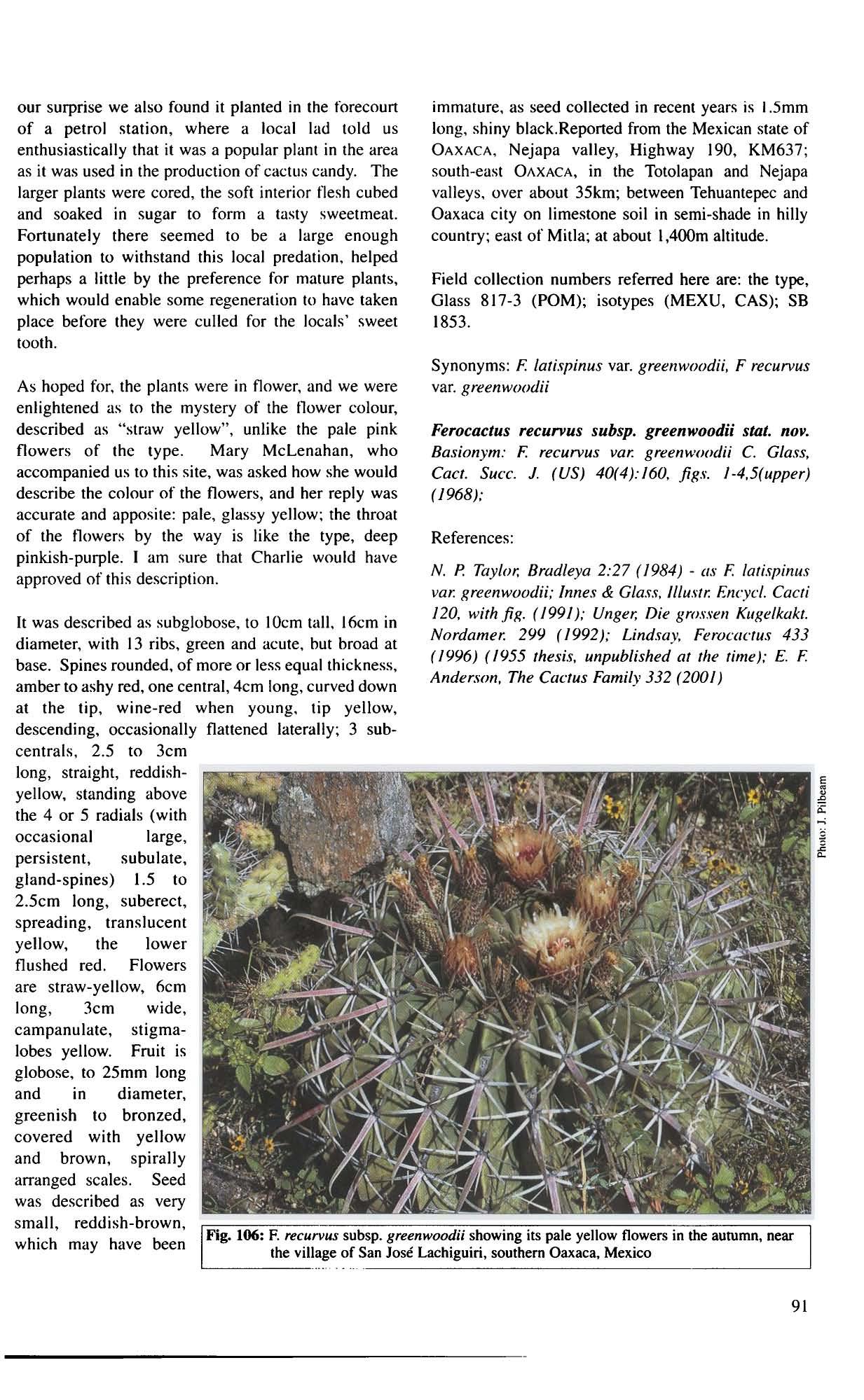
It was described as subglobose. to IOcm tall. 16cm in diameter, with 13 ribs. green and acute. hut broad at base. Spines rounded. of more or less equal thickness, amber to ashy red, one central, 4cm long, curved down at the lip. wine-red when young, lip yellow, descending, occasionally flattened laterally; 3 subcentrals. 2.5 to 3cm long, straight, reddishyellow. sianding above the 4 or 5 radials (with occasional large, persistent. subulate. gland-spines) 1.5 (0 2.5cm long. suberect. spreading. translucent yellow, the lower flushed red. Flowers are straw-yellow, 6cm long, 3cm wide, campanulate, stigmalobes yellow. Fruit is globose, to 25mm long and in diameter, greenish 10 bronzed. covered with yellow and brown. spirally arranged scales. Seed was described as very small, reddish-brown. which may have been immature, as seed collected in recent years is 1.5mm long, shiny black.Reponed from the Mexican state of OAXACA, Nejapa valley, Highway 190, KM637; south-east OAXACA, in the Totolapan and Nejapa valleys. over about 35km; between Tehuantepec and Oaxaca city on limestone soil in semi-shade in hilly country; east of Mitla; al about 1,400m altitude.
Field collection numbers referred here are: the type, Glass 817-3 (POM); isotypes (MEXU, CAS); SB 1853_
Synonyms: F. latispinus var. greenw()odii, F recurvus var. greenwoodii
Ferocactus recurvus subsp, greenwood;; stat, nov. Basionym: F. recurvus var. greenwoodii C. Glass, Cae/. Suec. J. (US) 40(4):160, figs. 1-4,5(upper) (1968):
References:
N. P. Taylor, Bradleya 2:27 (/984) . as F. lalispinus var. greenwoodii; Innes & Glass. Illu.\,tr. £ncyc/. Cacti /20. with fig. (199/); Unger, Die grossen Kugelkakl. Nordamer. 299 (/992); Lindsay, Ferocuctus 433 (/996) (/955 thesis, unpublished at the time).' E. F. Anderson, The Cactus Family 332 (200/)
Ferocactus robustus
To see the huge clumps of this species growing in the wild in calcareous areas on the flat ground is an amazing sight. It is one thing to read that clumps can reach Im tall and Sm across, but this does not prepare you sufficiently for the initial sight of such monsters with hundreds of stems - it is overwhelming. The large clump pictured is in the Mexican state of Puebla, at Tecamachalco, where we were taken by Charlie Glass, principally to see MammUlaria peclinijera, the taller flush with the ground in limestone, where it was finding life above ground difficult But nol so the Ferocactus, which looked as if they could survive any amount of aridity with their massive bulk. As if taking sustenance from its protective presence there was the odd Mammillaria mystax growing amid the many stems of Ihe largest of the Ferocactus.
In cultivation a liule extra warmth is necessary in winter to stop brown marks developing on the rib apices, and it is a species which has a nasty habit of developing brown marks around the base of the stems; the best treatment to combat this seemingly natural habit is to try to keep ahead of the marking by potting the plants on fairly frequently and growing them fast; it will start to cluster when barely 8 cm or so in diameter. Plants are not easily flowered in the UK, and a plant grown for 20 years in cultivation, with many heads and a diameter of about 40cm has not yet obliged, but hopefully there will be some reader of these lines who will inform us otherwise.
It was described (with our additional comments in brackets) as clustering, forming huge mounds to 1m tall, and to Sm in diameter, (the visible part of the siems more or less globose, to about IOcm in diameter, green), with about 8 acute ribs. There are 10 to 14 radial spines (thin and bristle-like,white), and 4 to 7 much stronger central spines, straight or a little curved, angled or flattened (reddish-brown). Flowers are yellow, (wilh some of the outer petals reddish), 30 to 40mm long and wide, stigmas red. Fruit is yellow, 20 to 30mm long, 20mm in diameter, with broad. widely separated, fleshy scales. Seed is I.Smm. black.

Keported from the Mexican state of PuEBLA, specifically from Tlacotepec, Tehuacan, Tecamachalco, Cacaloapan, Zapotitlan de Salinas; on level areas in
limestone, at 1,500-2, 100m altitude.
Field collection numbers referred here are: neotype. Lindsay 2058 (DS); Lau 1417; Rep. 93.109; FO.69; CZlCH 128.
Synonym: Echinocactus robustu:;
Section Ferocactus F. robuslus group
References:
Ferocactus robustus (Pfeiffer) Britton &
Rose. The Caetaeeae 3: 135, fig.143 (19221; Pfeiffer, Enum. Cacl. 61 (1837); & Nov. Ac·t. Not. Cur. 19(/):pl./6. fig.3 (/839); Krainz. Die Kakteen Lfg.30. C Vlllc, wilh figs. (/965); Krahenbuhl, Kakl.U.a.Sukk. 33(8):170, 171 (/982); N. P. Taylor,
Bradleya 2:27 with fig. (/984): Unger, Die grm;sen Kugelkakt. Nordamer. 90 (1992),' Undsay. Ferocactus
the time): E. F. Anderson, The Cactus Family 334
(2001)
Fig. 109: Bill Weightman, John Pilbeam and Derek Bowdery in [olal disbelief a[ 'The biggest Ferocactus in the world" as Gracie Fields might have sung.

Ferocactus schwarz;;
This is it species which resembles Echinocactus grusonii when young. particularly in its strongly tubercled appearance, but with less prominent spines. After about four years the ribs start to develop and it takes on the acutely ribbed characler and dark green colouring of the malOre plant. The intense dark green coloration of the body and the sharply ridged ribs with continuous yellow fell in youth make this an extremely attractive species to grow at all stages. Aowers can be expected on plants of about J2cm in diameter in cultivation in the UK, and these add to its chann.
It was described enthusiastically by Lindsay in honour of Fritz Schwarz. who had discovered it in the mountains of the Mexican state of Sinaloa, and brought it back to grow in his garden in San Luis PotosI. By the time Lindsay got to him Schwarz had already distributed it widely under the name F. schwarzii. and Lindsay saw no reason to confuse the issue by changing this name in his fonnal description in the US journal. He pictured the plant Schwarz had collected. which was of considerable size and showing early flower buds; he also pictured a younger plant showing clearly an attractive feature of this species, the almost continuous fell down the ridge of the ribs.
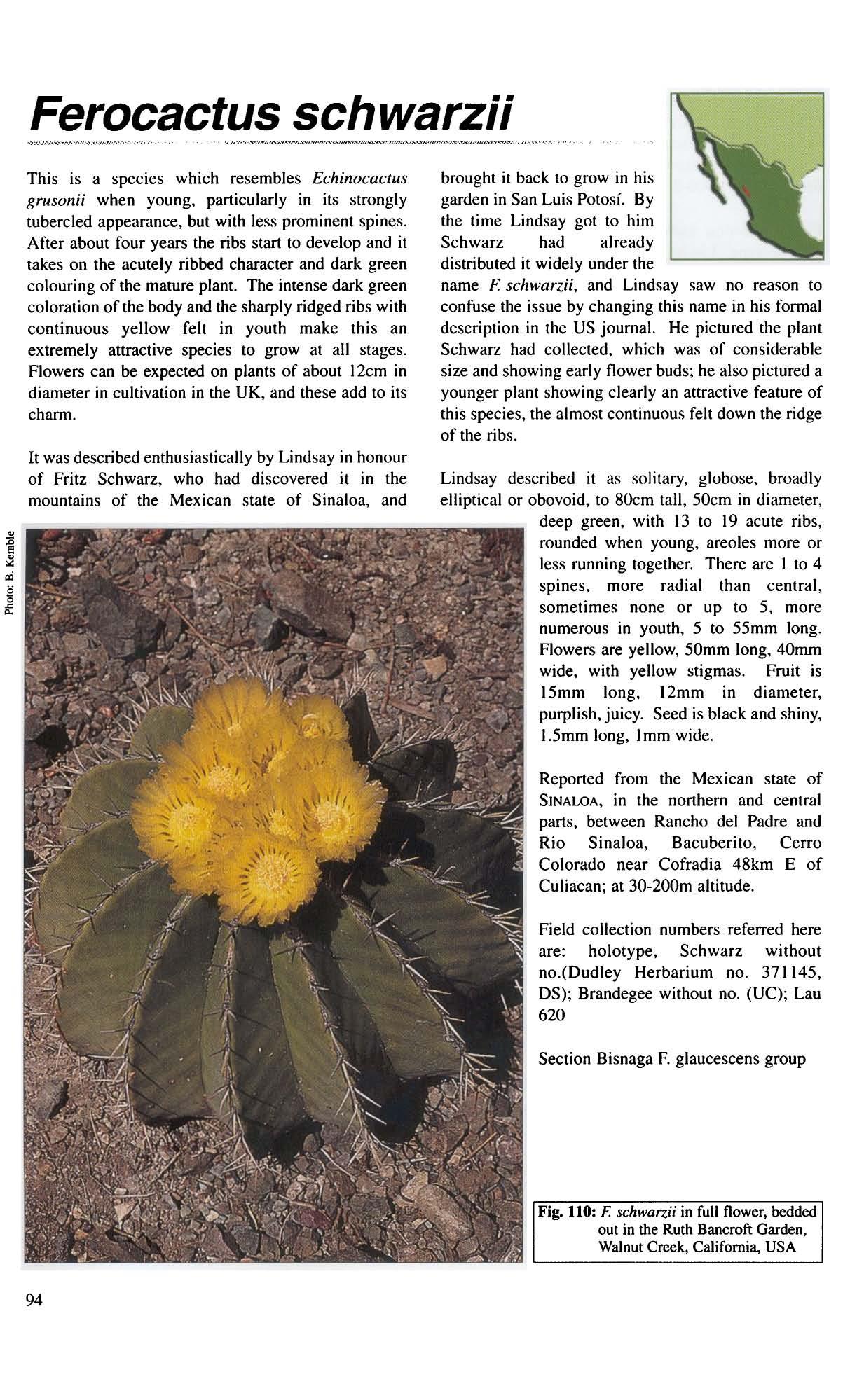
Lindsay described it as solitary, globose. broadly elliptical or obovoid, to 80cm tall, 50cm in diameter, deep green. wilh 13 to 19 acute ribs, rounded when young. areoles more or less running logether. There are I to 4 spines. more radial Ihan cenlral, sometimes none or up to 5. more numerous in youth. 5 to 55mm long. Rowers are yellow. 50mm long. 40mm wide. wilh yellow stigmas. Fruit is 15mm long. 12mm in diameter, purplish, juicy. Seed is black and shiny. 1.5mm long. I mm wide.
Reported from Ihe Mexican stale of SINALOA. in the northern and cenlral parts, between Rancho del Padre and Rio Sinaloa, Bacuberito, Cerro Colorado near Cofradia 48km E of Culiacan; at 30-200m altitude.
Field colleClion numbers referred here are: holotype. Schwarz withoul oo.(Dudley Herbarium 00. 371145, DS); Braodegee withou, 00. (UC); Lau 620
Section Bisnaga F. glaucescens group
Fig. 110: F. schwarzii in full flower, bedded out in the Ruth Bancroft Garden. Walnut Creek, California. USA
FerocaClUJ schwarz;; G. Lindsay, Caet. Suet:. 1. (US)
27(3):70·72, with figs. (/955);
Krainl" Die Kakleen, Lfg. 33, C
Unger, Die grossen Kugelkakt. Nordamer. 403 (1992); Lindsay,
Ferocacfus //1·/14, /39, 442 (1996) (1955 thesis,
publiJhed at the lime): E. F. Anderson, The CaetlLf Family
335 (200/)

Ferocactus viridescens
This species is one of those thaI anyone can find room for, obligingly small-growing. and flowering in the UK at an early stage of its growth, at about 5 years old from seed and about IOcm in diameter; even fully grown it is a comparatively small plant for the genus. Although variable in flower colour from yellowishgreen to green, it adds a rare hue to the collection, but some plants produce flowers coloured a rather washed-out yellowish green. and the more attractive intense shades of green should be looked out for, unless you have a superstition about this colour.
Ferocactus viridescens subsp. viridescens
This, the type. was described as solitary or occasionally clustering, to 30cm tall (but often lower growing), and to 30cm in diameter. but some populations inland have been reported with much largergrowing specimens. to 1.3m tall. 40cm in diameter. (We have never seen these larger plants either in the wild or in cultivation. and wondered if there is some confusion with subsp. linoraJis, which is larger and much more spiny; Nigel Taylor however is of the opinion that these larger plants could be a connection to F. gracilis.) Stems are depressed-globose to cylindric, with 13 to 25 ribs (occasionally up to 30), obtuse and somewhat tuberculate (especially in young planlS). mid green. There are about 8 to 15 (to 19) radial spines, some slender. bristle-like, others stronger and intergrading with the central spines. There are 4 (to 9) central spines, somewhat curved but not hooked, the largest upper and lower flattened, to 5mm wide, yellowish or reddish, ageing to grey. Flowers are greenish, sometimes with a darker, reddish midstripe. appearing in the wild in spring. to 50mm long. 60mm wide, stigmas yellow. Fruit is 35mm long, 25mm in diameter. at first green or reddish, ripening to light yellow. with scattered, lunate (crescent shaped), fleshy scales, which become transparent. Seed is black, to 1.5mm long, I mm wide.

Plants we saw in northern Baja California. near the coast not far south of the US border, were quite lowgrowing, no more than about 100m high and up to about 25cm in diameter. They were usually solitary, but the occasional clustering plant was seen. They were growing in sandy areas among grasses and within a stone's throw of the Pacific coast.
Reported from USA, CALIFORNIA, near San Diego. Escondido, Torrey Pines, Mission Hills, Otay, between Otay and San Ysidro. Coons Ranch, Cabrillo National Monument at Point Lorna; from Mexico, BAJA CALIFORNIA, from the US border southwards to near San Quintin; on rocky hillsides or sandy flat areas with grass, near the coast and in chaparral inland. at 10-400m ahirude.
Field collection numbers referred here are: holotype Nuttall without no. (BM); Lindsay 2616 (DS. SD). 2173 as F. arcut/ii (DS, SD); Peebles S. F. 305 (Ariz.); Parish 375 (DS); Brandegee without no. (VC); Setchell without no. (VC); Orcult 291 (Mo), 641 without no.(?) as EchinocUt.:tus orcuuii (Mo); Snyder without no. (SO); Schott without no. (Mo); Pringle 14359 (Mo); Abrams 3395 (DS, Mo, POM); Cohen
463 (POM); Benson 4281 (POM), 14366 (POM 278127); Rush without no, (AHFH); Wiggins 3245 (OS); Gander 489 as F. orcutt;; (SO); Wiggins & Gillespie 3910 as F. oreuttii (OS, POM, CAS, Mo, MEXU); Dawson 5129, 5140 (AHFH); Lau 1402; Rep. 232, 239, 247; OJF 4.37; SB 1238 (may be subsp. littoralis); JS 80; RP 99.
Synonyms: Echinocactus orcuttii. E. viridescens, F. califomicus, F. orcuttii, F. viridescens subsp.lvar. orcuttii
Section Ferocactus F. robustus group
References:
Ferocactus viridescens (7{Jrrey & A. Gray) Britton &
Rose, The Coer. 3: 140, pl. 14. l,fig. 148 (1922); Torrey & A. Gray, Fl. N. Amer. 1:554 (1840); Undsay, Caet. Sue. Mex. 10(3):76-91, fig. 50 (1965); L. Benson, Caeri US & Canada 703-705.figs.742-745 (1982); N. P. Taylor. Bradleya 2:30-31, with fig. (1984): Unger.
Die gmssen Kugelkakt. Nordamer. 97 (1992); Lindsay, Ferocactus 265-280 (1996) (1955 thesis, unpublished at the lime); Glass. Identification Guide Threatened Cacti Mexico I:FElVI unnumbered pages (/998, pub/. 1997); E. F. Anderson, The Cactus Family 335-6
(2001)
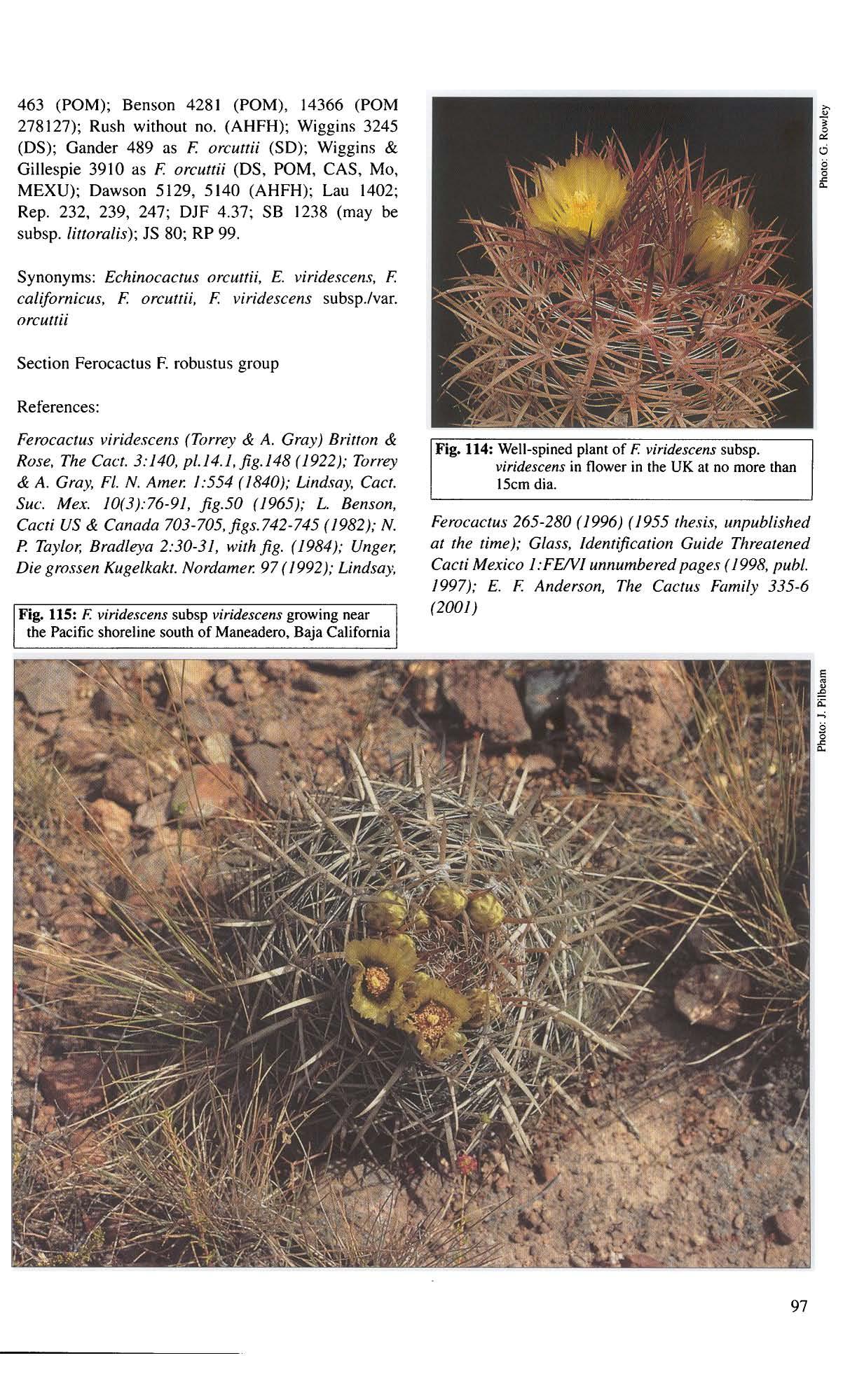
Ferocactus viridescens subsp. /ittoralis
Taylor does not acknowledge this taxon in CITES Cactaceae Checklist (1999), but its distinctive appearance. with a quite different habit from the type. and its separate recognition by other authorities (including Ted Anderson. 200 I), lead us 10 retain it as it is an attractive, if rarely seen collectors' plant. It is not often offered. and should be seized on if seen in commercial listings. either as planI or seed. It is distinguished by its lypically taller size. higher rib counl and higher number of central spines, more dense spination than the type and more golden hue. It presents no more difficulty (h,m the Iype, and is comparatively hardy.
II was collected as long ago as the early 19305 by a veteran of the peninsula, Howard Gales. who listed it in his 1934 catalogue using this name (as a variety), although [he name was not [hen formally published. It has a stem to 30cm tall, 18cm in diameter. solitary or rarely branched at the base. with about 21 to 34 ribs. There are 15 to 24 radial spines, needle-like to bristle-like. yellowish to white. Central spines number 7 to 9, yellowish or pinkish. round in section or slightly flattened. ribbed, usually slightly recurved. 20 to 40mm long. about 1.5mm wide. the four principal spines in the shape of an upright cross. with 3 to 5 additional spines above. Flowers are about 30mm long. 25mm wide. greenish-yellow. with reddish outer petals, yellow inner petals, stigmas red or yellow. Fruit is globular, about 15mm in diameter. shiny red or yellow. with broad scales. Seed is black. 1.5mm long. Imm wide.
Reported from Mexico. BAJA CALlFOI{NIA - the type: collected in 1960 on the seacoast bluffs at Puerto Santo Tomas. near 31° 33' N, 116° 41' W. by Reid Moran. another veteran of the peninsula. Also reported in distribution from the coastal zone of northern BAJA CALIFORNIA from north of Ensenada to Mision Santo Domingo: specifically at Punta Salsipuedes. Punta Banda, Puerto Santo Tomas, Punta

Calavaras, 3.7 miles SOUlh of San Isidro Erendira, 9.5 miles south of the same village. and 1.3 miles west of Mision Santo Domingo, also from near the Hidalgo Observatory, San Carlos Hot Springs. San Quintin, CardonaI near San Jorge, Rosario; at 800-I,OOOm altitude on rocky bluffs.
Field collection numbers referred here are: the type, R. Moran 8277(SO). isolypes MEXU. CAS. OS, UC, US; Lindsay 1843. 2071 (bolh as F. viride.fcens) (OS, SO); Oawson 5140 (AHFH); Lau 1253.
Synonym: F. viridescens var. Iittoralis
Section Ferocaclus F. robuslus group
References:
Femcactu.f viridescens subs". linoralis (Lindsay) F. & R. Woij; Die Ferokakteen der Baja California 207·208 (2004); G. Undsay, Cacl. Succ. J. (US) 36(/):8-/0, wilhfigs. (/964); N. P Taylor. Brodleyo 2:3/ (/984); Unger. Die gmS!ien Kugelkakl. Nordamer. 111 (1992); Undsay, Feraeactus 269-270, 277, 280 (/996) (/955 thesis. unpublished at the time); Glass, Identification Guide Threatened Cacti Mexico I:FElVI var. lilora!is
Fig. 118: Ferocaclus viridescens subsp. lit/oralis, golden balls of spines glowing in the Mexican sun, north of Ensenada, Baja California

Fig. 117: Ferocactus viridescens subsp. littoralis at the type locality near Punta Santo Tomas. Baja California. Mexico
(sic!), unnumbered pages (/998. publ. 1997); Hunl (ed.), CITES Ca,·I. Checklist 205 (/999); E F Anderson, The Cactus Family 335-6 (2001)
Ferocactus wislizeni
This species is one of the most commonly seen offered commercially as a young seedling, with the seed of the type ofcen present in mixed packets of seed. II grows quickly into a very spiny plant and will oblige with flowers at about 20cm tall and wide, exceptionally a little earlier at about l4cm in diameter. The flower colour varies somewhat in its ratio of red to yellow, and is almost flame-like in its brightness.
It is divided into three subspecies as follows:
Ferocactus wislizeni subsp. wislizeni
Ferocactus wislizeni subsp. wis/izeni (nol as often seen "wislizenii"), the type, with normally a solitary stem, is barrel-shaped to columnar, tapering towards the top, to 1.6m (rarely to 3m) tall. 80cm in diameter. with 20 to 30 ribs. There are about 12 to 20 radial spines, bristle-like to needle-like. whitish. Central
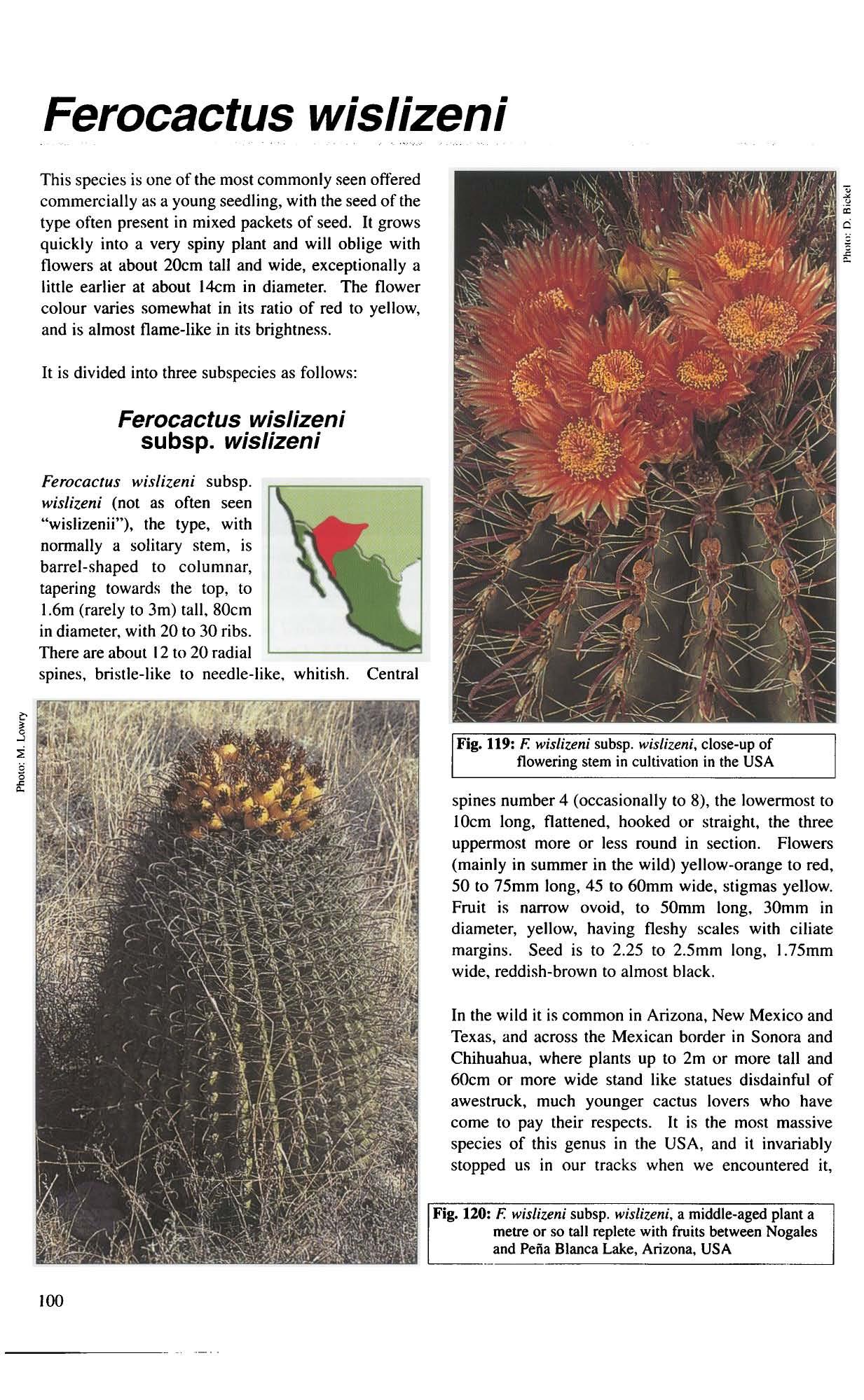
spines number 4 (occasionally to 8), the lowermost to IOcm long, flattened, hooked or straight, the three uppermost more or less round in section. Flowers (mainly in summer in the wild) yellow-orange to red, 50 to 75mm long, 45 to 60mm wide, stigmas yellow. Fruit is narrow ovoid. to 50mm long. 30mm in diameter, yellow, having fleshy scales with ciliate margins. Seed is to 2.25 to 2.5mm long, I.75mm wide,reddish-brown to almost black.
In the wild it is common in Arizona. New Mexico and Texas, and across the Mexican border in Sonora and Chihuahua, where plants up to 2m or more tall and 60cm or more wide stand like statues disdainful of awestruck. much younger cactus lovers who have come to pay their respects. It is the most massive species of this genus in the USA, and it invariably stopped us in our tracks when we encountered it.
Fig. 120: F. wislizeni subsp. wislizeni. a middle-aged plant a metre or so tall replete with fruits between Nogales and Pena Blanca Lake. Arizona. USA
demanding the sort of respect that is so seldom these days afforded to the extremely elderly.
Reported in the USA, from TEXAS, NEW MEXICO and ARIZONA; and in Mexico, from CHIHUAHUA and SONORA; specifically in the USA, from TEXAS, EI Paso; from NEW MEXICO, Paso del Norte, Organ Mountains west Mesa, Mesilla Park, Rincon, Floridas; from ARIZONA, Stoval, Tucson. Florida Canyon, Fresnal north in the Baboquivari Mountains, Redington Pass Santa Catalina Mountains, Coyote Mounrains, Gila Bend. Camp Bowie. Benson, Dudleyville, Florence, Sacaton, Coolidge Dam, Guthrie; in Mexico, from CHIHUAHUA. Guzman See; from SONORA, Hermosillo, Tetas de Cabra/San Carlos
Bay; at 40-1,750m altitude,
often in nat, sandy areas.
2025 (OS, SO), Lindsay 2554 (OS, SO); Wiggins 8642, 8725 (OS); Palmer 72, 73 (Mo); Cutler 1072 (Mo); Benson 9848, 9976, 9988 (POM), 16637 (POM 311316); Benson 9745 (POM, ARIZ); Rothrock
492 (Mo); Trelease without no,
(Mo); Tourney without no. (US, UC); Graham 7-26-1 (UC); Leding S. F. 8 (Ariz.); Dr. Bigelow No. 12 (Mo); Wooton & Standley 3204 (Ariz.); Standley 565 (Mo); Jones
without no, (POM). Jones
without no. (CAS, UC, POM, Ariz.); Mulford 1038 (Mo); Lt.
Kribber without no, (Mo);
Pringle6875 (US, MO, POM,
MEXU); Dawson without no,
(AHFH); Lau 1404; Rep. 568, 571, I554a, 2115b; SB 50, 228, 1828; DJF 1387, 1390, 1635; AG30.

Synonyms: Echinocactus wislizeni, F. arizonicus, F. falconeri, F. phoeniceus, F. wislizeni var, albispinus, F. wislizeni var, phoeniceus
Section Ferocactus F. robustus group
Ferocactus wislizeni (Engelmann) Britton & Rose, The Cact. 3:127-128, pl.1 & 12.2, fig. 1310 (/922); Engelmann in Wislizenus, Mem. Tour Nonh, Mex. 96, in adnot. (1848); & Cact. Mex. Bound. pl.26, 26 (1859); Nose, Kakt,u,a,Sukk. 25(10):236-7 (1974); L. Benson, Cacti US & Canada 693-698, figs. 728-736, eol.pl.l22 (/982); N. P. Taylor. Bradleya 2:34-35 (1984); Unger. Die gro,\'sen Kugelkakt, Nordamer. 139-155 (/992); Lindsay, Femeaetu.' 169-191, 209, 417, 444 (/996) (1955 thesis, unpublished at the time); E. F. AmJerson, The Cactus Family 336 (200/)
The first of lhe fullowing two subspecies. subsp. herrerae. is often seen in cultivation labelledquite erroneously F. horridus. but the second. subsp. tiburonensis, is seldom seen, no doubt because of its isolated island occurrence. 80th represent significantly different looking plants from the type. and are geographically separate. Although Taylor does not elevate them to subspecies he provisionally accepts them in the CITES Cacraceae Checklisr (1999). As they are distinctive collectors' plants worth seeking out, and because of their separate geographical occurrence we are happy to place them hereunder as subspecies.
Ferocactus wislizeni subsp. herrerae
This subspecies as indicated above is sometimes also piclUred in books and seen in cultivation under the misnomer F. horridus. a name properly applied 10 a form of F. penim;ulae, originally collected on the other side of the Gulf of California from subsp. herrerae, at San Francisquito Bay in Baja California, with noticeably long central spines, to 12cm long!
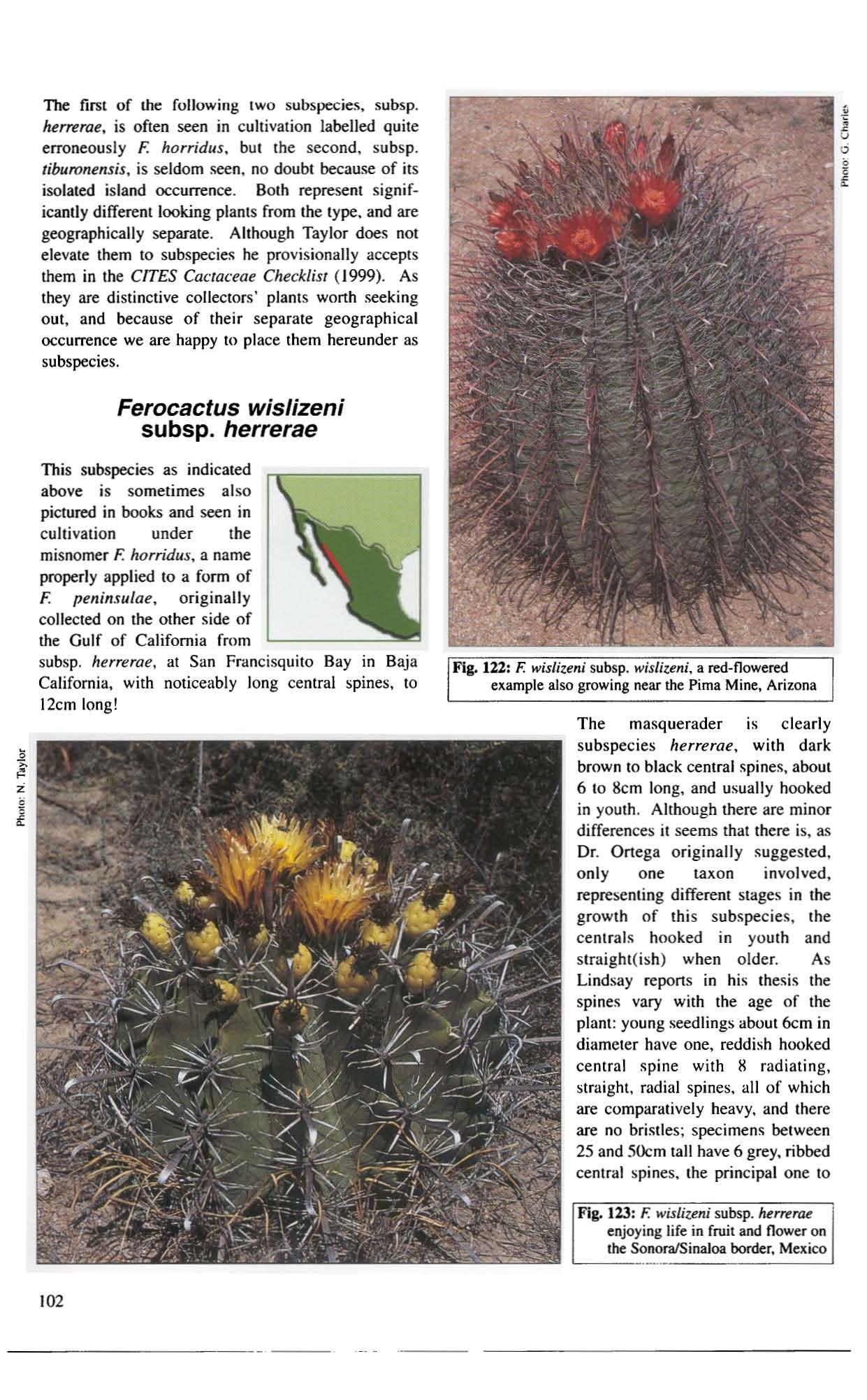
The masquerader is clearly subspecies herrerae. with dark brown to black central spines, aoom 6 10 8cm long, and usually hooked in youth. Although there are minor differences it seems that there is, as Dr. Ortega originally suggested, only one taxon involved, representing different stages in the growth of this subspecies, the centrals hooked in youlh and straight(ish) when older. As Lindsay reports in his thesis the spines vary with the age of the plant: young seedlings about 6cm in diameter have one. reddish hooked central spine with 8 radiating, straight. radial spines. all of which are comparatively heavy. and there are no bristles; specimens between 25 and 50cm tall have 6 grey. ribbed central spines. the principal one to
IOcm long. flattened and curved or hooked at the tip, and a series of twisted white bristles; in specimens over 50cm tall the main central spine is straight, not flatlened. and the radial bristles are few or often lacking altogether.
In 1984 Nigel Taylor listed this taxon as a variety of F. wislizeni, but in the latest CITES Cactaceae Checklist (1999) it is regarded as a provisionally accepted species (i.e. neither accepted as a good species nor a subspecies for sure). Anderson (2001) lists it as a species. adding thaI it "is closely related to F. wislizeni". We regard it here as a subspecies of F. wisli'leni because of its close resemblance to that species, and think it distinct enough to be regarded as a worthwhile collector's plant.
In cultivation subsp. herrerae is a handsome plant, making a large. robust. bright green stem. with contrasting dark brown to black spines (very short spinedplants are sometimes seen).
It was described as globular at first later cylindric and sometimes with notably spiralling ribs, 2m tall, 45cm in diameter. with 13 ribs (far fewer than the type). at first squat. later more prominent There are 8 strong radial spines, at first reddish. later greyish white. about 3cm long. There is one central spine. straight and not flattened in maturity. in youth often curved at the tip, and sometimes hooked, about 3cm long; there are also 8 outer thin, wispy bristles, to 3cm long. sometimes not present on older plants. Flowers are funnel shaped, to 7cm wide. yellow, with broad red midstripe. Fruit is 4 to 6cm long, 2.5 to 3cm wide, greenish-yellow, fleshy. Seed is 2 to 2.25mm long, 1.5mm wide. black or dark brown, rather angular.
Reported from Mexico, the coastal plains of the state of SINALOA. south-western SONORA, and the mountains of western DURANGO; specifically from SINALOA, a band of about IOkm along the coast from Mazatlan to Ahome. and rocky hills and nats not far from the highway, Topolobampo, Pericos, Sianori, Empalme, Guasimas and Hermosillo, An gOS( u ra/G uam uc h i I. Bacuberito, EI Fuerte, Los Mochis. between Mazatlan and Los Mochis, Pericos, Ahata. San Bias, Guamuchil; west DURANGO, coastal plains and western slopes of the Sierra Madre Occidental; from SONORA, Guaymas. Obregon, EI Peon, Potam near Yaqui Valley, 23km W of Alamos, 82km S of Navojoa, Ciudad Obregon, Guasimas, El Peon near Guasimas, N of Vicam. Agiabampo; near sea level to 1,400m altitude on coastal plains and on hillsides. Field collection numbers referred here are: the type. J. G. Ortega without no. (MEXU); Schwan 229 (OS); Brandegee without no. (Ue); Jones 22%7 POM); Lindsay 2219,2556,2557,2560,2562, 2563 (some as F. wislizeni) (OS, SO); Rep. 207b, 740a, 744a, 745a, 2106, 2118b; SB 1867.

Synonyms: F. herrerae. F. horridu.\' Hort. (misapplied)
Ferocaclus wisUzeni subsp. herrerae sial. no .... Basionym: F. herrerae J. G Onega, Mexico Forestal 5:53, 55. jigs. 1-4 (1927)
References:
N. P. Taylor, Bradleya 2:34 (/984); Rauh, Kakr. Stund. Beruecks. Morph. System. pl. 79.3 (1979); Lindsay, Ferocactus 187-191, 403 (/996) (/955 thesis, unpublished at the time),' Hirao, Colour Em:yd. Cacti 10, jigs, 26, 27 (1979); SalO, Cactus Handbook 99100, jigs. 873, 874 (19%); Hunt (ed.), CITES Cact. Checklist 205 (1999); E. F. Anderson. The Cactus Family 331 (2001)
Ferocactus wislizeni subsp. tiburonensis
Seed has been available commercially in recent years of this island subspecies. and plants raised have a different aspect from the type and subsp. herraae. lis individual appearance. long isolated occurrence. and Lindsay's clear exposition of the differences when he described it. encourage us to recognize it as a subspecies. Isla Tiburon, where it occurs, is off the coast of Sonora. a little above the centre of the Gulf of California, at about latitude N. It is a large island. but not frequently visited;
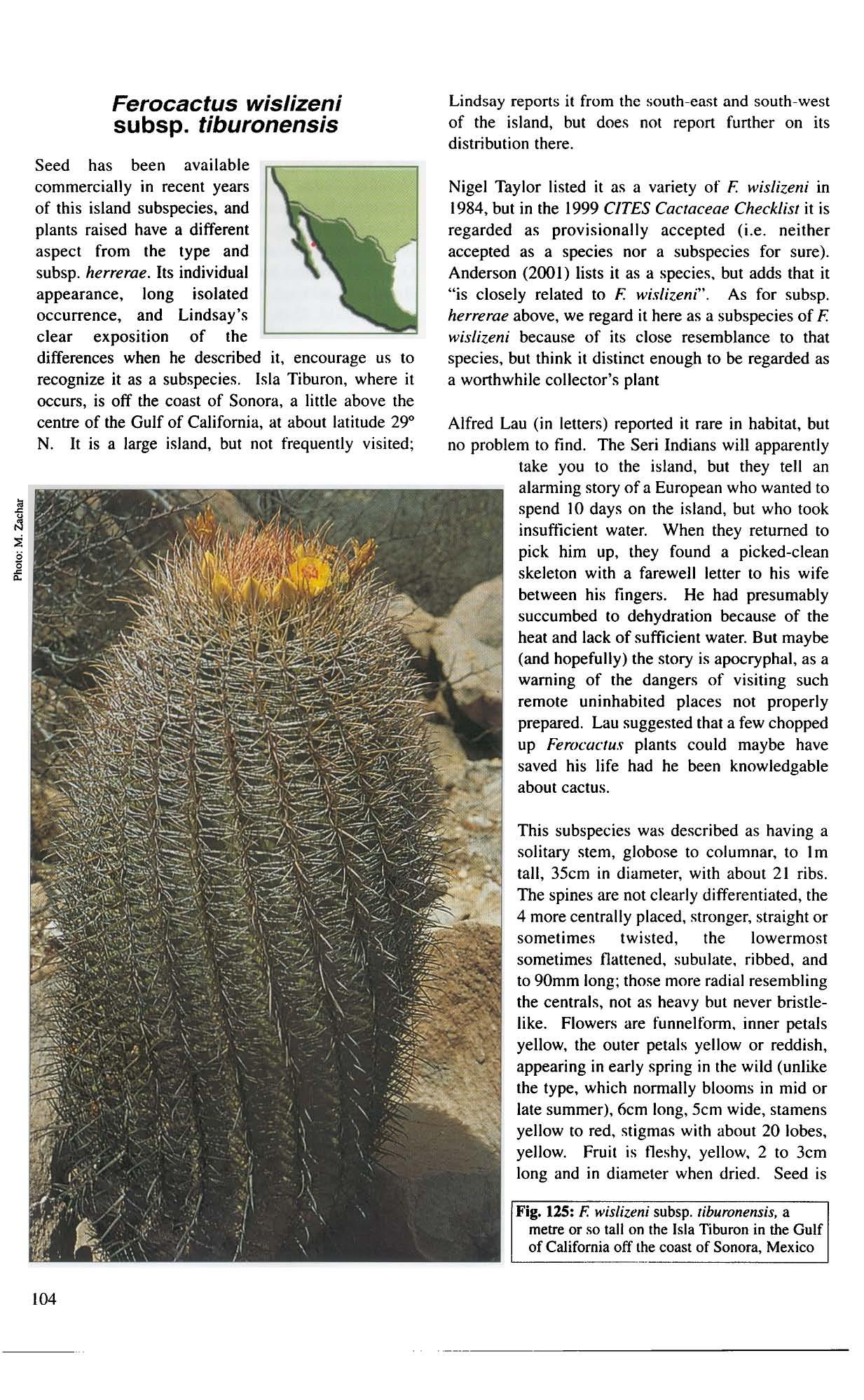
Lindsay reports it from the south-cast and south-west of the island, but does not report further on its distribution there.
Nigel Taylor listed it as a variety of F. wislizeni in 1984, but in Ihe 1999 CITES Cactaceae Checklist it is regarded as provisionally accepted (i.e. neither accepted as a species nor a subspecies for sure). Anderson (2001) lists il as a species, but adds Ihat it "is closely related to F. wislizeni". As for subsp. herrerae above, we regard it here as a subspecies of F. wislizeni because of its close resemblance 10 that species, but think il distinct enough 10 be regarded as a worthwhile collector's plant
Alfred Lau (in leiters) reported it rare in habitat, but no problem to find. The Seri Indians will apparently take you to the island, bUI they tell an alarming story of Do European who wanted to spend 10 days on the island, but who took insufficient water. When they returned to pick him up, they found a picked-clean skeleton with a farewell letter to his wife between his fingers. He had presumably succumbed to dehydration because of the heat and lack of sufficient water. But maybe (and hopefully) lhe SIOry is apocryphal, as a warning of the dangers of visiting such remote uninhabited places not properly prepared. Lau suggested that a few chopped up Feroc{Jc!uS plants could maybe have saved his life had he been knowledgable about cactus.
This subspecies was described as having a solitary stem, globose to columnar, to 1m tall, 35cm in diameter, with about 21 ribs. The spines are not clearly differentiated, the 4 more centrally placed. stronger, straight or somelimes twisted, the lowermost sometimes Oanened, subulate. ribbed, and to 90mm long; those more radial resembling the centrals, not as heavy but never bristlelike. Flowers are funnel form. inner petals yellow, the outer petals yellow or reddish, appearing in early spring in the wild (unlike Ihe type, which normally blooms in mid or lale summer), 6cm long, 5cm wide, stamens yellow to red, stigmas with about 20 lobes, yellow. Fruit is neshy, yellow, 2 to 3cm long and in diameler when dried. Seed is
large, 2.5mm long, 1.75mm wide, black. Lindsay emphasized the differences from the type particularly in its spring tlowering, the colour of the Oowcrs und the character of the spines.
Reported from Mexico, BAJA CALIFORNIA. in the Gulf of California, on Tiburon Island in the soulh; at 10200m altilUde.
Field collection numbers referred here are: the type, Lindsay 2229 (DS). from Ensenada Perro on the south·easl corner of Tiburon Island; a monochrome photograph of it in habitat appeared with the original descriplion. Other collections from this locality were made in 1921 by Dr. I. M. Johnston, a botanist on the California Academy of Sciences expedition to that island in that year, no.4270 (CAS) from the south-east corner. and no.425 1 (CAS) from 3 miles N of Willard's Point; the fonner of these two. according to Lindsay, was a particularly heavily armed plant with coarse, tortuous, sirongly-ribbed spines up 10 9cm long. and it provided material from which the descriplion of the fruit and seed was made; also collected by Alfred Lau as Lau 1525.
Synonym: F. tiburonensis. F. x tiburonensis Feroc:ac:tus wislizeni subsp. tiburonensis stat. nOli. Basionym: F. wislizeni V(lr. tiburonensis G. Lindsay, Caet. Succ. J. (US) 27(6): 166·167.fig./55 (/955)
References:
N. P. Taylor, Bradleya 2:35 (1984): Lindsay, Feracacrus 175-/77. /85-/86. 209 (/996) (/955 the...is, unpublished at the time); E. F. Anderson, The Cactus Fmnily 335 (2001)





